DECARBONIZATION INDUSTRY SPOTLIGHT PROFILE
Is net-zero by 2050 too great a challenge?
ELECTRIC VEHICLES
A look behind the scenes of product management.
Growing demand in US markets, says Myra Pinkham. Since
We talk to Sarah Hornby, president of Global Strategic Solutions.
ARE WOMEN CHANGING THE FACE OF STEEL?

www.steeltimesint.com Digital Edition - February 2023 - No.25
1866
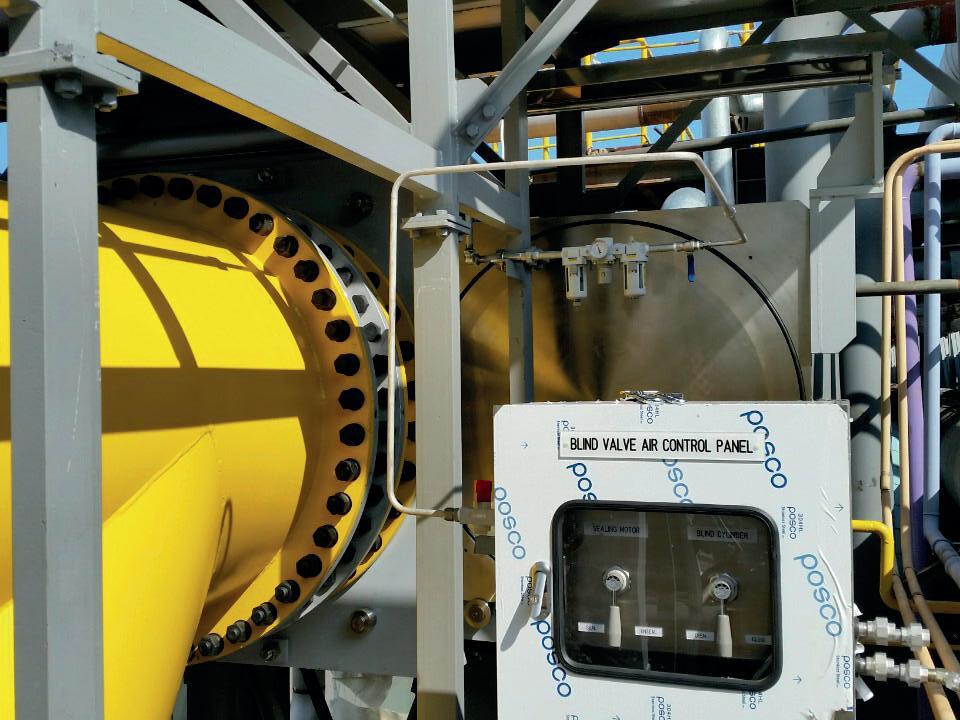


EDITORIAL
Editor Matthew Moggridge
Tel: +44 (0) 1737 855151 matthewmoggridge@quartzltd.com
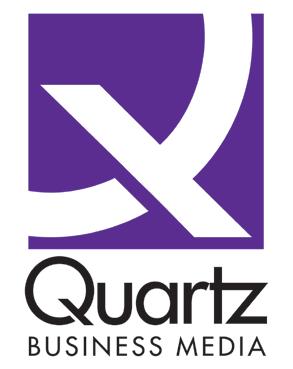
Editorial assistant Catherine Hill

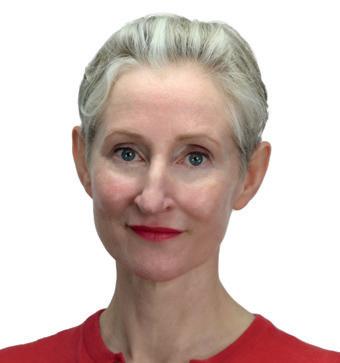
Tel:+44 (0) 1737855021
Consultant Editor
Dr. Tim Smith PhD, CEng, MIM
Production Editor Annie Baker
Advertisement Production Martin Lawrence

SALES
International Sales Manager
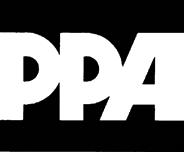
Paul Rossage paulrossage@quartzltd.com
Tel: +44 (0) 1737 855116
Sales Director

Ken Clark kenclark@quartzltd.com

Tel: +44 (0) 1737 855117
Managing Director Tony Crinion tonycrinion@quartzltd.com
Tel: +44 (0) 1737 855164
Chief Executive Officer


Steve Diprose
SUBSCRIPTION
Jack Homewood subscriptions@quartzltd.com Tel +44 (0) 1737 855028
1 www.steeltimesint.com
FEBRUARY
DECARBONIZATION INDUSTRY SPOTLIGHT Since 1866 ARE WOMEN CHANGING THE FACE OF STEEL?
ISSN0143-7798 Front cover photo courtesy of KOCKS CONTENTS – DIGITAL EDITION
2023
12 times a year (including four digital issues) and is available on subscription. Annual subscription: UK £215.00 Other countries: £284.00 2 years subscription: UK £387.00 Other countries: £510.00 3 years subscription: UK £431.00 Other countries: £595.00 Single copy (inc postage): £47.00 Email: steel@quartzltd.com Published by: Quartz Business Media Ltd, Quartz House, 20 Clarendon Road, Redhill, Surrey, RH1 1QX, England. Tel: +44 (0)1737 855000 Fax: +44 (0)1737 855034 www.steeltimesint.com Steel Times International (USPS No: 020-958) is published monthly by Quartz Business Media Ltd and distributed in the US by DSW, 75 Aberdeen Road, Emigsville, PA 17318-0437. Periodicals postage paid at Emigsville, PA. POSTMASTER send address changes to Steel Times International c/o PO Box 437, Emigsville, PA 17318-0437. Printed in England by: Pensord, Tram Road, Pontlanfraith, Blackwood, Gwent NP12 2YA, UK ©Quartz Business Media Ltd 2023 2 Leader by Catherine Hill. 4 News round-up Six pages of global steel news. 12 Innovations New products and contracts. 20 Future Steel Forum 2023 Details of the upcoming Forum. 22 Innovations Special Metal tags with InfoSight. 24 Electric vehicles Driving toward the green. 29 Decarbonization The decade of delivery. 36 Profile: Sarah Hornby Breaking the rules. 40 Industry spotlight: Ametek Changing tradition. 44 Furnaces Advances in reheating furnaces. 48 Software Developing the future. 51 Decarbonization Pedal to the metal. 60 Perspectives Q&A: HWI Industry renaissance. 62 Book review Women in steel, Women of steel. 36 48 48 60 40
Fax +44 (0) 1737 855034 Steel Times International is published
Changing the face of steel

‘What is the problem with men’, opens a recent article in The New Yorker, which details the conditions besetting the male population; stagnation in wages, climbing opiate addiction, increased diagnosis of ADHD, and high university dropout rates.
‘’As far as I can tell, nobody predicted that women would overtake men so rapidly, so comprehensively, or so consistently around the world,” writes Richard V Reeves. What is to blame? Erik Hurst, an economist at the University of Chicago, thinks that the rapid improvement in video-game quality could account for much of the especially deep drop in work among younger men.
Economists Marianne Bertrand and Jessica Pan believe that ‘boys raised outside of a traditional family’ are set up for failure. One thing is clear, however, that change is already on its way.
exist as an amalgamation of the most male dominated workforces according to data from Eurostat: manufacturing, construction, mining, and transportation.
With its transition toward a more sustainable future, it is resultingly drawing in a younger, more liberal crowd; and a diversified workforce is imperative to both incentivise its progress, as well as sustain the changes that have already taken place.
Catherine Hill Editorial assistant catherinehill@quartzltd.com
Women are increasingly taking up space in roles that were previously only available to their male counterparts–images of a ‘blue-collar’ workforce are shifting toward diversified labour pools. The steel industry serves as a microcosmic example of tradition transformed; as its primary and secondary suppliers
As more women graduate in STEMrelated fields, there is greater opportunity to hire labour that drives statistics that companies feel proud to present, rather than forced to justify. In this sense, even those set against change are inclined to see its potential-new voices offer new ideas. Every editorial feature in this issue is either written by a woman, has a female lead-author, or, in the case of Tim Smith’s book review (page 62) is regarding a book based on women in the industry. It is imperative to drive these voices forward until they can be heard. Whatever the problem is, the solution lies in futures that are undetermined by gender, and uplifted by talent, creativity, and passion enough to leave a mark.
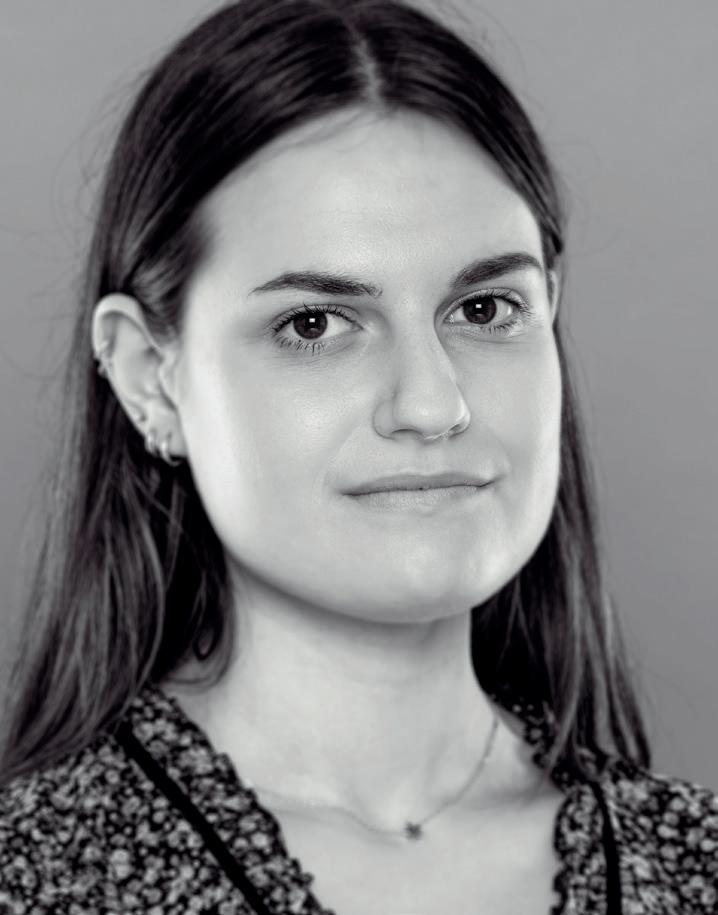
2 www.steeltimesint.com LEADER
Digital Edition - February 2023
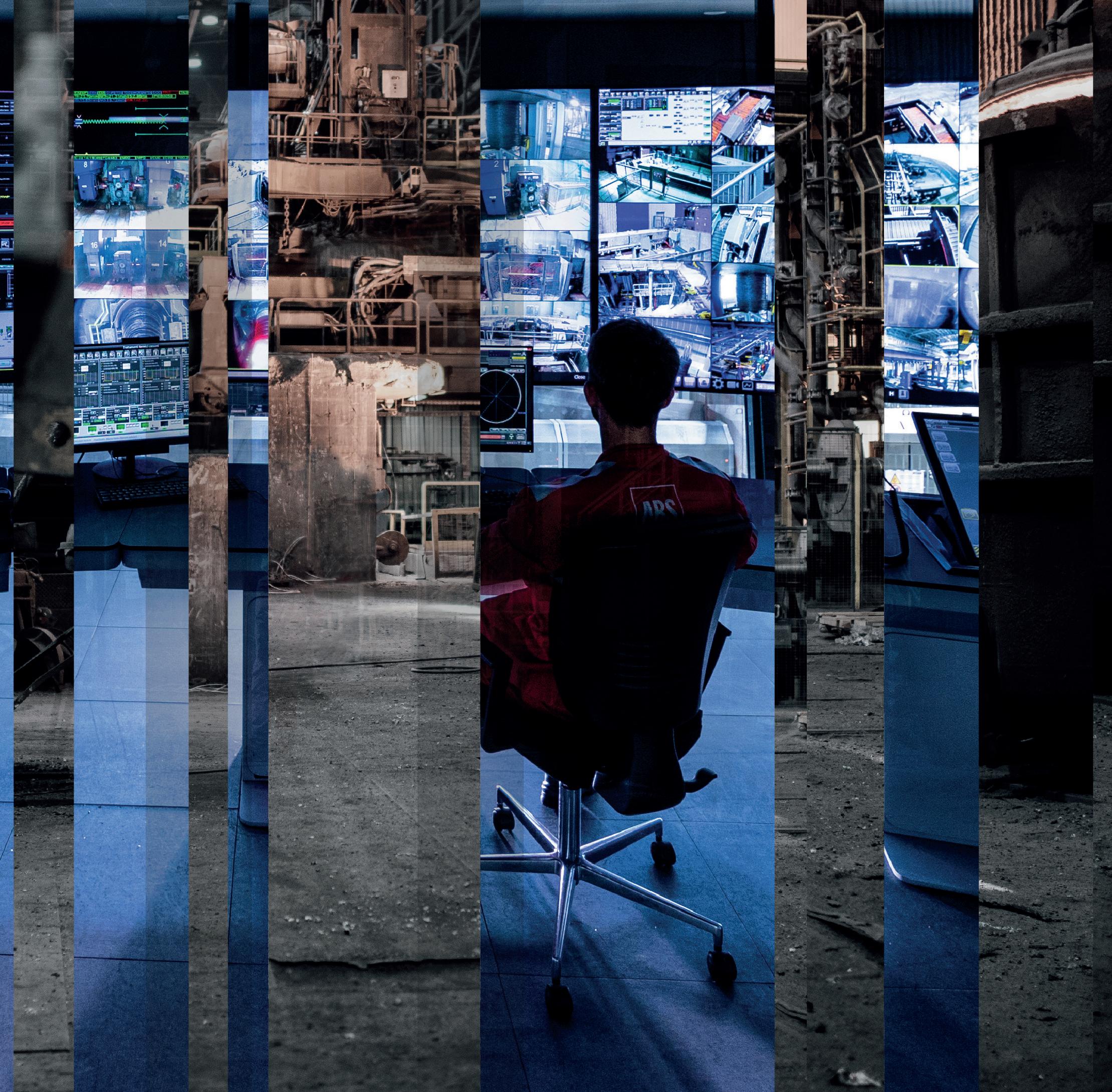

DANIELI INTELLIGENT PLANT A NEW CONCEPT FOR PLANT AND PROCESS SUPERVISION Data-driven approach, AI and machine learning for continuous improvement of plant performances, simplifying metals complexity Via Bonaldo Stringher, 4 33042 Buttrio (UD) Italy Phone +39 0432 518 111 www.digi-met.com www.dca.it Follow us on Linkedin
ArcelorMittal has announced plans to supply steel service centre EMW Stahl Service with low-emission steel as well as certificates for CO2 savings. EMW will receive low-carbon steel from ArcelorMittal Commercial Germany under the ‘XCarb’ umbrella brand. The steel is produced from 70% scrap, with production powered by 100% renewable electricity.
Source: Kallanish, 5 January 2023
UK environmental activist group Friends of the Earth is filing legal claims against the British government, saying that it did not factor in the climate impacts of the controversial Cumbria coal mine, which was approved for construction at the end of last year. West Cumbria Mining has been seeking to build a colliery on 689 acres near Whitehaven since 2017. The mine would be used to aid in the production of steel and not in generating power. Friends of the Earth lawyer Niall Toru described the approval of the mine as ‘the wrong decision for our economy and the climate’.
Source: North West Place, 6 January 2023
China is looking to invest in Western Africa’s Simandou iron ore mine, located in the Simandou mountain range of southern Guinea's Nzérékoré Region, to secure further supply of iron ore for steelmaking. The mine is said to have the world’s largest untapped high-quality reserve but has remained undeveloped because there is no railway line to transport the ore. Baowu, China’s biggest iron and steel producer, is among those investing in the project at a time when the country is trying to diversify its supply.

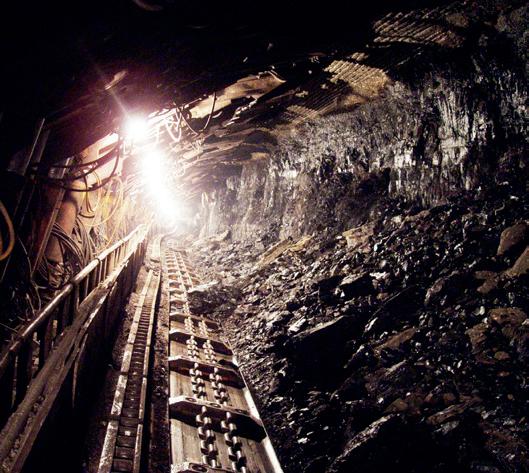
Source: South China Morning Post, 8 January 2023
Russian-Belgian strip producer NLMK La Louvière aims to restart rolling operations following a temporary shut-down after a fire broke out within the facility. The fire impacted the finishing stand, prompting the plant to announce a force majeure on its deliveries. La Louvière is located 50 km south of the Belgian capital of Brussels. The plant can roll up to 1.68Mt/yr of hot rolled coil.

Source: NXT Mine, 9 January 2023
The Philippines is expecting up to $2 billion in investments from China to ‘rebuild’ its steel industry, as part of 14 agreements that Philippine President Ferdinand Marcos Jr. signed during his state visit to China in early January
2023. Other areas covered in the agreement included agriculture, infrastructure, tourism and trade. According to Philippine ambassador Jaime Florcruz, the country expects Chinese investments to the amount of $1.5-2 billion to build a ‘state-of-the-art’ steel plant, creating 2,000 to 3,000 jobs.

Source: GMK Center, 9 January 2023
Zaporizhstal, one of the largest steel companies in Ukraine, reduced its steel production by 2.6 times – or by 2.4Mt in 2022 to 1.49Mt, according to a report by the Ukrainian News Agency. "The decrease in production level compared to the same period last year is associated with a shortage of raw materials and logistical problems caused by full-scale military actions in Ukraine. In addition, due to massive missile attacks on energy infrastructure facilities and, as a result, a power shortage in the power system, the plant reduced production, thus reducing the consumption of purchased electricity," the report said.


Source: Ukranews, 9 January 2023
Italy’s government has approved a new ‘urgent measure for strategic national installations order’ to inject €1 billion into steelmaker Acciaierie d’Italia (ADI), a joint venture between steel company ArcelorMittal and the state, formerly known as Ilva. The company is currently facing a liquidity crisis as a result of accumulated debt from suppliers. The aid will be divided into two instalments, the first of which will amount to €680 million, and the second – to €320 million.
Source: GMK Center, 9 January 2023

4 NEWS ROUND-UP













Alexey Mordashov, the chairman of the board of directors of Russian steel and mining company Severstal, topped the list of the most ‘impoverished’ Russian billionaires in 2022 with his wealth falling by $11.1 billion to $18.4 billion due to the impact of Western sanctions, the Russian edition of Forbes reported. In 2021, Mordashov and his family were named the richest Russians by Forbes, with their fortune estimated at $29.1 billion.
Source: Urdu Point, 10 January 2023
The United Arab Emirates' renewable energy company Masdar has signed a memorandum of understanding (MoU) with four Dutch companies to explore exporting green hydrogen from Abu Dhabi to Europe. Masdar signed an MoU with Port of Amsterdam, SkyNRG, Evos Amsterdam and Zenith Energy to join efforts to develop a green hydrogen supply chain that focuses on production in Abu Dhabi and exporting green hydrogen
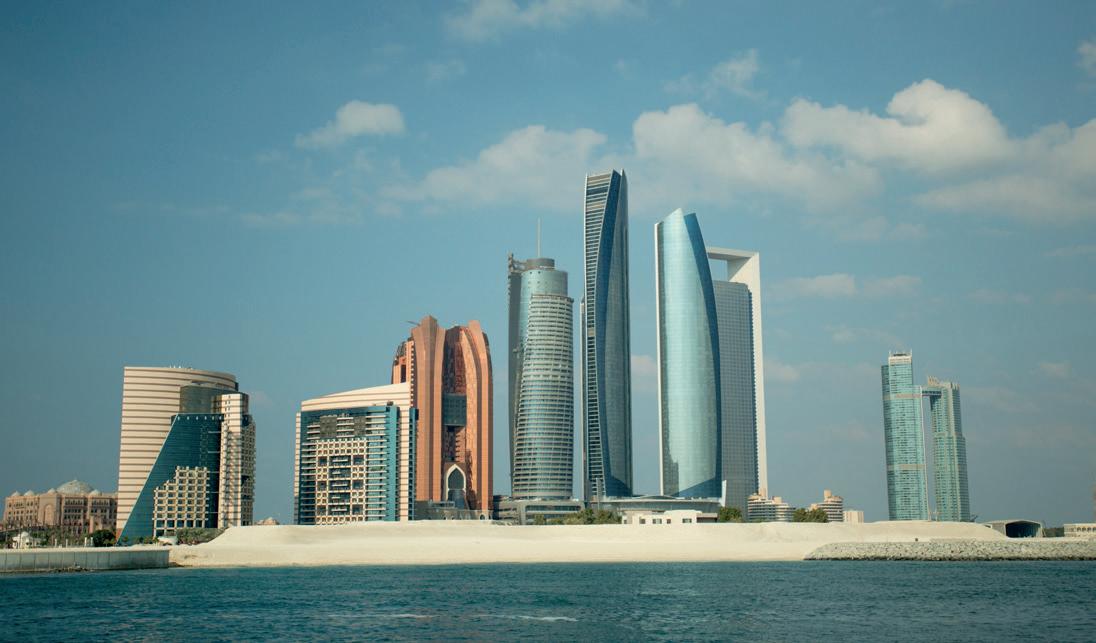
According to the prime minister of Kazakhstan, the government is ready to support the development of the domestic iron and steel industry and is preparing to implement ‘constructive business proposals’. The iron and steel sector's share in the national GDP is 8.5%. In 2022, the industry launched 19 new investment projects worth over $502 million, creating 3,500 permanent jobs. The Kazakh government is planning to take measures to expand the country’s mineral and raw material base and introduce a single online platform for mineral mining companies.

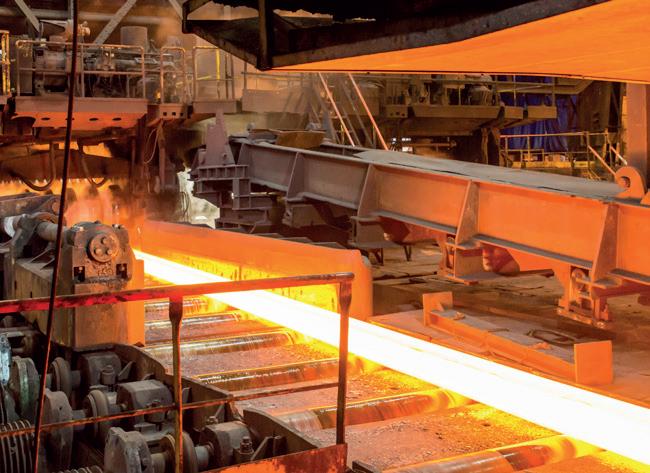

Source: GMK Center, 12 January 2023
to the Netherlands through the port of Amsterdam. The signing parties are aiming to explore several hydrogen transportation methods, with a focus on liquid organic hydrogen carriers and liquid hydrogen, the company statement read.
Source: Reuters, 13 January 2023
The companies of billionaire iron-ore magnate Andrew Forrest and giants of the global steel and oil sectors are among the companies allocated government land in Western Australia’s Pilbara region, to develop green industrial projects worth an estimated $70 billion. Western Australia’s Labour government announced the land allocation for seven projects in the Boodarie and Ashburton North Strategic Industrial Areas (SIAs), established to help transform the Pilbara into a ‘green industry hub’.

Source: Renew Economy, 12 January 2023
British Steel is preparing to commission its largest single investment since Jingye took over the company – a £54m billet caster, part of an investment worth £330 million that the company has been committed to since 2020. Other significant recent investments include: three new cranes worth £27 million at the company’s Immingham Bulk Terminal; a £14.6m investment to enhance energy operations; and an IT systems upgrade. Xifeng Han, British Steel’s CEO, said: ‘‘To make sure we can deliver the steel Britain requires, we’re undergoing the biggest transformation in our 130year history.’’
Source: Lincolnshire Today, 13 January 2023
Scientists from China claim to have created a new kind of steel that is ‘ultrastrong, yet stretchable.’ According to researchers, the newly-found ductile metal can stretch by 18 to 25%, and support the weight of a two-tonne automobile on a piece of steel no larger than a fingernail. The group from Northeastern
University in Shenyang, Shenyang National Laboratory for Materials Science and Jiangyin Xingcheng Special Steel Works in eastern China, as well as the Max Planck Institute for Iron Research in Germany, issued their findings in a peer-reviewed journal.
Source: WION, 14 January 2023

6 NEWS ROUND-UP
When you need to know it’s safe
Metal is the backbone of our society. It’s in the structures we ride, work and live on every day. That’s why you’ve trusted the detection technology inside every ARL iSpark for over 80 years to ensure every piece of steel and metal you produce is safe. With so much riding on that, why would you choose anything else?

* ARL iSpark. The trusted standard.
on a data comparison, completed by Thermo Fisher Scientific in 2021, of detection limits for OES systems using data published in specifications and applications notes for ARL iSpark and competitors. ©2022 Thermo Fisher Scientific Inc. All rights reserved. All trademarks are the property of Thermo Fisher Scientific and its subsidiaries unless otherwise specified. AD41408 0922 Find out more at thermofisher.com/ispark
*Based
International defence company, Babcock, has manufactured and fitted what are believed to be the first 3D printed metal parts to be used across the British Army’s active armoured fleets. The steel components were created specifically to tackle the growing challenges of technical and commercial obsolescence, and were fitted onto in-service fleets, forming part of the ‘periscope’ system to ensure Army crews have visibility of their immediate surroundings. This milestone is part of Babcock’s longerterm global advanced manufacturing investment programme – which is focused on developing the ability to print parts anywhere in the world, when needed.

Source: 3D Printing Media Network, 14 January 2023

A rare Second World War helmet of the type worn by a little-known section of the home front originating from Hull, northern England, is one of the highlights of an unusual auction, taking place this month. The steel ‘Brodie’ style helmet worn by civil defence mortuary volunteers is believed to be one of only three thought to have survived the Hull Blitz. It is going under the hammer at an ‘out of the ordinary sale’ by Sworders fine art auctioneers. A Sworders’ spokesperson said: “The helmet in our out of the ordinary auction is one of a handful of survivors that emanate from the Hull area.’’

Source: Hull Live, 15 January 2023
The Australian Steel Institute (ASI) has confirmed its call for a national ban on the export of unprocessed ferrous scrap. According to ASI executive director Mark Kane, Australia is now facing a situation where steel mills are importing processed ferrous scrap to meet growing demand for steel when they can use their own. Mark Kane stated that the export ban would free up an additional 800kt of recycled scrap on the domestic market, reduce greenhouse gas emissions in the industry, and help prevent coastal environmental damage from Australia’s landfill ban on unprocessed waste.
Source: GMK Center, 15 January 2023
The Metalfer Steel Mill in Serbia received a €21.4 million loan from the European Bank for Reconstruction and Development (EBRD) in order to decarbonize its production facilities, according to the EBRD. The loan will finance the construction of a new rolling mill for processing semi-finished products and scrap metal. Part of the funds will be directed to the construction of a mini-solar power plant that will produce 4MW of renewable energy to meet production needs.


Source: GMK Center, 18 January 2023
ArcelorMittal is considering restarting blast furnace A at its Asturias plant in Spain this month. The furnace will run at reduced capacity if restarted. The steel giant idled the unit at the end of September, in response to weak market demand and economic uncertainty. The Asturias plant has two blast furnaces and produces heavy plate, wire rod and rails.
Source: Argus Media, 18 January 2023
Steel manufacturer Metal One Corporation (Metal One) and power plant supplier Clean Energy Systems (CES) have announced an agreement to deploy CES' proprietary carbon capture technology to accelerate the decarbonization of the global steel industry. Metal One has made an initial investment in CES, and the parties will immediately work to promote the use of green steel across all industries, helping major corporations that have pledged to achieve net zero carbon emissions. ‘‘By partnering with Metal One with their global presence, we'll be able to access the global steel market exponentially faster than we could achieve on our own,’’ said Keith Pronske, president and CEO of CES.

Source: Cision, 17 January 2023
Schnitzer Steel Industries, a leader in metals recycling, has been named the most sustainable company in the world by Corporate Knights, a media and research organization focused on corporate sustainability performance. The 19th annual Global 100 List of the world’s most sustainable corporations by Corporate Knights is based on a detailed assessment of 6,720 companies, each with more than $1 billion in revenue, where performance across a range of sustainability metrics is evaluated.
Source: Business Wire, 18 January 2023

8 NEWS ROUND-UP
A joint venture between ArcelorMittal and Nippon Steel has received the Odisha government's approval for a $4.68 billion steel plant project. The project is expected to have an annual production capacity of 7Mt, and create 11,000 jobs. Earlier this month, ArcelorMittal and Nippon Steel launched the steel slag brand ‘Aakar’. The steelmakers have pioneered the technology for reusing steel slag, a by-product obtained during the primary steel manufacturing process, in the construction of roads and national highways.

Source: Mint, 19 January 2023
Nucor has introduced Elcyon, a new sustainable heavy gauge steel plate product made specifically to meet the growing demands of America’s offshore wind energy producers. Nucor will manufacture Elcyon at the firm’s new $1.7 billion Nucor Brandenburg steel mill in Kentucky, which produced its first steel plate at the end of December 2022. The new mill will be able to produce 97% of plate products consumed domestically, with a potential output of 1.2Mt/yr of steel, said Nucor. Elcyon is made using Nucor’s recycled scrapbased electric arc furnace manufacturing process.

Source: Offshore Wind.Biz, 19 January 2023
ArcelorMittal will receive direct aid of around €450 million for the transformation of its facilities in Asturias, Spain, after having received authorization from the European Commission for the Spanish Government to grant the steel giant the subsidy. It is expected that ArcelorMittal will use the money to relaunch activity at its plants in Spain, which has been impacted by low demand and imports from outside the European Union.
Source: The Corner, 23 January 2023
France-based pipe manufacturer Vallourec has announced that it will supply 25kt of line pipe for USbased oil and gas exploration company LLOG Exploration
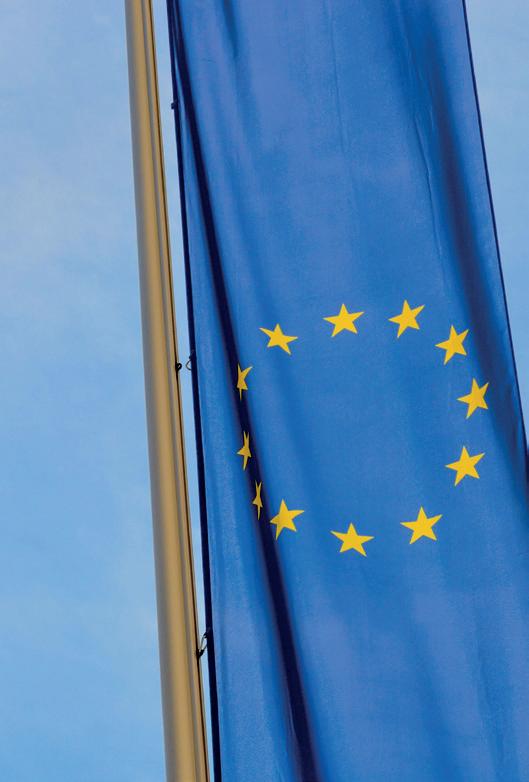
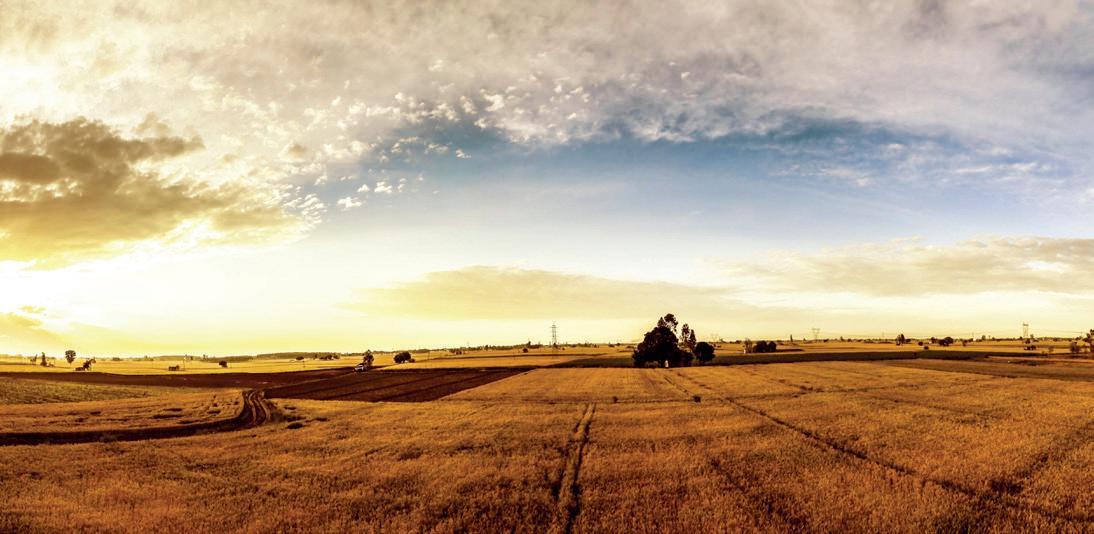
Offshore for the latter’s Salamanca deep-water project on the US coast of the Gulf of Mexico. The pipes will be produced at Vallourec’s Jeceaba mill in Brazil. The Salamanca development is based on a floating production unit created from the refurbishment of a previously decommissioned production facility.
Source: Steel Orbis, 23 January 2023
Tata Steel has begun construction of its scrap-based steel plant in Ludhiana, Punjab, announced the region’s chief minister, Bhagwant Mann. ''This is just the beginning as we deliver what we say and the day is not far when we will make Punjab a frontrunner state in the industrial growth across the country,'' Mann stated during a meeting with the representatives of the Tata group in Mumbai. According to the Punjab government, the project is the first ever investment made by Tata Steel in the state, and the second biggest in the country after Jamshedpur.
Source: Devdiscourse, 24 January 2023
Netherlands-based Hardt Hyperloop, a hyperloop network technology platform, has announced that it has secured new funding from trading corporation POSCO International and investment company Urban Impact Ventures with participation from existing EU- and US-based investors. The Dutch hyperloop company says it will use the capital to fund the construction of the European Hyperloop centre test facility in Groningen. The announcement comes over a year after being awarded €15M by the European Commission.
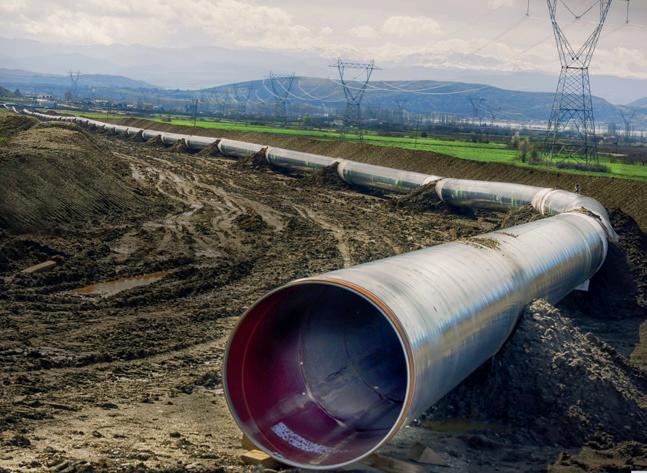
Source: Silicon Canals, 24 January 2023

www.steeltimesint.com NEWS ROUND-UP 9
Digital Edition - February 2023
AD Ports Group, an industry, trade and logistics facilitator, has signed a memorandum of understanding (MoU) with Tosyalı, one of Turkey’s largest private steel producers, which has operations in three continents. The MoU looks to establish the framework for AD Ports Group to collaborate with Tosyalı on a broad range of shipping, logistics, ports, and freight forwarding services, including potentially jointly investing in new port facilities to support its export operations.
Source: Zawya, 25 January 2023
Slovakian steelmaker US
Steel Kosice is resuming the operation of its three furnaces after having restarted blast furnace two – idled for 60 days of maintenance in September – this month,


meaning all its units are running. It had restarted blast furnace one, which it said would be idled at the start of December, a few weeks prior. The company has a crude steel capacity of about 4.5Mt/ yr across the three furnaces. Capacity is coming back online in response to rising coil prices and an increase in apparent demand, driven by service centre restocking since December.
Tata Steel has been recognised as a Global Diversity Equity & Inclusion (DEI) Lighthouse 2023 by the World Economic Forum (WEF). The company’s efforts towards improving

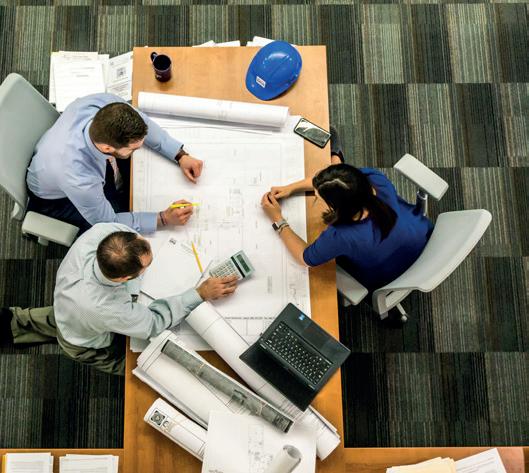
Source: Argus Media, 25 January 2023 gender diversity at the workplace have been chosen as one of the eight case studies which have been featured in the Global Parity Alliance: Diversity, Equity and Inclusion Lighthouses 2023 report published to coincide with the World Economic Forum 2023 held in Davos, Switzerland.
Source: Tata Steel, 27 January 2023
Korean steelmaker POSCO has launched a task force, led by vice chairman Kim Hagdong, for its steel operations, due to concerns that a global recession could slow demand. “Last year, we braced for the global economic downturn group-wide, following higher interest rates, a strong won and higher prices. This time, we launched a steel-specific task force to look into cost reductions, better profitability, and liquidity,” the steelmaker said. In September, POSCO’s Pohang plant was hit by Typhoon Hinnamnor, with a large part of the facility submerged by flooding. All of its steel plants were back in operation as of 20 January, 135 days after the flooding, but the steelmaker later declared an ‘emergency’ status as a result of the wider economic impacts.
Source: Pulse, 26 January 2023
A consortium of ArcelorMittal Nippon Steel India Ltd and Bothra Shipping Services has won a 30-year contract to mechanise and run two bulk cargo berths at the state-owned Visakhapatnam
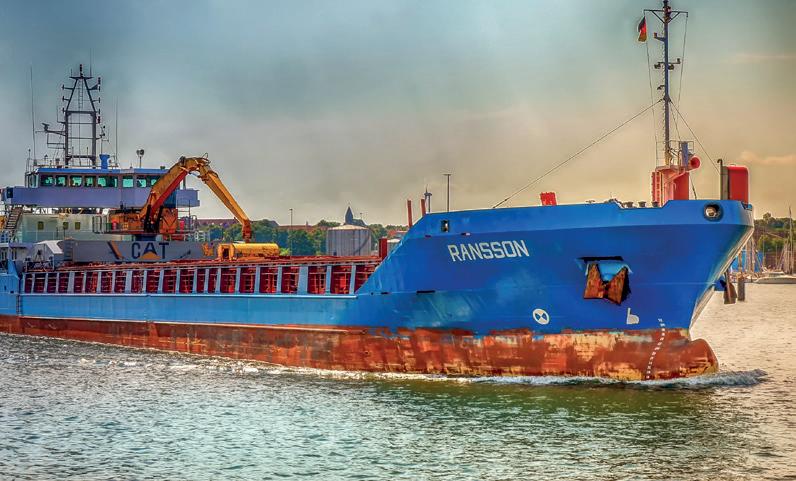
Port, officials said, as the steelmaker seeks to bolster its logistics chain to support manufacturing. “The letter of award for the project was issued to ArcelorMittal Nippon Steel-Bothra Shipping
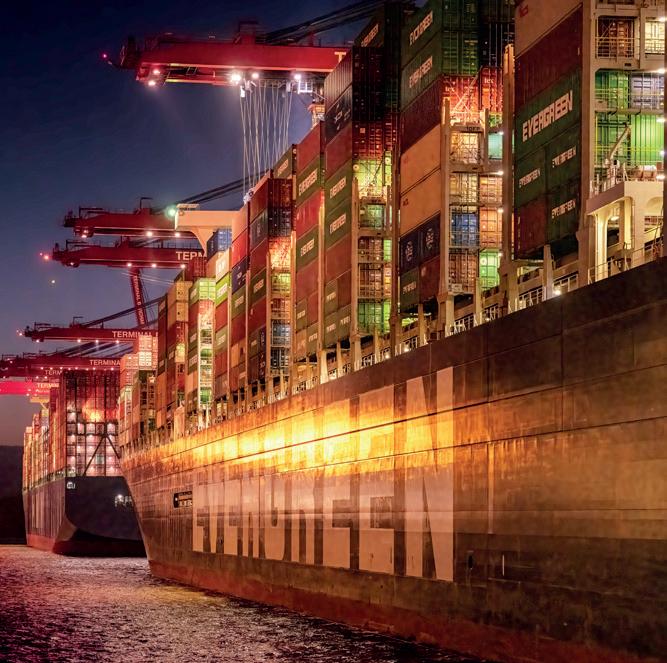
One of the only steel tube factories in the UK has said that it is shutting down before the evening energy peak to help prevent electricity shortages. Tata Steel’s Corby plant, located in Northamptonshire, has an electric furnace which uses the equivalent energy of 11,000 households, as well as a gas furnace for heating the steel. Plant manager Paul Ilko commented: "We've deliberately scheduled our operations to avoid those evening hours, because that's when the peak demand for electric is on the system,’’ adding that the plant, which has produced steel tubes for Wembley and the Millennium Stadium in Cardiff, is now only operating between 09:00 and 17:00. Source: yahoo!news, 30 January 2023
Services consortium after the bid was approved by the board of Visakhapatnam Port Authority,” the port official said.
Source: ET Infra, 28 January 2023
10 NEWS ROUND-UP
Danieli Group, an Italian plant supplier, has announced that it will provide Lucchini RS Group’s plant in Lovere, Bergamo, Italy, with a new open-die forging press. The new equipment will ‘improve Lucchini RS’s product portfolio, energy and raw-material optimization, and cost reduction’, says Danieli. The new equipment will be produced in Danieli workshops, and Lucchini RS Group will supply the components. It is expected to be put into operation by early 2024.
Source: Yieh Corp, 30 January 2023
Oil field services company Baker Hughes has announced a memorandum of understanding (MoU) with Fortescue Future Industries (FFI) to jointly explore potential opportunities for the scale up and adoption of novel technology solutions

for green hydrogen, green ammonia and geothermal projects. According to a press release, the companies see new pathways to accelerate the energy transition thanks to their respective expertise and portfolio of technologies on new projects. These technologies will potentially benefit the reduction of greenhouse gas emissions in both energy production and hard-to-abate industrial sectors including mining, steel and cement.
Source: Baker Hughes, 30 January 2023
In a presentation to investors, Indiana-based EAF steelmaker Steel Dynamics Inc. (SDI) said that its six scrap-fed mills emit 0.43 tons of CO2 per ton of steel made, placing it at less than half of the North American average of 1 ton and at less than onethird the global average of 1.7 tons. “Our steelmaking operations already meet the 2050 intensity targets under the Paris Agreement and its 2 degrees Celsius scenario,” the company stated in one of its presentation slides.


Source: Recycling Today, 30 January 2023
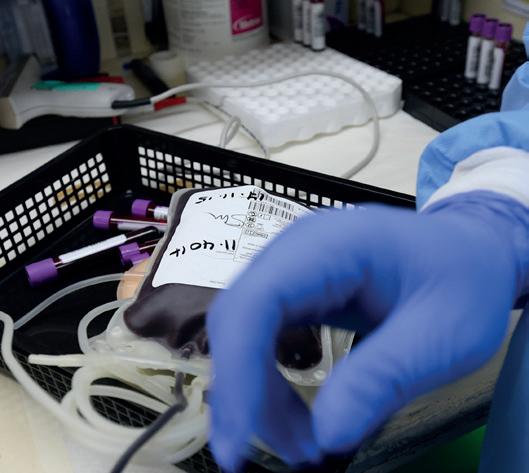

China is set to receive at least two cargoes of Australian coal in early February, according to traders and shiptracking data, the first since an unofficial ban on imports was lifted earlier this month. About 72kt of metallurgical coal was loaded on to bulk vessel Magic Eclipse at Hay Point,
Australia, and is expected to arrive at the southern Chinese city of Zhanjiang in Guangdong province shortly. China's largest steelmaker Baowu Group bought the cargo, according to a trader familiar with the deal and the shiptracking data.

Source: Reuters, 30 January 2023
A blood donation camp was organised by ArcelorMittal at its Thakurani iron ore mines located in Odisha, India, in collaboration with Keonjhar Blood Bank. A total of 50 units of blood was collected, with company officials, workers, operators and security personnel all participating. ArcelorMittal said that the objective of organising blood camps at regular intervals was to create ‘awareness amongst people on the importance of maintaining a healthy life.’
Source: Orissa Diary, 30 January 2023
APOLOGY: In a news story in the January/February edition of Steel Times International, Ford, Mercedes Benz, and BMW were listed as having collaborated with Kobe Steel. However, Nissan is the first carmaker that will use Kobenable Steel, commercialised by Kobe Steel, for mass-produced vehicles. We apologise to Kobe Steel for this error.
Indiana, USA, led the nation in steel production last year, accounting for nearly a fourth of the nation’s output. The state kept its spot as the top steel producer nationally. It has made more steel than any other state for more than four decades, said Lisa Harrison, senior vice president of communications for the American Iron and Steel Institute. “Over the past 12 months ending in November 2022, Indiana produced about 21.5Mt of steel,” she said.
Source: NWI Times, 4 January 2023
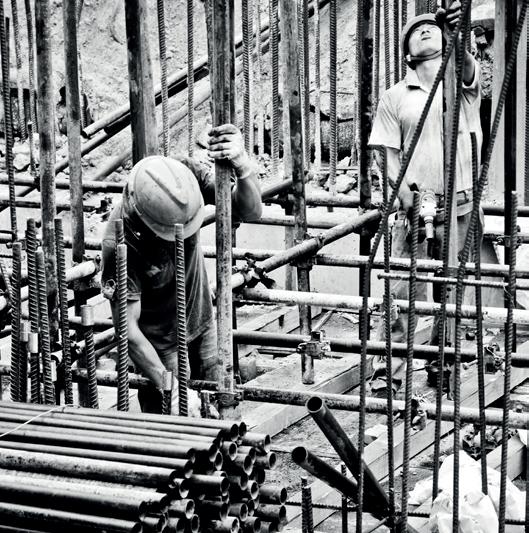
11 NEWS ROUND-UP
Schneider Electric partners with AVEVA and Shell
Schneider Electric, leader in the digital transformation of energy management and automation, AVEVA, an industrial software company, and Shell, a global energy and petrochemicals company, have formed a global strategic alliance to support their respective and wider sectors’ transition to net-zero agendas. The organisations will explore opportunities to co-develop integrated end-to-end energy solutions designed to power the decarbonization of their customers in hardto-abate industries.
Energy-intensive and heavy industry companies need trusted partners and solutions that can reduce greenhouse gas (GHG) emissions, increase the effectiveness of their operational processes, and deliver greater energy efficiency, security, resilience, availability and reliability, claims Schneider Electric. The partnership agreement between the three companies aims to bring customers an enhanced set of integrated solutions with a range, scale, and scope that is greater than each could offer alone.
Focusing on the cement sector initially, the newly formed alliance aims to reduce emissions by up to 15% for customers in a typical
deployment. The approach will focus on enabling a more efficient transition to renewable energy sources. More accurate process analytics, improvements to dynamic tactical simulation, and digital integration for furnace and mill grinding process improvements will drive a reduction in resource use.
AVEVA and Schneider Electric will contribute integrated digital engineering, operational process, and energy optimisation technologies, combined with deep sustainability expertise, to the alliance. These capabilities will support the design, construction, and more efficient operation of increasingly carbon neutral facilities. They will also help to create production plans that optimise the value chain and reduce GHG emissions.
Shell brings to the partnership end-to-end sustainable energy supply solutions, global project engineering capabilities, a large renewable energy generation and asset portfolio, as well as a broad range of sectoral sustainability solutions.
Harry Brekelmans, projects and technology director at Shell, said: “Our companies have strong ambitions to achieve net zero emissions. This partnership represents another significant
step forward. Shell, AVEVA and Schneider Electric intend to explore potential opportunities across digital solutions, technology, sustainability consulting, and energy supply capabilities to develop end-to-end integrated energy solutions to decarbonise our own businesses and wider sectors”.

Jean-Pascal Tricoire, chairman and CEO, Schneider Electric, said, “Partnerships are vital for decarbonization. They provide benefits to all parties and accelerate the global energy transition. The combined capabilities and expertise of Shell, AVEVA, and Schneider Electric will result in innovative sustainability solutions critical to the journey to net-zero.”
“We are pleased once again to extend our relationship with Shell,” said Peter Herweck, CEO, AVEVA. “We have already seen the benefits in terms of safety, reliability and efficiency with many previous successful engagements, and we will continue to deliver our vision of a responsible use of the world’s resources.”
For further information, log on to www.se.com
INNOVATIONS 12 www.steeltimesint.com Digital Edition - February 2023
Swiss steelmaker buys DigitARC® PX3 ERS
AMI Automation, an international automation and control solutions company based in Mexico, has supplied the DigitARC® PX3 ERS for a ladle furnace to Switzerland-based steel producer, Stahl Gerlafingen.
After the decision taken by Stahl Gerlafingen to upgrade its Electrode Regulation System as part of its secondary steelmaking process, AMI supplied the DigitARC® PX3 ERS which was delivered in May 2022, with all on-site commissioning work finished in mid-2022.
Start-up was carried out within the shortest possible time to minimize production downtime.
Stahl Gerlafingen, as a part of the Beltrame Group specializes in the supply of products for the construction, automotive, energy and heavy industries. Its 80-ton 11 MVA ladle furnace was updated with the objective to reduce electrode consumption, increase the heating rate and decrease ladle refractory wear.
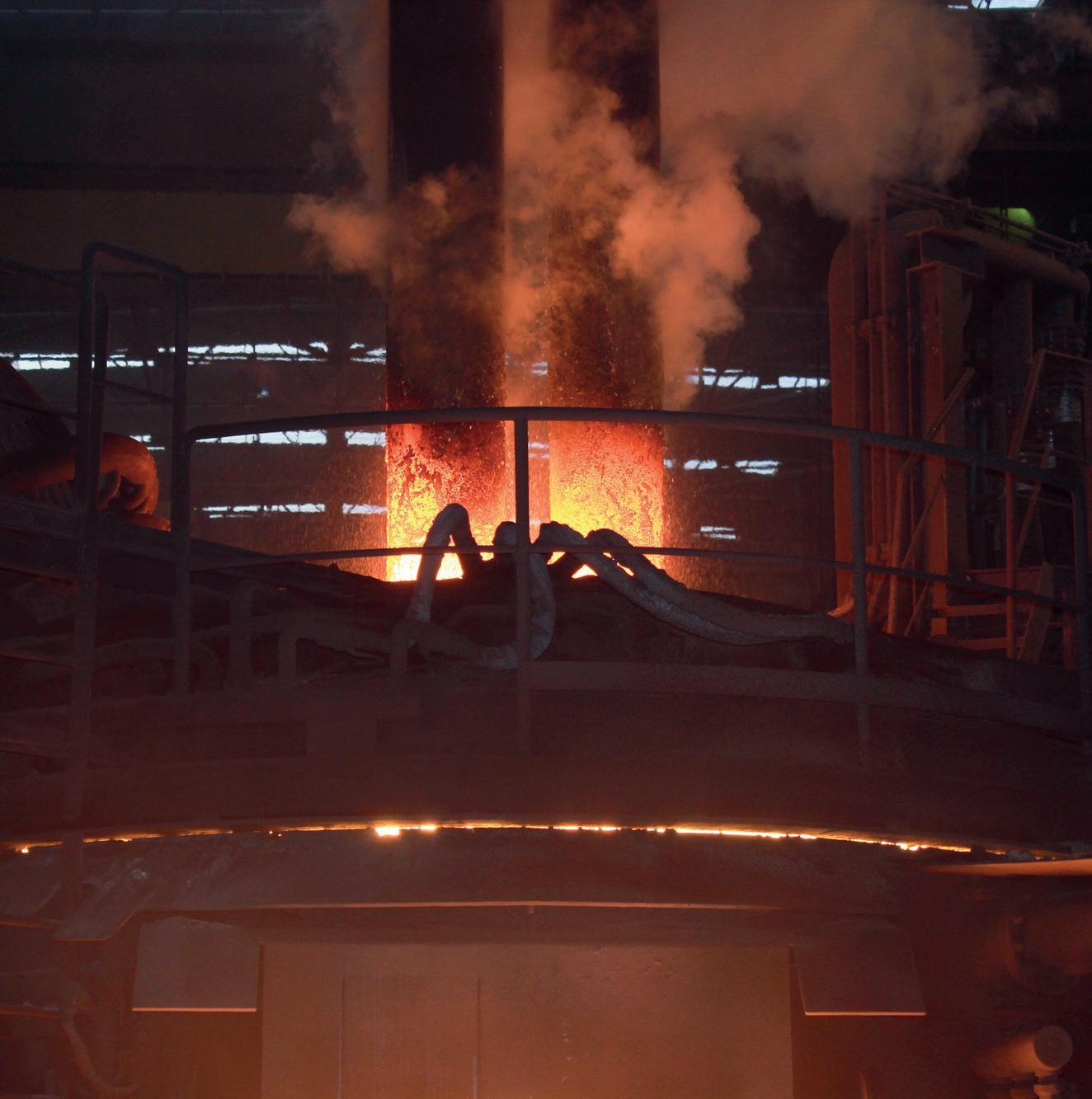
The transition from Z to I-Z regulation control took place as part of the improvements done
to the regulation system, looking for better arc stability and reducing electrode consumption by giving the right amount of energy to the steel being produced.
The interface includes a set of diagnostic tools and configurable screens to control almost every aspect of the furnace. This, claims AMI, allows customers to standardize the operation process.
For further information, log on to www.amiautomation.com
13 www.steeltimesint.com Digital Edition - February 2023 INNOVATIONS
ABB expands monitoring services
ABB, a global technology company, and Samotics, a high-growth scale-up company based in the Netherlands, have entered a strategic long-term partnership to provide enhanced condition monitoring services. The approach will leverage each company’s capabilities to deliver more insight into machine health and energy efficiency. As a first step, ABB will integrate Samotics’ plug-andplay monitoring solution into its digital portfolio.
Samotics’ technology is complementary to the well-established ABB Ability™ Condition Monitoring service for powertrains, a sensor-based solution that analyzes the health and performance of rotating equipment. Samotics’ SAM4 technology, based on electrical signature analysis (ESA),
will expand ABB’s application of asset health monitoring of motor-driven industrial equipment as it does not rely on mounting sensors in the field. This means that SAM4 can be deployed on machines in harsh and submerged environments, says ABB.
Adrian Guggisberg, president of ABB Motion Services said: “Our strategy is to build an ecosystem with leading service providers who can contribute to our customers’ overall success. With Samotics, we share the ambition to co-develop digital services that will offer even greater insight across a wider range of applications to help our customers taking better decisions. The partnership will also create even more value from digital
service solutions to grow our annual recurring revenues.”
Jasper Hoogeweegen, CEO of Samotics commented: “Entering into a strategic partnership with ABB will open doors with potential customers around the world and help us scale our business. At the same time, we share a mindset and commitment to help solve reliability and energy efficiency challenges.”
ABB plans to roll out Samotics technology to customers before the end of 2022 as part of its growing service portfolio for rotating equipment.
For further information, log on to www.global.abb/group

INNOVATIONS 14 www.steeltimesint.com Digital Edition - February 2023
#itsmorethanjustamachine
UNIQUE
3-ROLL TECHNOLOGY FOR SBQ SIZING. A Reducing & Sizing Block for long products keeping its promises. Achieve your goals with KOCKS RSB®

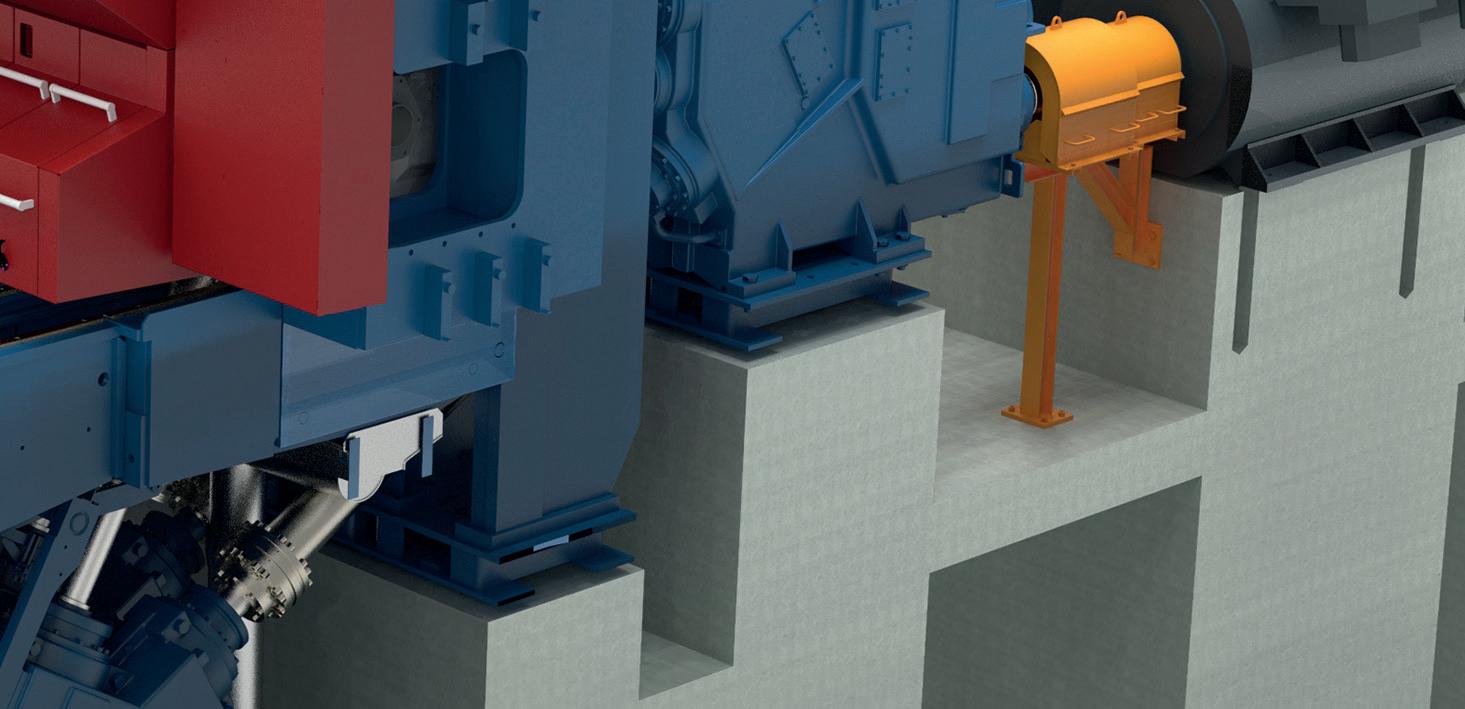

VISIT US
12.-16.6.2023
Hall 1 / Booth A79
up to 160mm
finishing size in round or hexagonal dimensions
up to 20% up to 10% energy savings in the mill line



increase in production

WE MAKE YOUR PRODUCT GOLD www.kocks.de
Tata Steel Long Products orders KOCKS 3-roll RSB®
Tata Steel Long Products has placed an order with Friedrich KOCKS GmbH for the supply of a RSB® 370++/4(5) in 5.0 design. The Reducing & Sizing Block will be part of the company’s new rolling mill complex in Jamshedpur, India.

According to KOCKS, the long products segment is poised to witness significant growth as India further builds its infrastructure and invests in industrialization. With its ‘booming economy’,
KOCKS says, India is aiming to expand its infrastructure and its automotive industry and create new jobs, which means the country is investing heavily in steel production.
The new RSB® 370++/4(5) will be located as a finishing unit after a reversing mill and 12 stands in H/V arrangement in a 500kt/yr combined SBQ and wire rod mill. It will produce straight bars within a dimension of Ø 20.00 to 90.00
mm onto the cooling bed, and will produce the feeders for the wire rod line to finish dimensions of Ø 5.0 to 27.0 mm. The scope of supply further includes the equipment for the roll-shop. The RSB® is scheduled to be commissioned during the first few months of 2024.
For further information, log on to www.kocks.de
INNOVATIONS 16 www.steeltimesint.com Digital Edition - February 2023
PROFILEMASTER® SPS Profile Measuring System
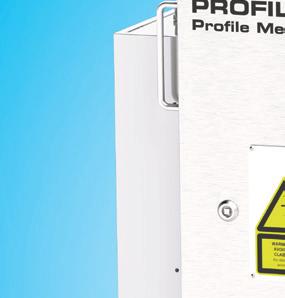


The PROFILEMASTER® SPS is a light section measuring device for measuring contours and dimensions on profiles of all kinds in cold and hot steel applications.

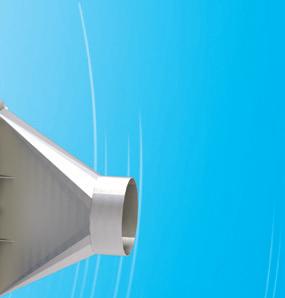

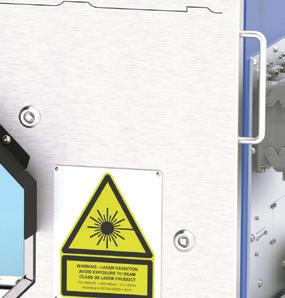

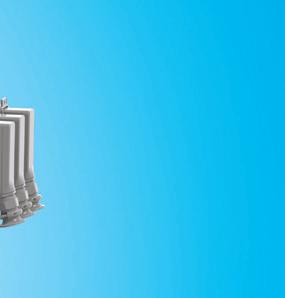
Benefits:
Maximum measuring accuracy thanks to temperature-stabilized measuring systems

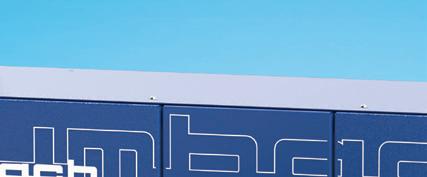


























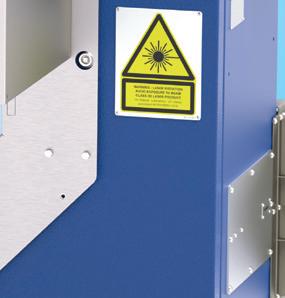










Shape fault detection (SFD) thanks to high sampling rate
High-precision measurements

Detects process problems at an early stage




Fast maintenance and easy cleaning

Zumbach Electronic AG | Hauptstrasse 93 | 2552 Orpund | Schweiz Telefon: +41 (0)32 356 04 00 | Fax: +41 (0)32 356 04 30 | sales@zumbach.ch | www.zumbach.com 4 - 8 Number of cameras min 5 Min. object diameter (mm) max 720 Max. object diameter (mm)
Huaigang Special Steel rolls first bar with new KOCKS RSB®
The steel producer Huaigang Special Steel Co. Ltd., a subsidiary of the Shagang Group – the world’s sixth largest steel producer – has rolled the first bar on its new KOCKS RSB® 500++/4 in 5.0 design.

This is the third KOCKS Reducing & Sizing block installation for Huaigang, following previous projects in 2010 and 2019. A fourth installation is in the process of being set up. With the installation of the KOCKS block in Huaigang’s existing bar mill line, the Chinese SBQ producer is extending its capacity for the production of high-quality special steel for various industries.
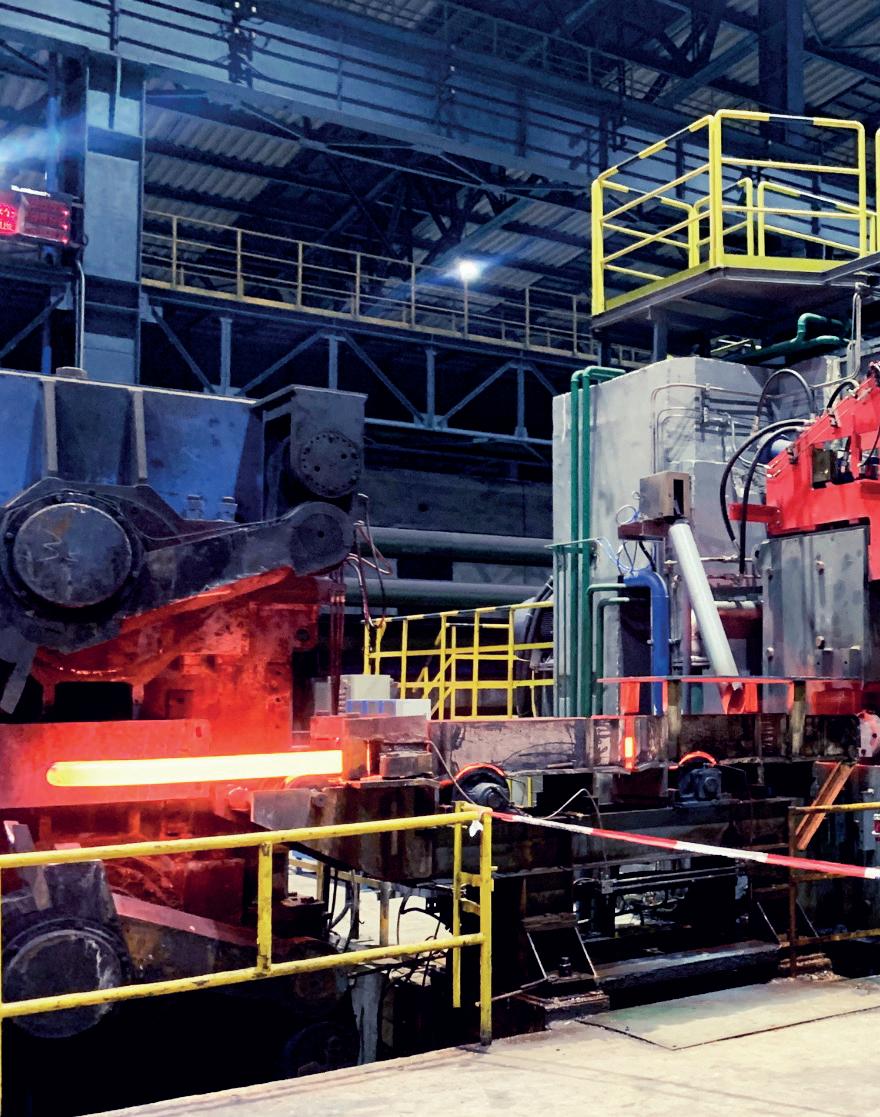
The 3-roll technology of the KOCKS RSB® is designed to improve both the overall efficiency of operations and production capabilities. In addition to providing the RSB® 500++/4, KOCKS also supplied equipment for the roll shop and proprietary software solutions.
For further information, log on to www.kocks.de.
INNOVATIONS 18 www.steeltimesint.com Digital Edition - February 2023

19 www.steeltimesint.com Digital Edition - February 2023 INNOVATIONS
FUTURE STEEL FORUM
2023


SEPTEMBER 2023 VIENNA, AUSTRIA

DIGITALIZATION AND
The Future Steel Forum, now in its SEVENTH successful year, is heading for Vienna in September to examine the important relationship between digital manufacturing and the decarbonization of the steelmaking process. Come and listen to experts from the two most important areas of global steelmaking at present. This is a must-attend conference for anybody with an interest in the fast-developing world of Industry 4.0 technologies and those responsible for sustainable steel manufacturing.
www.FutureSteelForum.com @Future_Steel Join our Future Steel Forum Group


SOMETHING TO SAY AND WANT TO CONTRIBUTE?
are now accepting abstracts for The Future Steel Forum. If you'd like to be a part of this event as a speaker, please contact Matthew Moggridge now on matthewmoggridge@quartzltd.com
EXHIBIT
Sponsored by O cial Media Partner Since 1866 Organised by BUSINESS MEDIA LTD To be the first to hear when registration opens for the Future Steel Forum event in Vienna, please scan this QR code
DECARBONIZATION HAVE
We
SPONSOR OR
To discuss any sponsorship opportunities or exhibition enquires, please contact Paul Rossage now on paulrossage@quartzltd.com
Jennifer Mikus*
InfoSight was born of a desire to innovate. Founded in the 1990s by Dr. John A. Robertson, who enjoyed solving impossible problems more than anything, the company has made a name for itself providing unique, on-demand, automatically traceable identification for products and assets that exist in destructive environments. InfoSight takes two approaches to providing identification to the steel industry: durable metal barcoded identification tags and automated marking solutions.
As automation and digitalization become increasingly important in the steel industry, durable identification that is machine readable also becomes increasingly important. InfoSight was a leader in bringing durable barcoded metal tags to the steel industry with InfoTag® Hot Tag. From there, a broad range of tags have been developed to survive a range of harsh environments, including temperatures up to 1800oF (980oC) and exposure to various chemicals and processes. While there is no ‘one-size fits all’ durable tag, InfoSight ensures that each of their customers uses the proper tag in their process by offering trial samples. Furthermore, InfoSight welcomes the opportunity for product development when unique requirements mean there isn’t a suitable tag yet.
Recently, InfoSight introduced the KettleTag®PLUS EZ metal barcoded tag for galvanized steel, an evolution on the proven KettleTag PLUS technology. Both tags are designed to survive the entire galvanizing process, meaning fabricators and galvanizers can identify a fabricated piece of steel before it goes through the galvanizing process. When KettleTag was introduced, having any identification that could survive the process was incredible. The original KettleTag PLUS incorporates the use of a laminate to protect the tag during certain steps. This laminate needs to be applied after the tag is printed. It also creates the need to cut the tags apart, usually with a large paper cutter. InfoSight has been working for some time to eliminate this need for post-printing lamination and solved the problem with the
Tracing the lines
KettleTag PLUS EZ tag. It has the same survivability as the original but removes time-consuming steps from the process. InfoSight recommends printing this tag on the LabeLase 30XX Metal Tag Laser Printer.
Along with metal barcoded identification tags, InfoSight provides automated marking solutions for the steel industry. The marking technologies include stencil marking, stamp marking, direct laser marking, and automated tagging. InfoSight engineers work with each customer to determine the most suitable marking technology for their process and design a system that fits within the customer’s facility. Traditional, or hard, automation can be utilized in any of these systems with jib, gantry, and self-contained systems being very common. However, robotic automation is becoming a popular choice for integrating any of these marking technologies. Robots are generally
* Technical writer, InfoSight
smaller and faster than traditional systems, making them more desirable to increase efficiency in steel mills where floor space is at a premium.
InfoSight is currently building a robotic stencil marking system for marking continuous cast bar stock produced on a multi-strand caster. This system will replace manual marking of the up to 1200oF (6500C) bars. InfoSight engineers performed an on-site demonstration of the Hot Spray I-Dent® marking head to the customer’s satisfaction. There was some discussion of hard automation for this system, but InfoSight engineers and the customer agreed that utilizing a robot would be the best solution. The End Of Arm Tool will be a marking head with seven nozzles that marks large character programmable message data on the top of each bar. The automated marking system provides two significant benefits to the customer. One is a safety benefit –
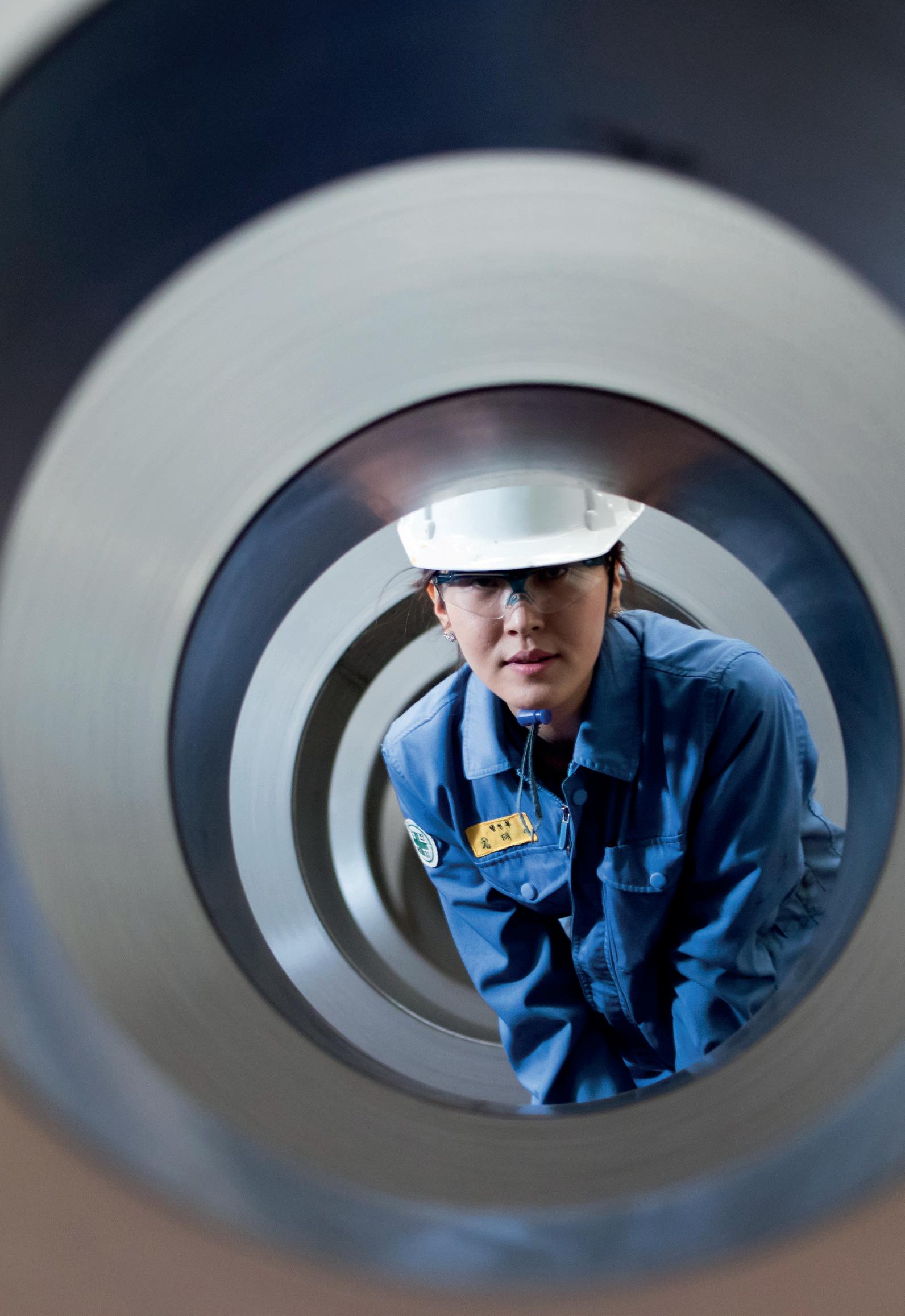
INNOVATIONS SPECIAL: INFOSIGHT 22 www.steeltimesint.com Digital Edition - February 2023
The changes within InfoSight mimic the changes that have taken place within the steel industry; research, development, increased digitalization, and automation. With these focuses, the company is building its solutions, and constantly looking for ways to improve efficiency and durability.
By
the operator can now control the marking system from a pulpit and will no longer be exposed to extreme temperatures. Additionally, more data can be added to the message, including barcodes if and when the customer determines they need automated tracking.


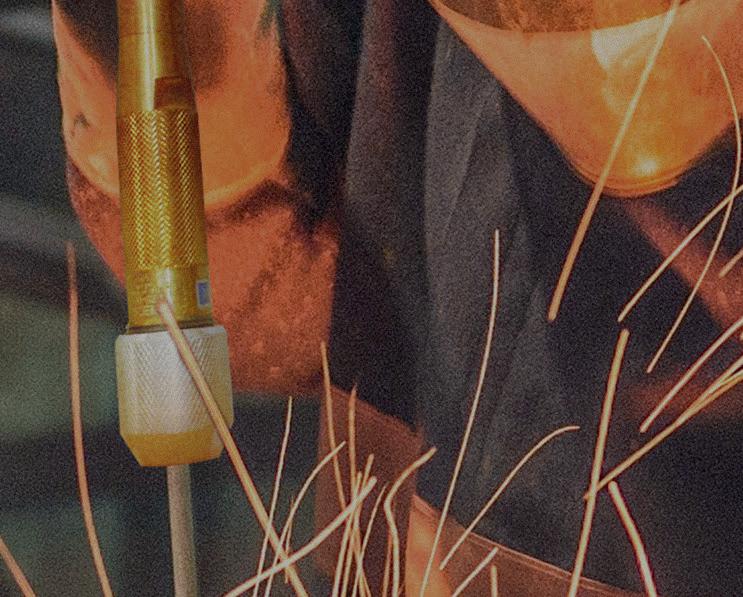
As a small company with a loyal workforce, InfoSight is looking ahead to a period of growth and change. In November, InfoSight announced changes in the leadership of the company effective 1 January 2023.
Dave Hudelson is stepping away from his duties as president to become the executive chairman. Rob Underhill is assuming the helm as president and CEO. This mindful transition of leadership ensures continuity for InfoSight’s employees and ensures the momentum of growth continues.
A second part of that organization announcement included welcoming Aaron Thaler as the new director of research and product development at InfoSight. In the few short months of
Thaler’s tenure, he has established a plan to develop new or improved products that will solve specific problems for our customers. Companies turn to InfoSight when their identification methods either are not working, or they’ve never encountered an identification method that survives their process. Under Thaler’s direction, a team of InfoSight engineers and technicians will develop these solutions. While durable identification is InfoSight’s reputation, the research and development efforts will not be limited to marking technology.
The steel industry has seen many changes over the centuries. The ability to access information anywhere is an expectation. Accessing information about an individual piece of steel at any point in its lifespan is necessary for the way the industry operates.

That information relies upon accurate durable identification. Steel mills, fabricators, and end users rely upon InfoSight to provide identification that guarantees the traceability of steel. �










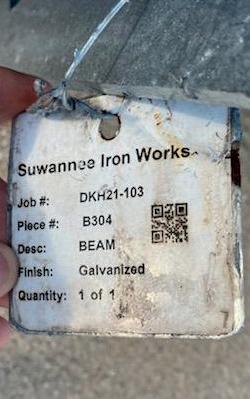

23 www.steeltimesint.com
E xcellence in Ox ygen lancing ww w. beda .com INNOVATIONS SPECIAL: INFOSIGHT
WHILE there has been an upswing, the US is lagging behind the rest of the world where demand for electric vehicles (EVs) is concerned – and this includes both electrified light vehicles and heavyduty trucks. However, the impact of this upon companies that supply steel to the automotive industry is somewhat uncertain depending upon the types of steel products they produce.
“Clearly we are seeing a pretty sizable, although incremental, growth in the adoption of EVs,” Philip Gibbs, a senior equity analyst at KeyBanc Capital Markets

said, observing that globally EVs currently account for about 10% of light vehicle sales with that penetration expected to continue to grow – albeit at different rates depending on region.
There is also some growing interest in electrified heavy-duty trucks, Jeffrey Short, vice president of the American Transportation Research Institute (ATRI), noted, although the rate of adoption for those vehicles have been much slower, given that the average weight of freight makes battery range issues even more challenging due to there being minimal
heavy duty truck charging infrastructure other than at the company’s home base. He noted that of the three million heavy duty trucks on the road in the US today, less than 10,000 are EVs.
John Anton, a director of S&P Global Market Intelligence’s pricing and purchasing service noted that when it comes to passenger cars and light trucks, as recently as 2018 global battery electric vehicle (BEV) production was quite low – less than three million light vehicles. However, he said that by 2022 it had already increased to just under nine million light vehicles and it is
ELECTRIC VEHICLES 24 www.steeltimesint.com Digital Edition - February 2023
*North America correspondent
Driving toward the green
drive, which means there isn’t as much range anxiety there. Also, Hites noted that Europe has effectively mandated a transition to EVs through its regulations for reduced carbon dioxide emissions which include heavy penalties for OEMs that exceed those limits on a fleet level. She added that high gasoline prices and expected gasoline shortages resulting from the war in Ukraine have contributed to a strong consumer transition to EVs in Europe, even though recent studies have shown that the cost to operate EVs isn’t significantly lower than for operating internal combustion engine (ICE) vehicles.
EVs are starting to catch on at a continually increasing rate in the US. However, Kristock pointed out that electrified vehicles (mainly BEVs, but also plug-in hybrids (PHEVs) only accounted for 5-7% of total US light vehicle sales last year. But, according to Kevin Riddel, a North American analyst for LMC Automotive, at 708,461 vehicles in 2022, US BEV light vehicle sales were up 75.5% year-on-year and are expected to increase by another 54.9% this year and to account for 14% of new US light vehicle sales by 2025. Similarly, he said, North American BEV light vehicle production increased 46.2% last year (accounting for 5.7% of NA light vehicles produced) and is expected to increase another 49.1% this year and have a 14.0% share of all NA light vehicle output by 2025. Graph 2
expected that within another three years 20 million or more BEVs could be produced globally, and that 10 years from now – as long as there is enough electric steel and battery materials to support it – global BEV production could rise to about 40 million (a little less than half of total light vehicle production.) Graph 1
While it has recently made some inroads, currently US EV production and sales are not as strong as those in some other parts of the world. Chris Kristock, vice president of the automotive programme for the American Iron and Steel Institute (AISI) noted that China leads the way because they have the infrastructure in place for
battery production as well as having the availability of the necessary raw materials. Also, Becky E. Hites, president of Steel-Insights, pointed out that through a combination of tax incentives (which were targeted to be removed in 2022 but have been extended through to the end of 2023) and the availability of regional license plates, in 2022, China exceeded the mandate put in place by its central government that its ‘New Energy Vehicle’ sales were more than 25% of its total vehicle sales by 2025.
Kristock said that Europe comes just behind China, partly because of the average vehicle size and the limited miles people
In fact, Cox Automotive reported that a record number of EVs were sold in the US during the third quarter of 2022 – more than 200,000 vehicles – which the report attributed to new entries. Not only have new companies gained more market share in the US market, which Tesla has traditionally dominated, but that increase has come from the midsized SUV, compact SUV and full-sized light truck models, which are segments that are very important to US consumers and accounted for 47% of total third quarter sales.
A Cox spokesperson noted that not only were there 19 launches and redesigns of EVs in 2022, but there will be another 27 launches or critical refreshes of light EV models this year. Also, she said certain barriers to US EV purchases – including the

ELECTRIC VEHICLES 25 www.steeltimesint.com Digital Edition - February 2023
With demand for electric vehicles rising, questions remain on what impacts will be incurred on steel markets, in terms of demand, and types of production. By Myra Pinkham*
availability of charging stations and battery issues – are starting to ease and that 50% of consumers say that the tax credits in the recently passed Inflation Reduction Act (IRA) will encourage them to purchase an EV for personal use.
Riddel said that another supportive factor has been the recently passed Advanced Clean Cars II standard, which requires that all light vehicle sales be EVs – either BEVs or PHEVs in California by 2035. Reportedly, 14 other states and the District of Columbia
have adopted similar emissions standards and Canada is working on achieving a national zero emissions policy.
ATRI’s Short noted that California is also offering incentives, including rebates, to encourage heavy duty EV truck sales as well, which he said is needed given that those trucks are two to three times more expensive than ICE models. He said that because of this, and growing interest by their customers to decrease their carbon footprint, several truck companies, such as

LMC Automotive Light Vehicle Outlook
Volvo and Freightliner, have been testing the use of EV trucks, but, to date, volumes remain low.
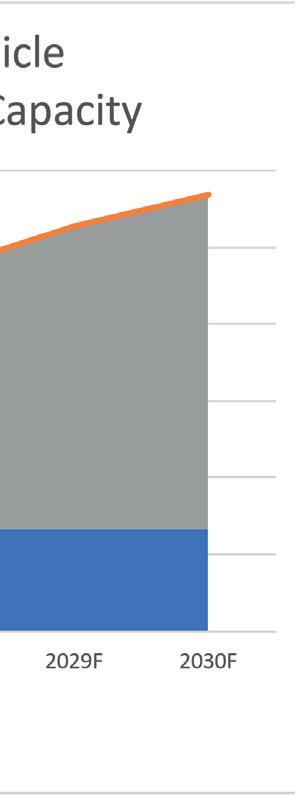
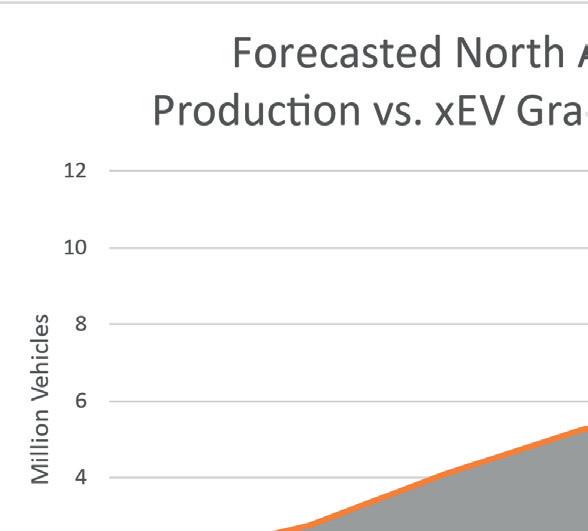
He said one limiting factor is that currently there is no meaningful amount of public charging infrastructure for heavy duty trucks, requiring them to go back to their home base to recharge. With the average BEV truck only getting 200-300 miles per charge, Short added that ‘in the long-haul industry, we want to go about 500 miles per day.’
Charging is also a big issue for EV passenger cars and light trucks, Gibbs said, noting that if every light vehicle in the US goes electric, over 100 million vehicles would need to be charged and even with new, faster charging stations, it takes more time to charge an EV than to fill up an ICE vehicle with gasoline or, in the case of heavy-duty trucks, with diesel. Even though he maintained that while range anxiety will never go away, S&P Global’s Anton said there is a growing realization that it is somewhat overblown given that with new battery technologies, EVs’ ranges have already improved.
While at first glance it would appear that increased demand for electric vehicles would be positive for producers of the steel, aluminium and other metals used in their production, Timothy Van Audenaerde, Accenture’s global metals lead, said that


ELECTRIC VEHICLES 26 www.steeltimesint.com Digital Edition - February 2023
2020 2021 2022 2023 2024 North American LV Production 12,941,518 12,989,491 14,191,094 15,199,650 15,914,753 North American LV BEV Production 409,864 555,174 812,079 1,211,364 1,642,628 US LV BEV Sales 254,295 403,585 708,461 1,097,583 1,650,130
Graph 2. Source: LMC Automotive
Graph 1. Data Sources: S&P Global Mobility / IHS Markit, xEL Mobility, Metals Technology Consulting, and Steel-Insights, LLC.
it isn’t so clear cut given that EVs are displacing internal combustion engine (ICE) vehicles, and that factors such as range and battery expense will also affect the demand for those metals. “EVs manufactured for increased range – with bigger or more advanced batteries and a lighter weight overall design – typically use aluminium alloys over steel,” Audenaerde said, even though those alloys are higher cost.
Advanced High Strength Steels
AISI’s Kristock, however, maintained that the lightweighting opportunity of using aluminium in some applications where steel is now used isn’t as straightforward as just comparing the density of the two metals. He explained that, for example, to maintain stiffness or rigidity of parts converted from steel to aluminium, thicker gauges would need to be used. “At the same time, steel’s thicknesses, therefore weight, is coming down because of the properties of new advanced high strength steel (AHSS) grades, which are able to be formed into complex shapes because of its improved strength and ductility.
Because of this, Audenaerde said that AHSS will be the primary steel utilized for EVs and that mills will continue to develop and produce AHSS close to where it is most needed and wanted – with near end users seeking greater energy efficiency and lower carbon emissions from their products.
With the two metals meeting somewhere in the middle for a number of components, Kristock said it has been shown that automakers can produce a very nearly mass equivalent vehicle out of steel at a significantly lower cost. Anton pointed out that lightweighting has been on automakers’ minds for the past 15-20 years for all of their vehicles and that materials used in the body of EVs, while moving more
towards AHSS, really doesn’t vary greatly from the body of ICE vehicles.
“The major difference in EVs is that they don’t have engine blocks, exhaust or cooling systems, all of which currently use a good amount of steel,” Anton said. But the engine block is replaced by electric motors, which require non-grain oriented electric steel (NOES), and there is also a need for grain oriented electric steel for the EVs’ charging and discharging systems.

been on allocation since early last year and is expected to continue to be so for the foreseeable future, Anton said, adding that because of the tight supply of electric steel, lead times for industrial generators and electric motors are out 80-100 week and are growing. Similarly, lead times for industrial transformers go out into 2026. Anton said that there is a need for multiple electric steel mills to be added each year over the next five to 10 years given the expected BEV growth rate over that time period. But, he said that to date such public announcements by steelmakers have been limited.
Hites said that currently the AK Steel division of Cleveland-Cliffs, which at the end of last year introduced a new NOES product line, called MOTOR-MAX™, for high frequency motors and generators, is the only North American NOES producer. But, she said that even with Cliffs’ additional production capacity and with US Steel’s Big River Steel unit starting to produce electrical steel in mid-2023, that will be insufficient to meet long-term EV electrical steel demand.
There is, however, a strategic gap and supply chain vulnerability when it comes to electric steel, Hites said, given that the majority of the electrical steel used for EVs doesn’t originate in the US. That, according to Dr. Gwynne Johnston, president of Metal Technology Consulting (MTC), will put the automakers producing EVs between a rock and a hard place in the future. They not only don’t want to be exposed to long supply chains based on imports, but they are under pressure to reduce the cost of EVs.

Already, at current EV production levels, non-oriented electrical steel (NOES) has
Johnston said that the higher cost of NOES in the US is resulting in most EV motors being imported. She said, “Cliffs’ announcement is a step in the right direction, but we need to find better ways to support our domestic steel and manufacturing industry to reduce costs.”
“Overall BEVs is a growth market for steel,” Anton said, maintaining that what could hold it back isn’t demand, but the availability of steel – particularly electric steel – and other raw materials used in EVs and EV batteries such as copper and lithium. Kristock said he believes that the steel industry will continue to make the necessary investment to make the steel grades needed to support its demand as EV production grows. �
ELECTRIC VEHICLES 27 www.steeltimesint.com Digital Edition - February 2023

The decade of delivery The decade of delivery
The stakes in achieving climate goals lie in turning ‘ambition into action’, says Cécile Seguineaud*, and as we draw closer to net-zero deadlines, fundamental changes to the industry are required in order to increase momentum and support a clean, green transition.
The steel sector plays a key role in achieving climate goals, as it accounts for nearly 8% of global emissions from the energy sector. However, the path to net-zero requires a deep transformation, bringing new challenges that are likely to reshape the steel industry.
Considering this decarbonization imperative, an increasing number of initiatives have been launched in recent years. Whether driven by governments, industry, or multi-faceted partnerships, they aim to support and guide this transformation (Box 1). Equally, through the Breakthrough Agenda, COP 26 has further increased this momentum (COP26, 2021[1]).
While the nature of the transformation and its implications have been explored extensively, the stake now lies in turning ambition into action. This echoes the COP 27 presidency’s call for implementation, the current decade being depicted as critical to achieve the Paris Agreement’s objectives ((COP26, 2021[2]) (COP27, 2022[3])). This brief aims to provide evidence-based trends on key indicators of steel decarbonization progress to support the COP27 call for action. The focus includes carbon emissions, countries’ and companies’ net-zero targets, production, capacity, breakthrough technologies, and carbon pricing.
1. The decarbonization journey: the starting point and the end goal
The steel industry is a key sector to reach climate goals…
BOX 1.
CONNECTING THE DOTS ON STEEL DECARBONIZATION INITIATIVES [1]).

In September 2022, the OECD hosted an event called “Connecting the Dots on Steel Decarbonization Initiatives: Contributing to a Global Inclusive Dialogue”. The goal of this event was to explore the wide landscape of initiatives that have been launched in recent years to accelerate the decarbonization of the steel sector and to identify where possible gaps may exist, but especially where synergies could be created among them. In addition, the event aimed to uncover how the collaboration between policymakers, steel industry associations and private, as well as public-led initiatives can be leveraged to support this transition, recognizing that each actor has an important role to play.
The event focused on two particular areas where efforts are increasing but remain too fragmented: data and trade. First, data represent the backbone of any true implementation effort as they are crucial to measure and compare progress across industries and countries on their path to net-zero emissions. To this aim, stakeholders underlined the importance to have access to disaggregated data for embedded steel carbon emissions at the plant and national level. These data will also be crucial to reach agreement on standards and definitions for “near zero or low-carbon emission steel production”, which in turn, will be foundational to shape trade measures.
As steel account as a highly export-oriented commodity, trade policies are essential to underpin decarbonization efforts. With countries and companies undertaking costly investments to transition the steel industry towards near zero emissions, carbon leakage has become a major concern and levelling the playing field an urgent response to this issue. In this regard, many proposals have been advanced in recent years, which include a Carbon Border Adjustment Mechanism (CBAM), but also a Carbon Alliance or Carbon Clubs. Although a multilateral solution is not yet within reach, the importance to push for a common adoption of standard and definition has been widely reiterated, which recalled how they are a prerequisite of any effective anti-carbon leakage policy.
DECARBONIZATION 29 www.steeltimesint.com Digital Edition - February 2023
*Analyst, steel decarbonization, OECD.
Notes:
With direct emissions equating to 2,591
Mt CO2 in 2020 (IEA, 2021[4]), the iron and steel sector accounts for nearly 8% of global emissions from the energy sector. It further ranks as the largest emitting sector in industry, representing 30% of industrial carbon emissions (IEA, 2021[4]). With such a large carbon footprint, decarbonizing the steel sector is key to achieve climate goals.
… largely dominated by highly carbonintensive production
Steel production and its related CO2 emission intensity form the core drivers of carbon emissions. In 2020, global steel production reached 1,878Mt (worldsteel, 2021[5]), with an average direct carbon intensity of 1.4 tCO2/tsteel (IEA, 2021[6]).
BOF is by far the predominant steelmaking route accounting for 73% of total output (worldsteel, 2021[5]).
This outlines the dominance of high carbon-intensive production processes, underpinned by a 75% share of coal in final energy demand in the steel sector (IEA, 2021[7]).
A long way to go for reaching near zero emission
To meet the Paris Agreement objective of limiting global warming to 1.5°C,
Notes:
NZE:
global CO2 emissions must decline on an unprecedented scale, reaching net-zero in 2050 (IPCC, 2022[8]). To comply with this overall goal, direct emissions of the steel sector and related carbon intensity have to decrease by 90% from 2020 levels by 2050 (IEA, 2021[9]) (Fig 1). This shows that the steel industry has a long way to go for reaching near zero emission and how the carbon neutrality target is a game changer for the steel industry, calling for a deep transformation of the sector.
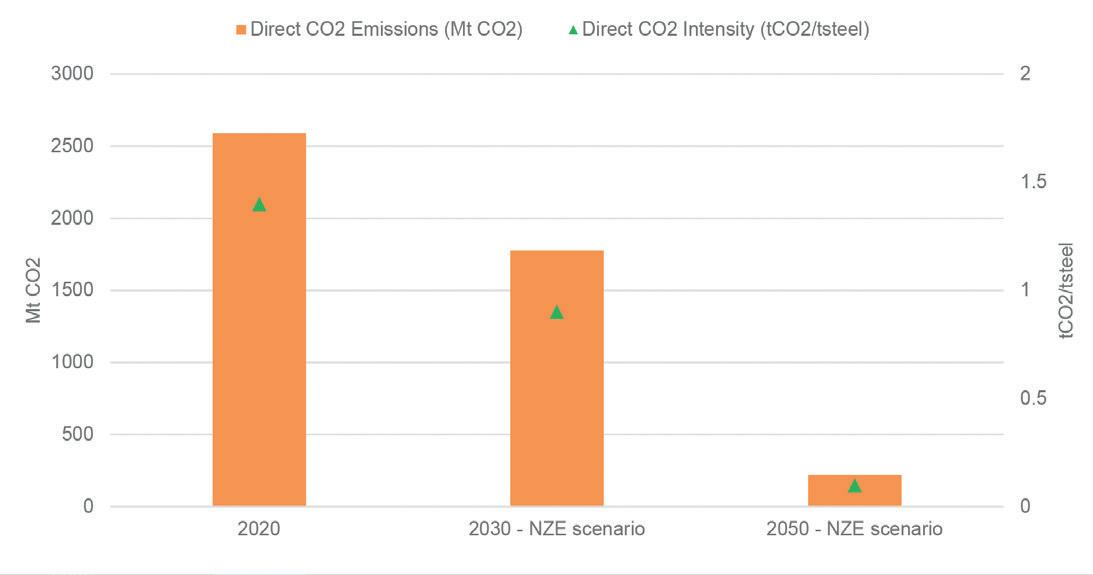
2. Is the level of ambition of steel producing countries up to the task?
With net-zero pledges booming, the steel sector must decarbonize
As of the end of 2021, more than 90% of global steelmaking capacity and crude steel production were in countries that had announced a net-zero target. This represents a sharp increase compared to 2020 (Fig 2). Given these pledges, the global steel industry is bound to follow a net-zero pathway1
Despite encouraging progress, uneven levels of ambition nuance such high scores
The nature of announced targets provides a more balanced perspective (World
Resources Institute, 2020[10]). As of end2021, only 18% of global steelmaking capacity and production was in countries with a net-zero target enshrined ‘in law’, about 60% related to a ‘policy document’ status, and 18% upon a ‘political pledge’ (Fig 2).
However, the comparison with 2020 levels reveals some encouraging signs. The 2021 growth in net-zero capacity and production coverage has been combined with a significant change in target types. There has been an overall increasing level of ambition, with most of the capacity covered by a ‘political pledge’ in 2020 shifting to ‘in policy document’ in 2021. Equally, major steel producing countries raised their level of ambition, from a net-zero target ‘in policy document’ to an ‘in law’ status.
While being an essential step, pledging is not enough
Setting a net-zero target is a first crucial step but does not by itself guarantee that emission reductions will be achieved. Such targets should be seen as a commitment to take ambitious actions to curb emissions, thus the starting point for developing decarbonization strategies.
When moving to implementation, a major pitfall lies in the fact that net-zero
1. While net-zero pledges are not directed to the steel sector itself (but to the whole economy), such targets imply a deep decarbonization of steel production. In this policy brief, capacity/production ‘subject to a net-zero target’ or ‘covered by a net-zero target’ refers to capacity/production ‘located in countries covered by a net-zero target’.
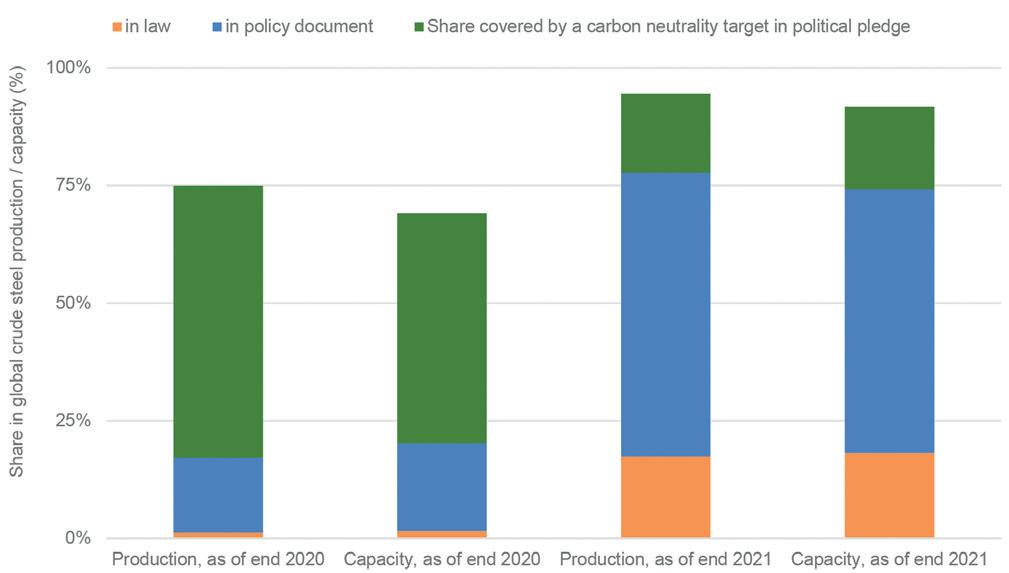
2. Objective to reach carbon neutrality (or similar) by 2050 or before, depending on the companies.
3. Whereas this rationale primarily relates to the BF-BOF route (given its relative high carbon intensity), it also applies to fossil fuels-based DRI EAF. Even if less carbon intensive, such facilities are nevertheless not aligned with near zero emission steel production, if not transitioning to low-carbon hydrogen or equipped with CCUS (IEA, 2022[19]).
4. Direct Reduced Iron (DRI).
DECARBONIZATION 30 www.steeltimesint.com Digital Edition - February 2023
Fig 1. Direct CO2 emissions and intensity trajectory in the NZE scenario.
CO2 emissions refer to direct emissions only (including energy and process emissions). NZE: IEA Net Zero Emissions by 2050 scenario. Source: (IEA, 2021[4]), (IEA, 2021[6]), (IEA, 2021[9]).
Fig 2. Share of global crude steel production and capacity covered by a net-zero target.
CO2 emissions refer to direct emissions only (including energy and process emissions).
IEA Net Zero Emissions by 2050 scenario. Source: (IEA, 2021[4]), (IEA, 2021[6]), (IEA, 2021[9]).
pledges are not sector specific but cover the whole economy. By providing a focused objective, setting sectoral targets could support the development of strategies and policies considering sectoral specificities. Equally, acknowledging that there is no ‘one-size-fits all approach’ calls for defining tailored approaches, in particular taking into account a country’s specificities.
3. As implementers, are steel companies aligned with net-zero?
A mismatch between countries’ and corporate pledges
Companies as drivers of steel production are key implementers of decarbonization. To follow a net-zero pathway, it is, therefore, essential that countries’ pledges are mirrored by those of steel producers.
As of end-2021, 30% of global crude steel production and steelmaking capacity were covered by a corporate net-zero target2 (Fig 3). Similar to countries’ pledges, this share has significantly increased compared to 2020 levels. This doubling in coverage is mainly due to announcements from several top 10 steel producers in 2021.


Overall, the share of steel production and capacity covered by corporate netzero targets (30%) is well short of the one related to steelmaking countries’ pledges (more than 90% coverage, Section 3). The reasons for this clear gap towards implementation are the following.
First, there may be a time lag between companies’ responses and the pledge announcements of the country in which they operate. In addition, and referring to section 2, it is worth noting that net-zero
countries’ pledges refer to their whole economy but are not written from a sectoral perspective. Furthermore, steel decarbonization related challenges (whether related to investments, technologies, and/ or competitiveness) may hinder companies’ ambition to commit to such targets.
Given the variety of company and country profiles, a tailored approach is warranted.
In terms of a company’s profile, an increasing number of the world’s top 10 producers have pledged for net-zero over the last year (Fig 4). As of end-2021, this category represented a quarter of the total number of listed steel producers having pledged for net-zero. However, in terms of the number of companies, the category of smaller companies is still important (companies below rank 45 of the largest steel producers according to (worldsteel, 2022[17]), with annual production below 10Mt).
From a regional perspective, Europe accounts for the majority of companies with net-zero targets. Whereas steel companies’ pledges have increased in various regions worldwide, the Asian region and the People’s Republic of China (hereafter “China”) have especially experienced a significant growth. They now represent the second regional pool, after Europe.
Overall, the diversity of companies committed to net-zero adds to the countries’ specificities raised previously. Typically, the EAF (or BOF) share ranges from 0% to 100% depending on the company (Global Energy Monitor, 2022[18]). Equally, the age and location of the assets, as well as their technological leadership (especially with respect to breakthrough
technologies) are other characteristics shaping each company’s decarbonization roadmap. The size of the firm and its investment capacity are key features driving decarbonization implementation. When combining all these aspects, low-carbon business strategies and related investments are likely to be specific to each company, and even project based. This further reinforces the imperative of a tailor-made approach to ensure a successful sectoral decarbonization.
4. Beyond the pledges, are steel production and capacity on the right track?
Achieving near zero emission steel relies on a diversification of production routes ‘Near zero emission steel production’ refers to crude steel production whose emission intensity is compatible with a global net zero pathway by 2050. To identify the steelmaking routes complying with this requirement, the quantitative thresholds of emission intensity defined by the IEA (IEA, 2022[19]) are leveraged.
Based on these considerations, production levels compatible with a near zero emission pathway amounted to 20% of global crude steel production, scrapbased EAF being the contributing route ((worldsteel, 2021[5]), (IEA, 2021[20])). Next to scrap-based EAF, a further structural shift in production methods for decarbonization purposes is needed.
The lack of diversified near zero emission steel production routes currently available at commercial scale hinders the ability to significantly increase this share in the shortterm. Scaling-up breakthrough technologies
DECARBONIZATION 31 www.steeltimesint.com Digital Edition - February 2023
Fig 3. Steel producing companies with a net-zero target – related share in global steelmaking capacity/production. Source: Calculations based on companies websites, (Global Energy Monitor, Caitlin Swalec, Christine Shearer, 2021[12]), (Vogl, 2021[16]), (worldsteel, 2021[5]), (worldsteel, 2022[17]), (worldsteel, 2022[13]), (Global Energy Monitor, 2022[18]), (OECD, 2022[15]).
Fig 4. Steel producing companies covered by a net-zero target – production ranking breakdown. Note: Companies breakdown according to the ranking defined in (worldsteel, 2022[17]). Source: Calculations based on companies websites, (Global Energy Monitor, Caitlin Swalec, Christine Shearer, 2021[12]), (Vogl, 2021[16]), (worldsteel, 2022[17]).
(such as CCUS and hydrogen) will be particularly crucial to unlock this potential.
Carbon emissions-intensive assets prevail, with regional disparities
As of end-2021, BOF assets clearly dominate the global landscape, accounting for around two-thirds of total capacity (Fig 5). Since the BF-BOF production routes are not equipped with carbon capture utilisation and storage (CCUS), the current structure of assets is not yet aligned with a net-zero pathway.
The regional picture reveals strong disparities, with EAF shares ranging from less than 15% to more than 80% (Fig 6). When combining the BOF/EAF share with capacity levels, Asia stands as a critical region. Accounting for nearly 70% of global capacity, its EAF share is only around 20%.
New projects are not going in the right direction, increasing the risk of stranded assets.
The previous trends are even more pronounced when looking at future steelmaking projects. As of end-2021, there were about 160 Mmt of new capacity projects underway or planned over the next three years (2022-24). Most of the capacity relates to BOF (55%) (Fig 7). From a regional perspective, more than half of the capacity planned is located in Asia, and 90% of planned capacity in Asia are BOF projects (OECD, 2022[15]).
BF-BOF plants (if not equipped with CCUS) risk to become stranded assets. The high share of BOF assets in planned projects further increases this risk, by contributing to locked-in emissions for decades. This risk does not only arise from a domestic

perspective, but also from an international one. Such assets are unlikely to be able to compete in future markets for low-carbon emission steel, or as trade aspects based on carbon content criteria emerge.
Complying with emission reduction objectives and mitigating the risk of stranded assets would imply massive retrofits or early retirements. In addition to increasing the cost of the low-carbon transition, this equally involves high social impacts on workers and communities. In view of the current structure of assets, it is, therefore, critical to develop specific strategies for the management of existing assets.
5. Are the next technologies ready to take over?
Projects implying innovative routes keep on growing
Achieving near zero emission steel production strongly relies on the uptake of innovative routes. As of mid-2022, there were around 40 innovative near zero emission steelmaking projects worldwide (Fig 8). This project pipeline covers announced projects involving a facility plant based on an innovative near zero emission production route (hydrogen-based DRI4 EAF, CCUS, or others such as direct iron ore electrolysis (IEA, 2022[19])). The number of such projects has grown steadily in recent years, more than doubling between 2020 and mid-2022. This trend is consistent with the increasing announcements in terms of emission reductions, both from governments and steel companies (sections 3 and 4).
Europe stands at the forefront of
innovative near zero emission steelmaking projects since 2020, driving the global project pipeline growth. As of mid-2022, Europe accounted for about 65% of the project portfolio, China accounted for almost 15%, and North America for 8% of the projects. Alongside the pledge of carbon neutrality by 2060 and the target for emissions peaking by 2030, major Chinese steel producers have launched projects involving innovative steelmaking technologies (HBIS, Baowu).
DRI technology is the cornerstone of innovative projects
DRI technology is by far the major route, representing nearly 75% of the innovative near zero emission project pipeline as of mid-2022. Besides innovation challenges, the impetus for the hydrogen-based DRI route brings new strategic inputs, for which securing access becomes crucial. The remaining projects involved CCUS-based technologies, and less advanced routes in terms of technology readiness, such as direct iron ore electrolysis.
A low-level of industrial maturity calls for a massive technology scale-up
More than 60% of the innovative near zero emission steelmaking projects are designed to run on an industrial scale, but are not yet in operation (Figure 9). Project announcements for industrial scale plants have more than tripled in the last two years, underlining both advances in technology readiness and the growing engagement of steel companies towards decarbonization (Section 4). Early industrial stage projects represent a further third, implying pilot or
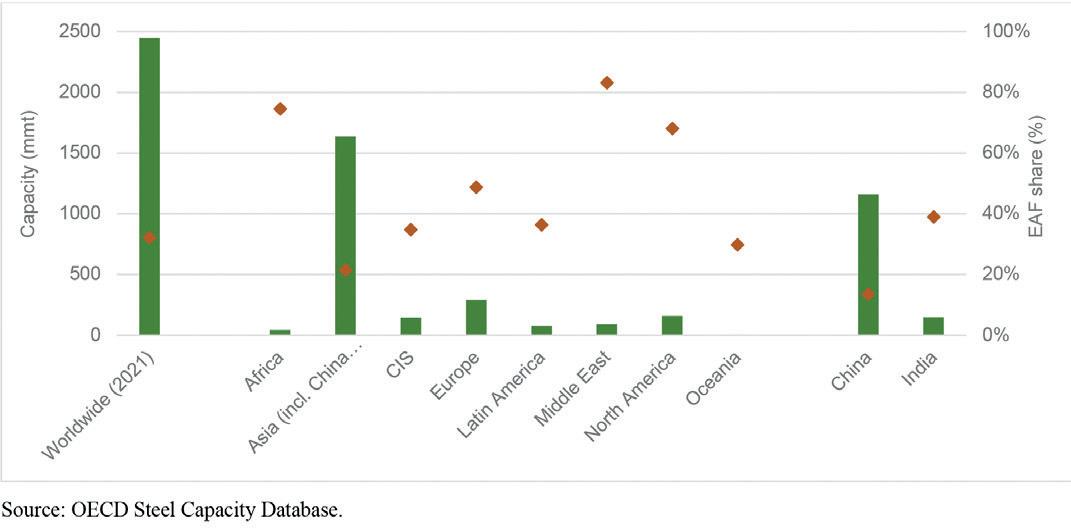
DECARBONIZATION 32 www.steeltimesint.com Digital Edition - February 2023
Fig 5. Global steelmaking capacity and related asset structure. Source: OECD Steel Capacity Database.
Fig 6. Steelmaking capacity and related share of EAF – regional breakdown. Source: OECD Steel Capacity Database.
demonstration-scale facilities. Only a few projects are operating at an industrial scale. The first established one has been operating with CCS since 2016 in the UAE (ADNOC, 2022[21]), whose captured CO2 is used for Enhanced Oil Recovery purposes (and thus not driven by steel decarbonization purposes).
Overall, the low-industrial maturity level observed for the project pipeline highlights the mismatch with a net-zero by 2050 trajectory. Such a gap reveals the crucial need to scale-up breakthrough technologies, and the central role of innovation in the low-carbon transition.
6. To what extent does carbon pricing apply to the steel sector?
Only a small fraction of global steelmaking capacity is subject to carbon pricing…
Aiming to incentivise the shift towards lower emitting technologies, carbon pricing is one of the policy tools used to support emission reductions. Existing carbon pricing mechanisms implemented worldwide cover both carbon taxes and Emissions Trading Systems (ETS), and are applied at the (inter) national or/and subnational level. ( (The World Bank, 2022[22]), (ICAP, 2022[23])).
However, not all of them are relevant when focusing on steel decarbonization. For instance, some of them do not relate to a steel producing country, do not apply to the steel sector, or are implemented only at a pilot stage.
Furthermore, carbon pricing often includes exemptions (free allocations, thresholds on plant capacity). Thus, even if a carbon pricing mechanism is in force for
the steel sector in one specific jurisdiction, the total steel production and capacity of this jurisdiction may not fall under the category ‘covered by a carbon price’. Without accounting for potential exemptions, carbon pricing covered around 20% of global steelmaking capacity and production in 2021. Given that it constitutes a maximum share (namely without prejudging of the level of capacity/ production subject to exemptions), this relatively low order of magnitude underlines the current limited contribution of carbon pricing as a tool to foster steel industry decarbonization.
…with prices not in line with a net-zero ambition
This trend is further reinforced when considering the level of price applied (Fig 10). None of the carbon prices accounted for above reached the threshold of USD 120 per tonne of CO2. This threshold is the level of carbon price which would be required in 2030 to be in line with a net-zero pathway by 2050, should carbon pricing play a major role in the overall decarbonization effort (OECD, 2021[24]).
Even by selecting a threshold of USD 60 per tonne of CO2 (which would be consistent with a net-zero pathway by 2060 (OECD, 2021[24])), it is still less than 10% of global steelmaking capacity and production that is subject to such a price level.
The risk of losing competitiveness on global markets, as well as carbon leakage concerns, are some reasons underpinning carbon price exemptions observed for the steel sector. It thus highlights the central role of international co-operation
in enhancing the global level playing field, as one of the means to ensure an efficient low-carbon transition.
7. Towards COP27: the urgency of implementation
Despite important progress in several areas, key indicators in this brief show that the steel sector is not yet on a trajectory compatible with the Paris Agreement objectives. This underscores the scale of the challenge to reduce emissions in steel production by 90% from 2020 levels by 2050.
Countries’ net-zero pledges are booming, with more than 90% of global steelmaking capacity and production located in jurisdictions that have announced such targets. Similarly, steel producing companies have increasingly announced net-zero targets.
However, there is a mismatch between corporate commitments and country-level pledges. As of end-2021, companies with net-zero targets accounted for 30% of global steel production. This share has doubled over the last year, though more commitments would help reduce the mismatch even more.
Beyond the pledges, near zero emission steel production has not yet taken off sufficiently. Although scrap-based EAF indeed can contribute significantly to decarbonization, reaching near zero emission also needs a more structural shift.

In terms of assets structure, emissions intensive plants prevail. BOF plants, which are currently not fit for a low-carbon future, account for two-thirds of global capacity. While

DECARBONIZATION 33 www.steeltimesint.com Digital Edition - February 2023
this share is undeniably linked to the
Fig 7. New steelmaking projects and related asset structure.Note: The capacity data contains projects both underway and planned over the next three years (2022-24), as of end of 2021. It does not consider closures that may occur during the period. Source: Calculations based on (OECD, 2022[15]).
Fig 8. Number of innovative near zero emission steelmaking projects. Note: ‘Innovative near zero emission steelmaking projects’ refer to announced projects involving a facility plant based on an innovative near zero emission production route (e.g hydrogen-based DRI EAF, CCUS, iron ore electrolysis). Source: Calculations based on various information sources (Metal Expert, Kallanish, Platts, media, companies and regional steel associations’ websites).
Source:
legacy of past decades of the steel industry (given long lifetimes of these assets), BOF capacity still represents more than half of the newly planned capacity as of end 2021. Such projects are not compatible with decarbonization objectives if not equipped with CCUS and exacerbate the risk of stranded assets.
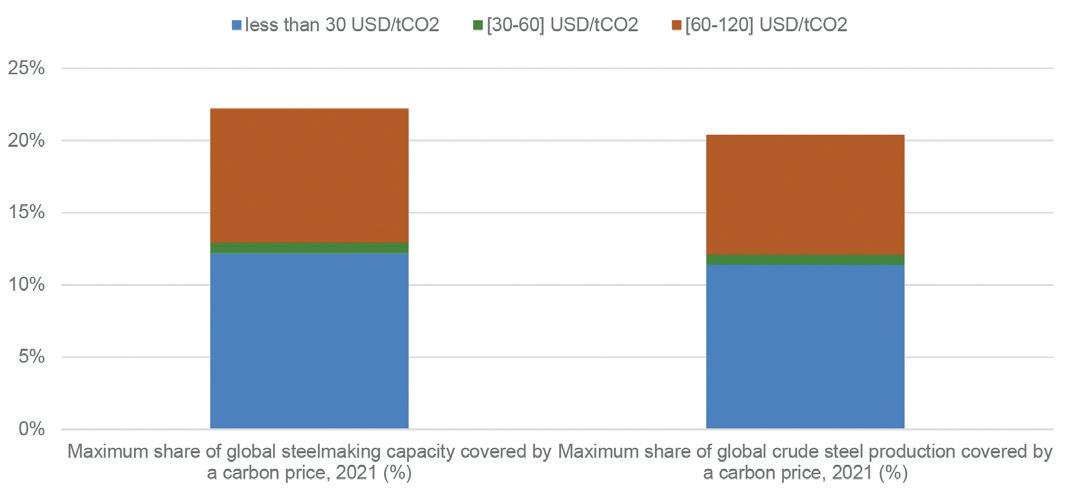
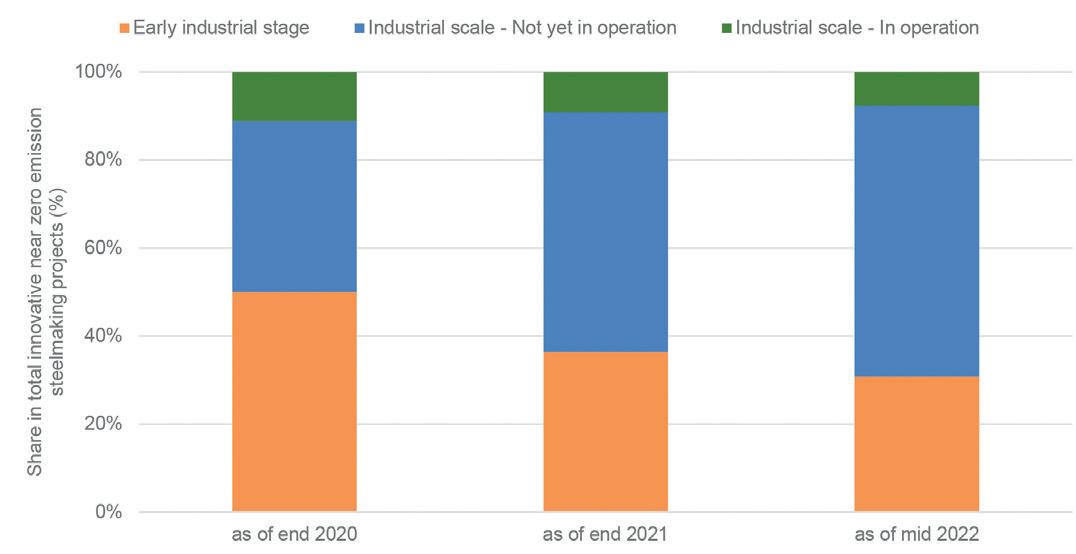
This is even more compelling as most of these projects are located in countries that have pledged for carbon neutrality.
The project pipeline of innovative near zero emission technologies is promising but faces a low-level of industrial maturity. Only a few projects are operating at an industrial scale.
Source:
Overall, reaching net-zero by 2050 calls for significantly scaling up technologies.
Policy tools to support emission reduction
Carbon-pricing mechanisms currently cover less than 20% of global steelmaking capacity. When considering the prices applied, they have not reached the level that would be required to be in line with a net-zero pathway by 2050.
Finally, the gap between the level of ambition and implementation faces multiple challenges.
These include for example, scaling-up innovative technologies, investments,
competitiveness, ensuring a global level playing field, establishing markets for near zero emission steel, securing strategic inputs and addressing asocial aspects.
Steel decarbonization is a global challenge requiring a global response.
Collaboration among countries, as well as between public and private stakeholders, will be essential to accelerate progress towards a net-zero pathway.
The OECD steel policy community, convening both governments and industry, stands ready to support the move towards implementation, as well as to foster synergies with existing steel decarbonization initiatives.
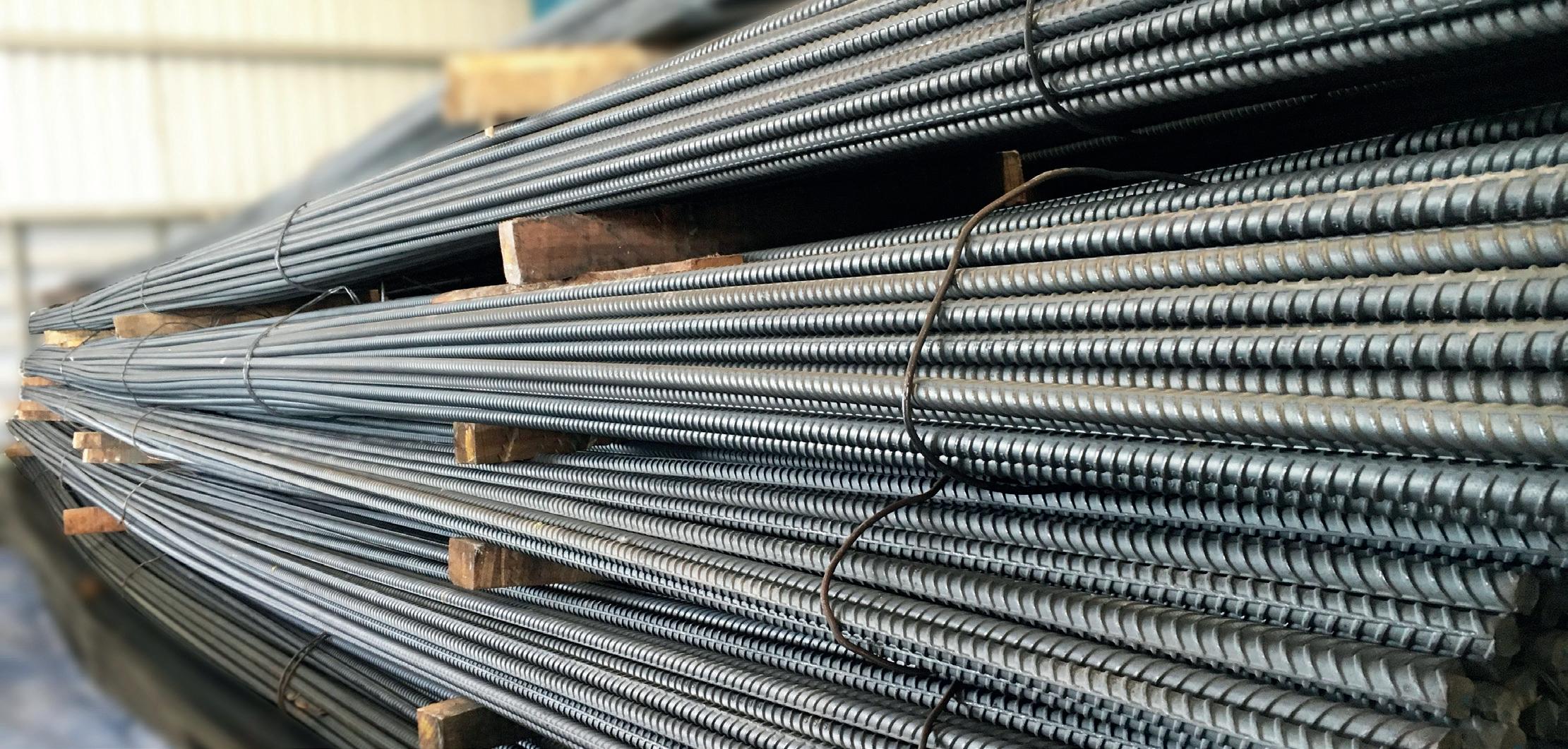
DECARBONIZATION 34 www.steeltimesint.com Digital Edition - February 2023
Fig 9. Innovative near zero emission steelmaking projects – industrial maturity level. Note: ‘Innovative near zero emission steelmaking projects’ refer to announced projects involving a facility plant based on an innovative near zero emission production route (e.g hydrogen-based DRI EAF, CCUS, iron ore electrolysis).
Calculations based on various sources of information (Metal Expert, Kallanish, Platts, media, companies and regional steel associations’ websites).
Fig 10. Maximum share of global capacity and production covered by a carbon price –price breakdown. Notes: Steel producing countries accounted involve carbon taxes or Emissions Trading Systems (ETS) that are implemented at full scale (not pilot stage). When carbon prices are not applied at the national level but at the subnational level, only the capacity of the related subnational jurisdiction is accounted. Level of capacity/production subject to carbon price exemptions is not taken into account (maximum share). Thresholds of 30, 60 and 120 USD/tCO2 reflect alignment with various decarbonization scenarios, see (OECD, 2021[24]).
Computation from (The World Bank, 2022[22]), (ICAP, 2022[23]), (worldsteel, 2022[13]), (EUROFER, 2021[14]), (OECD, 2022[15]).
References
[21] ADNOC (2022), Energy for Environment Protection - Carbon Capture, Utilization, and Storage (CCUS) at Al Reyadah, https:// www.adnoc.ae/en/hse/environment-and-sustainability/energy-for-environment-protection (accessed on 24 June 2022).
[25] Baowu (2021), China Baowu Initiated the Establishment of a Global Low-Carbon Metallurgical Innovation Alliance, http:// www.baowugroup.com/en/media_center/news_detail/221297 (accessed on 20 November 2021).
[11] Climate Action Tracker (2022), Climate Action Tracker, https://climateactiontracker.org/methodology/net-zero-targets/ (accessed on 8 July 2022).
[2] COP26 (2021), COP26 - UK Presidency, https://ukcop26.org/uk-presidency/ (accessed on 20 July 2022).
[1] COP26 (2021), COP26 WORLD LEADERS SUMMIT- STATEMENT ON THE BREAKTHROUGH AGENDA, https://ukcop26.org/ cop26-world-leaders-summit-statement-on-the-breakthrough-agenda/ (accessed on 7 July 2022).
[3] COP27 (2022), COP27 - Egyptian Presidency, https://cop27.eg/en/egpresidency (accessed on 20 July 2022).
[14] EUROFER (2021), EUROPEAN STEEL IN FIGURES 2021, https://www.eurofer.eu/assets/publications/brochures-booklets-andfactsheets/european-steel-in-figures-2021/European-Steel-in-Figures-2021.pdf (accessed on 28 June 2022).
[18] Global Energy Monitor (2022), Global Steel Plant Tracker, https://globalenergymonitor.org/projects/global-steel-plant-tracker/ summary-tables/ (accessed on 24 July 2022).
[12] Global Energy Monitor, Caitlin Swalec, Christine Shearer (2021), Pedal to the Metal: No Time To Delay Decarbonizing The Global Steel Sector, https://globalenergymonitor.org/wp-content/uploads/2021/06/Pedal-to-the-Metal.pdf (accessed on 20 December 2021).
[23] ICAP (2022), International Carbon Action Partnership, https://icapcarbonaction.com/en/ (accessed on 16 June 2022).
[19] IEA (2022), Achieving Net Zero Heavy Industry Sectors in G7 Members, https://iea.blob.core.windows.net/assets/c4d96342f626-4aea-8dac-df1d1e567135/AchievingNetZeroHeavyIndustrySectorsinG7Members.pdf (accessed on 22 June 2022).
[6] IEA (2021), Direct CO2 intensity of steel production in the Net Zero Scenario, 2018-2030, https://www.iea.org/data-andstatistics/charts/direct-CO2-intensity-of-steel-production-in-the-net-zero-scenario-2018-2030 (accessed on 19 April 2022).
[4] IEA (2021), Industry direct CO2 emissions in the Net Zero and Announced Pledges scenarios, 2000-2030, https://www.iea.org/ data-and-statistics/charts/industry-direct-CO2-emissions-in-the-net-zero-and-announced-pledges-scenarios-2000-2030 (accessed on 19 April 2022).
[7] IEA (2021), Iron and steel final energy demand and energy intensity in the Net Zero Scenario, 2018-2030, https://www.iea. org/data-and-statistics/charts/iron-and-steel-final-energy-demand-and-energy-intensity-in-the-net-zero-scenario-2018-2030 (accessed on 19 April 2022).
[9] IEA (2021), Net Zero by 2050, https://www.iea.org/reports/net-zero-by-2050 (accessed on 15 December 2021).
[20] IEA (2021), Steel production by share of different process routes in the Net Zero Scenario, 2018-2030, https://www.iea.org/ data-and-statistics/charts/steel-production-by-share-of-different-process-routes-in-the-net-zero-scenario-2018-2030 (accessed on 18 April 2022).
[8] IPCC (2022), Climate Change 2022: Mitigation of Climate Change. Contribution of Working Group III to the Sixth Assessment Report of the Intergovernmental Panel on Climate Change, https://doi.org/doi: 10.1017/9781009157926 (accessed on 8 June 2022).
[15] OECD (2022), Latest developments in steelmaking capacity.
[24] OECD (2021), Effective Carbon Rates 2021, https://stats.oecd.org/?datasetcode=ecr (accessed on 11 July 2022).
[22]The World Bank (2022), Carbon Pricing Dashboard, https://carbonpricingdashboard.worldbank.org/map_data (accessed on 16 June 2022).
[16] Vogl, V. (2021), Green Steel Tracker, Version 11/2021, https://www.industrytransition.org/green-steel-tracker/ (accessed on 25 November 2021).
[10] World Resources Institute (2020), Climate Watch - Net Zero Tracker, https://www.climatewatchdata.org/net-zero-tracker (accessed on 8 July 2022).
[17]worldsteel (2022), 2021 Top steel-producing companies, https://worldsteel.org/wp- content/uploads/2020_2021-top-steelproducers_tonnage.pdf (accessed on 26 July 2022).
[13] worldsteel (2022), 2022 World Steel in Figures, https://worldsteel.org/wp-content/uploads/World-Steel-in-Figures-2022.pdf (accessed on 28 June 2022). worldsteel (2021),
[5] 2021 World Steel in figures, https://www.worldsteel.org/en/dam/jcr:976723ed-74b3-47b4-92f6-81b6a452b86e/ World%2520Steel%2520in%2520Figures%25202021.pdf (accessed on 20 December 2021).
DECARBONIZATION 35 www.steeltimesint.com Digital Edition - February 2023
Breaking the rules
From being dismissed by a careers counsellor to receiving prestigious awards, Sara Hornby’s* life has been shaped as much by its achievements, as its challenges. In between her many engagements throughout the year, she took the time to discuss career highlights, personal struggles, and what has shaped her passions, choices, and drive to succeed.
SARA Hornby was never the kind of child to sit around and play with her toys. She preferred to take her dolls apart, limb from limb, seeing how each part fit into the next. With a career in metallurgy spanning close to five decades, Hornby moved on from dolls to furnaces, but applied the same energy, curiosity, and drive that is seen today in the impossibility of knowing her global location at any given time due to her
By Catherine Hill**
countless ongoing projects, patents, and academic papers.
Having recently been awarded the American Institute of Mining, Metallurgical, and Petroleum Engineers (AIME) Benjamin F. Fairless Award, the John Bell Award, and the IoM3 Hadfield Memorial Medal, as recognition of her ‘major and significant contribution’ within steelmaking, Hornby’s past is finally being reconciled in the
present. Years of dedicated study, research and graft have culminated in recognition within one of the most traditional fields, despite a career that has been anything but. And given her upcoming schedule, Hornby is not planning to slow things down yet, as she apologized for her tiredness mid-interview, telling me that she had been up all night through the weekend, preparing for an upcoming course and
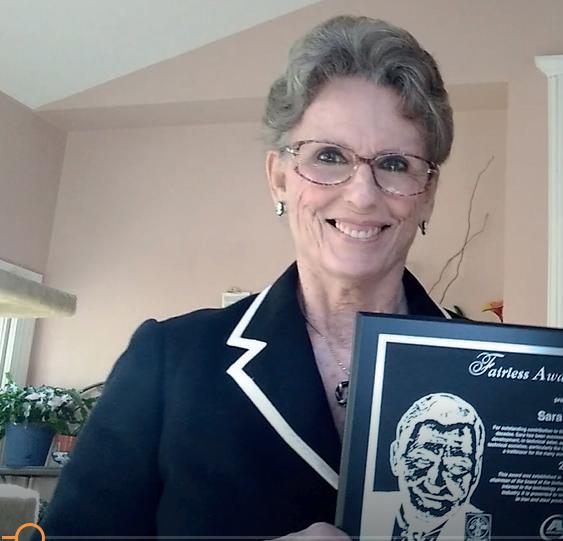
PROFILE 36 www.steeltimesint.com Digital Edition - February 2023
and president, Global Strategic Solutions **Editorial assistant, Steel Times International
*Founder
keynote presentation in Argentina. I’m curious about the beginnings of an industriousness that negates sleep – and Hornby begins by telling me that around the age of seven, ‘bored out of her skull’ in Wales, her parents decided to enrol her in boarding school. After two years, her family moved to America. While the international upbringing had its merits, the catch was, as Hornby said, that ‘they couldn’t put me in junior high school because I was only 10, they couldn’t put me in junior school because I was ahead of my age group. In the end, they placed me in the seventh grade’. This meant Hornby was three years younger than her peers. The school’s last word; ‘‘we’ll see if you fail’’.
‘‘And I didn’t!’’, said Hornby, laughing, saying that she was then placed on a ‘special math course’ and voted ‘most intellectual’ in school. After a few years, her family was posted to Aden, and she was placed in a different boarding school until they returned to the UK. Faced with a startingly different curriculum; with different boards, subjects, and fundamental academic approaches, Hornby ‘went on strike’. ‘‘That’s how I ended up at a polytechnic’’, she said, smiling at the dissonance between her acclaimed status within metallurgy, and the common, if not, perhaps unfair, perception of polytechnics as low-achieving. Her insufficient A-Level results culminated in a meeting with a careers counsellor, where she discerned what was available given an academic background that appeared to represent two entirely opposite people. According to Hornby, the counsellor brought up metallurgy, but ‘given that I was a woman, he said, you can’t.’ The counsellor, however, had not reckoned with another side to Hornby’s personality, where at school she would ‘break every rule without getting caught; climbing over fences and getting picked up by the police at 2am’. If Hornby was given an ultimatum, the chances were that she would find a way to disrupt the order – with the person making demands never even finding out. And so, Hornby went on to an interview at Sheffield Hallam for a degree in metallurgy.
At the interview, the issue of metallurgy being an all-male course was raised, to which Hornby’s mother, accompanying her due to her not being a fully licensed driver, commented that her daughter ‘preferred male company’. A sustained silence passed, and years later, Hornby said she discovered
that ‘because the only woman that had ever been in the engineering school got pregnant the first year and dropped out’, the interviewer had interpreted her mother’s statement as a foreshadowing of the past repeating itself. After Hornby completed her bachelor’s, and then her PhD, her interviewer – who was by then head of engineering – shook her hand as she received her certification, telling her: ‘‘I never thought you’d get your first degree, never mind your PhD. Congratulations’’. As to why Hornby made the decision to get a PhD, she said: ‘‘they’ve always said, you don’t need a PhD to be doing this job. Yes, I did, because most of the men didn’t take me seriously until I went back and did it.’’

This intensely gendered perception within the industry was often the case. Hornby described being ‘very respectful to customers….bowing down…and saying everything they said was true’ as a means to negotiate reciprocated respect. But, as she said, she grew ‘tired of the fight’culminating in a meeting in a foundry where she was trying to sell a new process to improve casting quality. The man who owned the foundry told her and her peers; ‘‘if your process is so good, be here tonight and prove it’’. What the owner never knew, however, was that Hornby had no equipment. This issue was solved in due course both ingenuously, and a little lawlessly, by the group robbing a medical truck for tools and buying saucepans and soup scoops from a hardware store to measure liquid nitrogen. In the end, Hornby and her team saved the owner $6,400 a heat on copper beryllium – and it was installed in the foundry as a permanent solution, and became an internationally patented process.
At another foundry, Hornby ‘did [her] spiel’, with the vice president ‘looking down his nose’ at her, going on to say that he didn’t have any rejects. Hornby, by her own words, ‘lost it’, packed up her bags, and curtly announced as she started to walk out of the room; ‘‘if you’ve got no rejects in your foundry, I suggest you patent it and make a lot of money, because you’re full of shit. Your reject rate’s probably about 6.85% – and until you realise that, I’m out of here.’’ After a shocked silence the vice president asked her how she knew the reject rate. Hornby simply stated: ‘‘I’m a metallurgical engineer’’.
It wasn’t only false perceptions that challenged Hornby’s career. When she
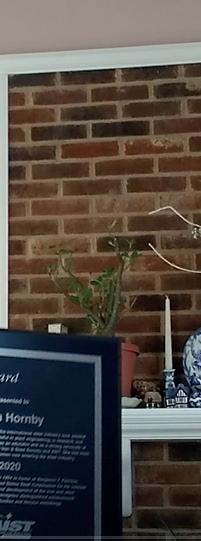
PROFILE 37 www.steeltimesint.com Digital Edition - February 2023
For 135 years, steel producers and steel service centers have counted on Butech Bliss to deliver the design, engineering and technological advantages necessary to help them succeed. From entry to exit end we build it all. Our product lines include roller and stretch leveling technology, a full line of shears, material handling equipment and complete coil processing lines. We are more than a scrap chopper manufacturer.

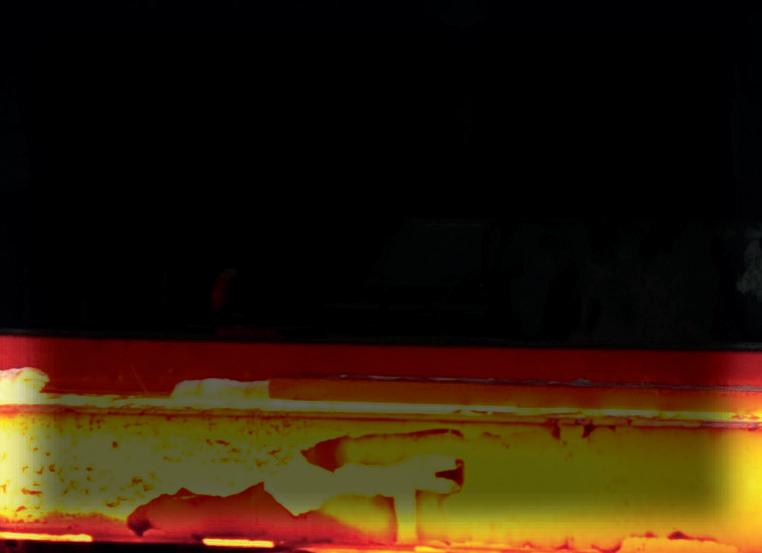

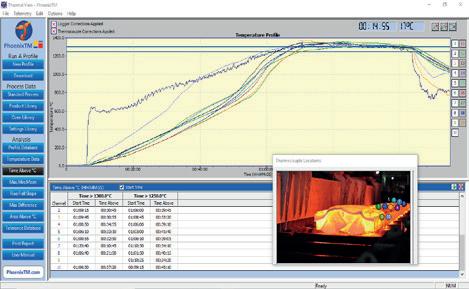

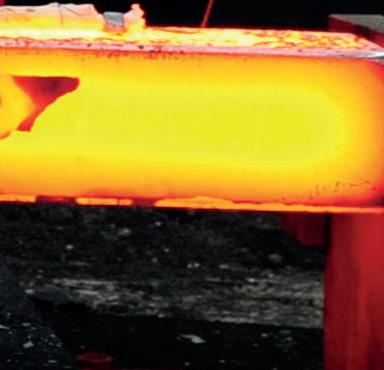




Learn more about our world-renowned coil processing technology call +1 (330) 337-0000, visit ButechBliss.com or email sales@butech.com.



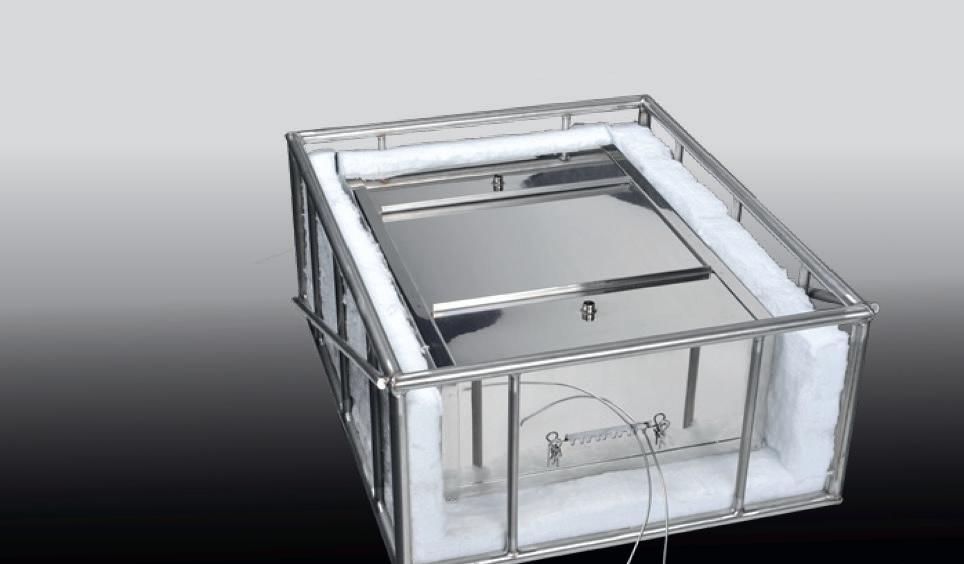
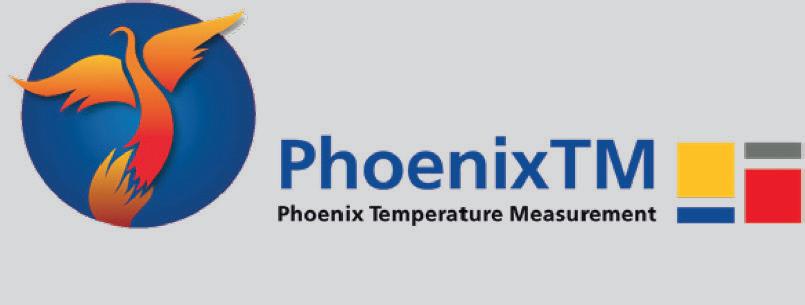



If our name is on the machine, it’s built better.

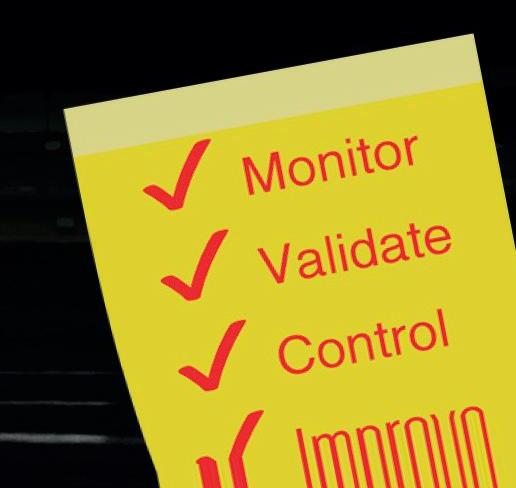


Temperature Profiling Solutions In the Steel Reheat Industry Comprehensive • Passes through furnace with Slab • Get an accurate Slab temperature profile • Measurement at up to 20 points • Live 2 way radio communications Safe • Safe system installation without production delays • Reliable protection of data logger up to 1300°C Easy • Optimise your process accurately • Validate your furnace mathematical model. PhoenixTM GmbH Germany info@phoenixtm.de PhoenixTM Ltd UK sales@phoenixtm.com PhoenixTM LLC USA info@phoenixtm.com Benefits • Optimise furnace programs • Save energy and increase production • Obtain optimal drop out temperatures • Minimise scale build up • Prevent hot roller wear & tear Where experience counts ! www.phoenixtm.com Delivering Innovative Solutions. Your Success Is Our Goal. Cut-To-Length Lines Crop Shears Rotary Shears Stretcher Levelers Hydraulic Roller Levelers Scrap Choppers
to building equipment to
We Build Things. Better. Salem, Ohio USA
When it comes
process ferrous and non-ferrous metals, nobody does it better than Butech Bliss.
was hired as a sales manager at an applied research laboratories in Luton, she was hospitalized and seven weeks later diagnosed ‘disabled’ with Crohn’s disease. Ten years later in Montreal, Hornby was challenged again by Crohn’s and 10 surgeries and around eight hospitalizations in 18 months followed. Hornby maintained her intense working schedule, travelling to see customers with a ‘wound in [her] belly from breast-bone to pelvic bone’ which she had to redress each night. ‘‘I wasn’t going to lie down and let [it] get the better of me’’, Hornby said flatly. It is hard to read emotion on a Microsoft Teams call, but I recognize a kind of gravity-defying performance that has become reality –where pain is a logistical barrier that can be overcome through the upkeep of close to impossible standards of work.
Doctors ultimately demanded Hornby consider a permanent ileostomy, but she phoned home for a second opinion from her original diagnostician, telling him ‘it didn’t make engineering sense’. Hornby
became a ‘guinea pig’ for a procedure involving intestinal splints – which had groundbreaking results. Once again, as she had done many times in both her personal and professional life, Hornby defied the standard – and the surgery worked for 26 years, a staggering amount over the usual 10-year cut-off point. ‘‘My life has been a challenge’’, she said. ‘‘If they say I can’t do it, I will. I was told I would be disabled for the rest of my life – I was told to accept it, lay down and find a hobby.’’ Hornby left the hospital and went back to work. Ironically, while still continuing her work, Hornby has sustained multiple hobbies and passions. She is a cat breeder, a fully qualified wildlife rehabber, police volunteer and has a lean six sigma black belt. Through the continued, dogged refusal of advice, Hornby has built a life that is as complex and multi-dimensional as the chemical reactions she studies.
Looking back, Hornby can’t help but reflect on the impact her gender struck within her career. ‘‘I’m now getting
invitations for all sorts of things,’’ she said, ‘‘but it’s taken 50 years to get there. I’m tired, I’m getting to the point where I’m too old to enjoy it, but it’s nice to finally be at that point where people are saying – you’ve got something to share even though you’re a woman’’.
It’s remarkable to consider what Hornby has achieved despite consistently gruelling conditions, but it is edged with a bitter note, of past realms of opportunity that will remain uncovered due to her gender. The world of steel is now, at least, traversable for women, but there is yet time to reflect on paths which were redirected, lives established through codes of gender rather than raw potential. There is an invisible history of young women sat in rooms, written over with societal determinations.
For Sara Hornby, however, life goes on; there is not time to reflect on the past, as she is busy preparing for another conference. The industry moves forward, as does its workers – and as Hornby tells me, there is much work to be done.�

PROFILE 39
“I’m now getting invitations for all sorts of things, but it’s taken 50 years to get there. I’m tired, I’m getting to the point where I’m too old to enjoy it.”
Fiona Turner* takes us behind the scenes – discussing a day in the life, working within the steel industry, and the challenges she has faced throughout her career.
What is your job title, and how many years have you held this role?
I am currently global head of product management, and have been since April 2022. Previously I was physics section manager since 2010.
What led you to your current role? Has it been a lifelong passion?
Developing new products is certainly my calling, and I have always been attracted to heavy engineering applications. The exact roles I have worked in have been more of a stepwise progression, though. After my BSc physics degree, my first job (developing vehicle-mounted railway surveying instruments) and subsequent PhD taught me skills in optics and instrumentation. I built on these skills over the years, producing systems and products for applications in chemical engineering, environmental and biological monitoring, and anti-counterfeiting before moving into infrared temperature measurement and control.
I always enjoyed designing and making a new system or instrument work in the lab, but for me the really rewarding part is seeing it really work for a customer in the – often harsh environment – of the field. This focus led me to further qualifications in usability.
What does a usual working day look like in your job role?
There is no typical day. I might have a site visit such as a steel plant, talking to customers about their requirements and how our current products might work better for them with some expert configuration. The next day I might be back in the office or lab, feeding site experience back to the technical team so we can optimise the design of new products to make them as valuable and easy as possible to use on-site. I always have emails to respond to, to support the global sales team on more technically complex customer
Changing tradition
enquiries – which of our products could be used in an unusual hard-to-measure application? What wavelength would be suitable for measurement in this process? If we don’t currently have a product, then perhaps we should, in which case I might start putting together a business case internally.
What are the greatest challenges in working in the area of physics? For infrared measurements of steel, reflective surfaces with low and changing emissivity and background radiation are always a problem. However, we physicists would be out of a job if life was easy… and I am very proud of the SPOT GS and its new algorithms that can measure galvanized steel from the liquid right through solidification to the galvannealing stages.
What is your proudest career achievement to date?
*Global head of product management, AMETEK Land
I am extremely proud of all my products in use today around the country and around the world.
What is your experience of the metals industry?
Positive. I have spent many days on site in aluminium and steel production facilities testing new spot pyrometers, thermal imagers and software. We like to perform real site trials before releasing any new product – I find we always learn something! Many of our new products at AMETEK Land are very application specific so have to be developed in close collaboration with customers.
product – I find we always learn something!
What is your experience of the steel industry?
We are often on customer sites and people are always lovely to us, very welcoming and helpful. Steel is the industry where LAND started 75 years ago, and it’s still the


INDUSTRY SPOTLIGHT 40 www.steeltimesint.com Digital Edition - February 2023
biggest industry we work with, developing our products with steel foremost in mind.






























I’ve worked with several different customers within the steel industry and it’s always been a very positive experience. The first steel works I visited was the Tata Steel site in Scunthorpe, soon after I joined LAND. It was still amazing to see great vats of spitting molten metal and the enormous scale of the building with the ladles trundling across overhead. All very impressive and dramatic!
We are also working with academic partners in research collaborations. The Advanced Forming Research Centre (AFRC) in Strathclyde, the Materials Processing Institute (MPI) in Middlesbrough, and Warwick Materials Group (WMG) at Warwick University are all fantastic places developing new materials, processes and technologies for the steel industry – and perfect sites for us keep up with their research and find out how our thermometers and pyrometers are performing in a live setting.
The amount of research and development going in the steel industry is encouraging, and something that I personally, as well as LAND, is keen to push forward.
LAND, is keen to push forward.
How do you feel about the current challenge to decarbonize steelmaking, and reach net zero – is it attainable?
and reach net zero – is it attainable?

of steel is that it is recyclable, but it does

if you have to heat scrap to over 1,500C
600C. Of course this is where LAND comes

It’s a difficult challenge for the steel industry due to the very nature of the temperatures required. The advantage of steel is that it is recyclable, but it does take a lot of energy to melt. The industry can move towards lower temperature processes for forming and forging, but if you have to heat scrap to over 1,500C to melt it, recycling will always require so much more energy than for aluminium, for example, with a melting point around 600C. Of course this is where LAND comes in – our products are designed to try to help, to monitor and control temperatures so at least there isn’t any energy wasted on overheating.
Has the field of physics, in your experience, been male dominated?


experience, been male dominated?

Yes, sadly only 10-20% of physicists are



















Yes, sadly only 10-20% of physicists are female.

The steel industry is still very maledominated too, more so compared to glass for example. I’ve worked with female process engineers in glass but not in steel. Steel is still very traditional but I hope this
dominated too, more so compared to glass for example. I’ve worked with female






INDUSTRY SPOTLIGHT 41 Digital Edition - February 2023






WWW.STEELTIMESINT.COM/SUBSCRIPTIONS DIGITAL + PRINT SUBSCRIPTIONS NOW AVAILABLE Get the steel industry's most informative read, direct to your inbox or letterbox. Subscriptions include eight issues a year, the annual directory, two additional digital supplements and much more!
will change. These days, mechanization and legislation have made it a much safer working environment where you don’t need to be particularly big and strong.
My personal theory is that there is a lot of subliminal conditioning as young people grow up. I hear phrases that ‘when the engineer goes on site, he will want….’ Or ‘when the customer uses this, he wants….’ If people talk like this at home in front of their children, the girls hear that the workplace is not a place for women.
Many steelmakers are currently citing the ‘war for talent’ as the greatest challenge to the steel industry – do you think this is the case within your sector also? If so, why might that be?
As per my answer above: I’ve been in a conference where speakers referred to all hypothetical workers and customers as ‘he’ in talk after talk. During question time, a delegate asked “what can we do to improve recruitment within the industry?”.
One obvious answer: by encouraging women from an early age to join. If we stop deterring women, we double the size of our recruitment pool. At the moment we are ruling out 50% of the future workforce. Currently, females who are really intent on physics within the industry tend to pursue a career in it, but we should be actively reinforcing the message that it is no longer a place for men only to work.
Has there ever been a turning point in your career,
which changed your outlook?
There are lots of little points. I could have gone into scientific or materials research. My PhD was with the Polymers and Colloids Group at Cambridge University, so focused more on materials science. However it involved building and programming instrumentation to perform measurements. I’ve traded on the skill of making the instrumentation rather than the pure research knowledge, using the experience and knowledge I’ve learnt.
The best thing about my career is that it’s taken me to see lots of industries, including aluminium and glass, as well as anti-counterfeiting and railway surveying instrumentation. You can use measurement instrumentation and optical and electronic instrumentation in all sorts of industries. Each change of jobs is a small turning point, which feels like a new career.

What is the most exciting aspect of your current role?
The site work – taking a new instrument on-site, meeting the customer and the real environment the instrument where it will be installed, and seeing it working in-situ.
We test in the lab and are excited when it works, but you can’t beat a successful onsite visit for a sense of achievement!
How do you think ‘hard to abate sectors’ will manage decarbonization, and do you think current guidelines are aiding the transition?
I don’t really know about the current guidelines, but in general, the amount of energy is extreme. We need to focus on new downstream processes and technologies that work at lower energy, plus renewable energy sources but as I mentioned before, with the high temperatures needed it is a very difficult challenge.
What inspires you to innovate in your role?
A vision of how it should be coupled with a touch of impatience! Seeing something wrong and realising how much better it could be. Plus seeing new technologies or seeing things working well in other applications and making connections. I love making things really work for the end customer; I’m very proud of all the systems and products I’ve helped create that are in use in the world today. �
INDUSTRY SPOTLIGHT 43
Digital Edition - February 2023
Advances in reheating furnaces
In any company within the steel industry, key goals will include increased productivity, efficiency and sustainability. To reach these targets, solutions are required that achieve specific goals – which starts with new technology built to meet the task.
IN today’s world, high efficiency and emission reduction are two closely related issues, which will continue to gain more attention in the future. The International Energy Agency (IEA) has set up a target to reduce emissions by 1.2 GtCO2/yr by 2050.
Fives, an international engineering group, has been developing new technologies and processes to meet decarbonization challenges, as well as to increase productivity and efficiency. The new technologies for reheating furnaces include the latest generation AdvanTek®, oxygen enrichment on/off burners, and an inductor coupled with Virtuo™, a proprietary intelligent thermal process optimizer. These solutions target capacity increase, surface quality optimization, reduction of emissions and OPEX minimization.
Increasing capacity
The latest generation of on/off modulating
By Brenda Chan*
wide flame burners, AdvanTek® MWF & CWF, can be perfectly integrated into an existing furnace to boost its capacity.
For example, adding two additional rows of AdvanTek® MWF into an existing recuperative zone and extra power on burners in a preheating zone can increase capacity by around 10% on one reheat furnace of 420 tph. Of course, having the reasonable modifications mean keeping the waste gas duct and stack, while the design of the recuperator and control process are upgraded to manage the extra volume of waste gas from the new burners. Fig 1
Installing AdvanTek®
A unique feature in the AdvanTek® MWF is the short or long stable wide flame under the same heat demand.
Meanwhile, when it is installed in a boosting zone, AdvanTek® MWF can play another function with its short flame
to make a homogeneous hot flue gas circulation in the recuperative zone. The aim is to heat the product not only within a shorter residence time, but also to get a better uniformity on temperature profile.
Fig 2
Thanks to this latest generation of burners, the NOx is reduced by up to 35% even if the power in the furnace is higher after revamping. This is, indeed, a win-win solution.
The high efficiency burner provides a homogenous flame temperature, and in addition, compared with other technologies, such as oxy-combustion burners or regenerative burners, its adiabatic flame temperature stays at a comfortable level. Thus, it can significantly increase the lifetime of refractory in furnaces.
Moreover, in order to meet the target of zero emissions by 2050, AdvanTek® burners * R&D engineer, Fives Stein, subsidiary of Fives

FURNACES 44 www.steeltimesint.com Digital Edition - February 2023
Fig1. AdvanTek®CWF
can be used with hydrogen. Fig 4 Fig 5
Advantages from AdvanTek® burners:
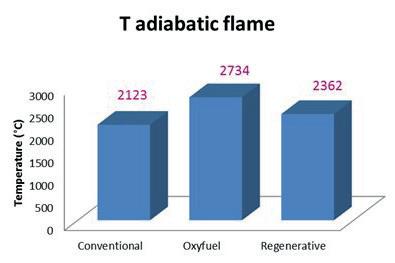
• Higher production
• Lower NOx emissions
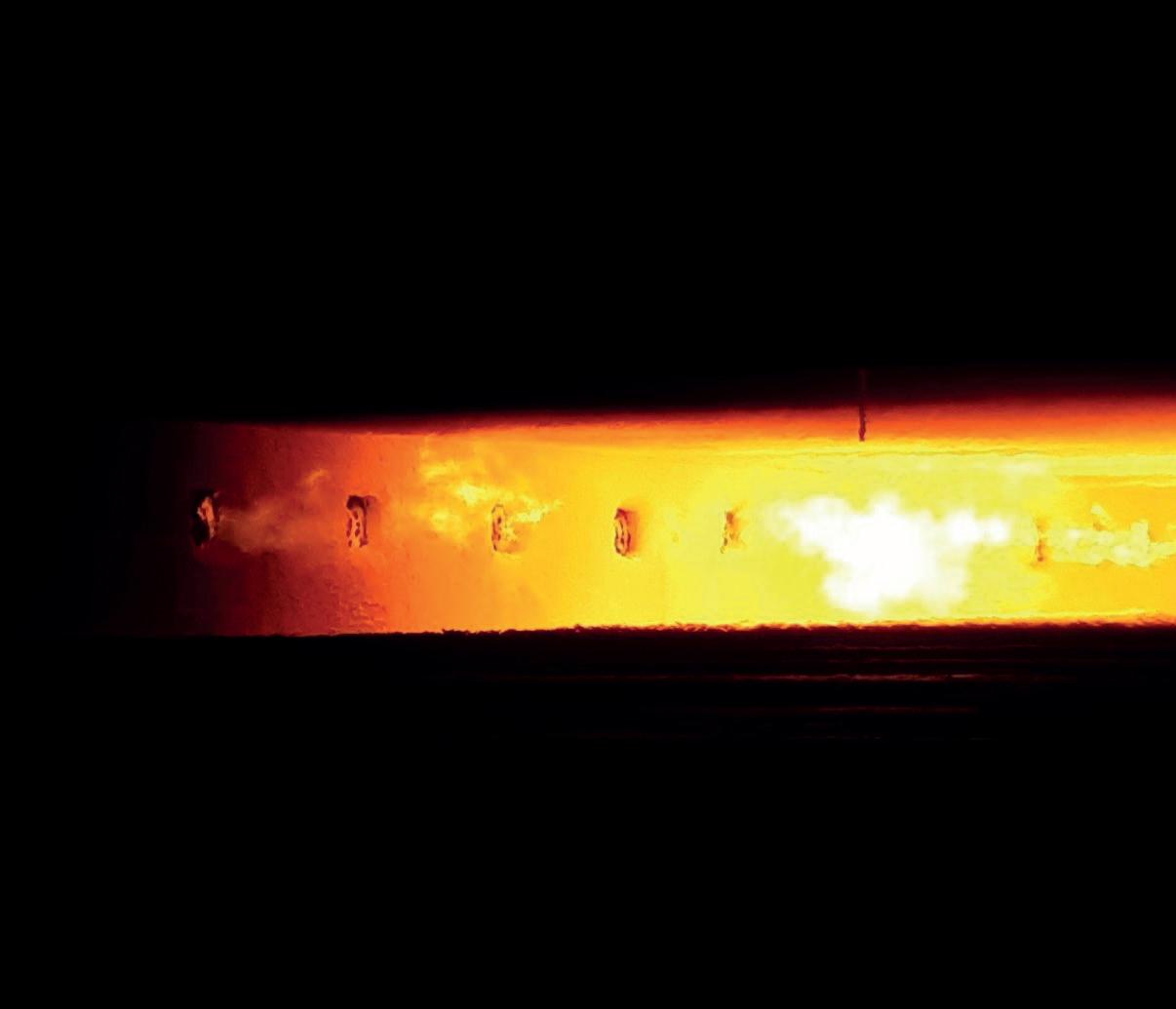
• Better longitudinal temperature
• Longer lifetime of refractory
Increasing capacity with clean energy

It is clear that the usage of the latest on/off digital burners in furnaces is not the only way to boost capacity. Induction equipment from Fives is a clean technology which can be easily integrated in the reheating process.
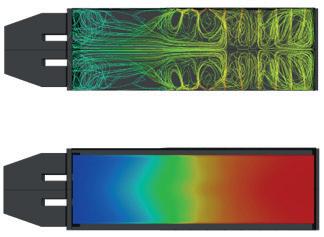

In the case of billets, blooms or H sharp reheating furnaces, an inductor can be installed at the charging side to preheat the products.

FURNACES 45 www.steeltimesint.com Digital Edition - February 2023
Fig 2. Case with only the standard on/off burners for boosting the furnace’s capacity
Fig 3. Case with AdvanTek® MWF for boosting the furnace’s capacity
Fig 4. Adiabatic temperature of flame
Fig 5. Flame in reheat furnace
Fig 6. Price evolution of natural gas since 2010
In order to implement a reasonable power of induction, Fives developed its proprietary inductor to preheat some critical products, therefore increasing ~10% of capacity.

Advantages:
• Increase the capacity up to 10% with high-flux induction
• Reduce CO2 emissions by induction heating: ≈9000 ton/yr
• Short erection time
Reducing gas consumptiom
Over 20 years ago, the use of oxygen in reheating furnaces was considered a relatively luxurious solution. Presently, as energy issues become a real challenge, the use of oxygen in furnaces has become a new trend.
Fig 6
However, oxy-combustion is not the only way to use oxygen for reducing gas consumption, as oxygen enrichment on the new or existing on/off digital burners is also a very flexible solution to reduce gas consumption.
According to the available oxygen flow rate and the steel grade of products which are heated in furnaces, oxygen enrichment
can be applied flexibly in different zones. The percentage of oxygen enrichment can also be adjusted to optimize the process.
As mentioned previously, a high portion of oxygen, such as oxy-combustion, brings a high flame temperature; it can be easily accepted by some standard steel
grades but might be suitable for other steel grades. That’s why a great flexibility of oxygen enrichment is needed to get the optimal heat quality and OPEX.
Controlling reheating
The speed of change in our market is always higher than our expectation or imagination. It is not easy to master the optimal process by relying on manpower alone, and evidence proves that digitalization can support us by easily collecting the process data and using it to grasp the ingenuity of the heating process.

Fives has developed intelligent digital solutions, such as Virtuo™-R and Virtuo™ OptiScale, to cope with the market expectations. Our aim is to provide maximum flexibility on furnaces to heat the products with a high quality by using these digital solutions in order to get the best OPEX with the optimal heating quality of product.

Virtuo™-R offers 2D or 3D simulation with products to provide heating curves and thermal balance of a reheating furnace. It applies the optimum heating strategy and set points based upon furnace design, fuel,

FURNACES 46 www.steeltimesint.com Digital Edition - February 2023
Fig 7. Surface inspection by Virtuo™ OptiScale
Fig 8. Co-operation between VirtuoTM-R and VirtuoTM Optiscale
burner type or product characteristics, and provides fully automatic control for continuous and reliable operation.


The result is not only optimizing productivity, but also optimizing gas consumption. Combining this solution with Virtuo™ OptiScale enables you to minimize the primary oxide scale and improve the surface quality of products.

Minimizing oxide scale
Burners are located along the side walls of the furnace to provide the heating function. The combustion is based mainly on natural gas. However, with the increase in the cost of natural gas, it has become common to burn other types of fuel, such as coke oven gas or blast furnace gas. These fuels generate hot waste gas with more impurities.
Meanwhile, the hot waste gas reacts with the surface of product during the process, resulting in the formation of a layer of oxides, called ‘primary oxide scale’. The different composition of waste gas has a direct impact on the type of oxide scale, such as adhering, non-adhering and sticky oxide scale.

Minimising scale loss

In order to control the oxide scale growth under a complex process in the reheating furnace, Fives installs a Virtuo™ OptiScale solution to minimize scale loss and optimize the surface quality of products.
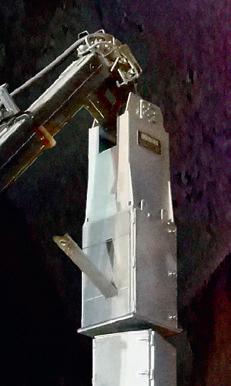
The functions of the new solution consist mainly in measuring, inspecting, analyzing the scale loss in real-time on discharged products, and then learning, predicting and controlling the oxide scale growth of products which are still being heated.
The Virtuo™ OptiScale offers a digital brain to process control systems in order to heat the products intelligently, thus meeting the expectation of the hot rolling mill and minimizing the primary oxide scale at once.



It is equipped with a measuring device based on an optoelectronics technology and a visual-measuring tool. Its role is to scan each product for measuring scale loss and generate the oxide scale cartography in order to perform a surface inspection.

Fig 7
Smart heating

A data-processing application uses the data from the measuring devices in real-time to optimize the reliability of results and ensure a high accuracy of scale loss measurement. The system collects all the characteristics and the heating curves of each product from Virtuo™-R, generating the database and enriching the digital expert knowledge.
Based on this data bank, a prediction model is built for providing the oxide scale growth expert knowledge to Virtuo™-R. The aim is to heat the products in a smart way in the furnace, in order to manage the oxide scale growth during the heat process, and to control the morphology of oxide scale during heating. Fig 8
Advances of Virtuo™

Advantages as a result include: optimized surface quality of products, minimized scale loss by up to 30% on existing furnaces, and improved OPEX, with products being heated intelligently, and precisely, with high quality being maintained. Processes are thus improved, while data is enhanced, increasing productivity and efficiency by using technological solutions. �

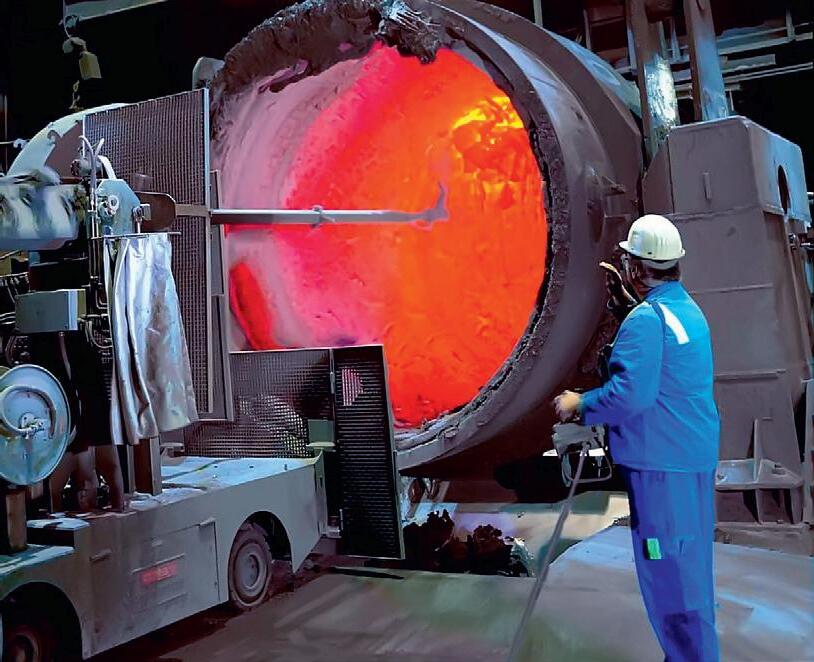
FURNACES 47 www.steeltimesint.com
GIFA/METEC 2023 June 12–16, 2023
Developing the future
The steel industry is always evolving says Mayra Molina*, which makes it both an exciting and fulfilling industry to work in – as barriers continue to be overcome, allowing its workers to develop a sustainable and digitally focused future.

I got started in the metals industry as an IT application analyst in Tenaris Tamsa, while I lived in Veracruz, Mexico. I was born and raised in Veracruz and obtained my computer systems engineering degree at the Higher Technological Institute of Veracruz. The next step of my metals career was as a senior business system analyst in Tenaris’ office in Houston, Texas. I have always worked within the technological part of the metals industry, so it made sense to move to PSI Metals North America Inc., the North American office of PSI Metals GmbH.
PSI Metals is part of PSI Group, a German software company that has various business segments made up of our sister companies like PSI Energy. We as a group develop and integrate complete solutions for the optimization of the energy and material
flow within utilities (energy networks, energy trading, public transport) and industry (metal production, automotive, mechanical engineering, and logistics).
We at PSI Metals are a leading provider of innovative production management software for the metals industry, combining supply chain management, advance planning scheduling and manufacturing execution systems within one service platform (SP). Our end-to-end solutions enable aluminium and steel producers to stay competitive by delivering tailored and configurable solutions. We support all processes such as planning, production, quality, and logistics. I play a significant role in this as a senior consultant, which means ensuring the implementation of successful projects. I achieve this by working with
*Senior consultant, PSI Metals
customers to meet their specifications. This means that I define custom development and configuration that leads to testing and commissioning. The team at PSI Metals North America Inc. is to credit for this.
PSI Metals North America Inc. is always recruiting and encouraging more women to join our team to contribute to the successful implementation of our projects. Women already play a role in the transformation of the metals industry. I always appreciate the opportunity to exchange notes with fellow women in the industry. This is why I try to attend events in which women working within the metals indutry can come together. At these events, women contributing towards their various companies’ journey towards decarbonization and sustainable
SOFTWARE 48 www.steeltimesint.com Digital Edition - February 2023
metals production can network and foster professional relationships. Furthermore, during these events, one can see how companies are encouraging the career progression of qualified and hardworking women. PSI Metals also shares this goal to promote and enhance diversity within the company, which is a core value. This makes me proud and enthusiastic about the future
face of this transformation. Her efforts include promoting the service platform and AppStore, which has led to an increased interest in purchasing licenses via the AppStore. As for the service platform, this new framework will enable us to provide our applications as modular offerings. It will enable us to make available and operate different parts independently (e.g. planning,
term ‘hybrid steelplants’ is where BOFs will step-by-step be replaced with EAFs and additional DRI smelters will be installed. The solution that we provide creates optimized routes and treatment schedules to handle the increasing complexity of the logistics in such a plant. It supports the smooth migration and transformation to sustainable production through the reduction of energy used and CO2 emitted in steel plants. This achieves various common KPIs currently in effect in the metals industry and clarifies what is expected when we say, ‘decarbonizing steel production.’
We also use AI to improve meltshop operations, as well as progressing with the use of machine learning to predict defect occurrences. This is executed with an optimization layer that exploits the predictive potential of the ML model and to correct the current production setting so that certain objectives, like avoiding the defect occurrence, are achieved.
It is my pleasure to work in PSI Metals North America Inc., and alongside women like Akriti Malla. We are a large, innovative, hardworking team and I do not just mean in PSI Metals, but also within the companies that make up our customers and partners.


increase of the number of women working in PSI Metals as a whole. Currently, we have women from differing professional backgrounds and cultures leading departments and divisions, as well as two women in our strategy committee – the top management group of PSI Metals. In the past two years, we have increased our employment of women (women being 35% of the employees in PSI Metals) by removing hurdles that may obstruct the employment of women from varying backgrounds. Opportunities to have access training to further hone their skills are also provided.
One of our success stories of hiring women from different backgrounds is Akriti Malla, our product manager of PSI Metals’ service platform and AppStore. She came from an IT background and is currently orchestrating the joint effort to transform our solutions digitally – a challenging task that is also part of PSI Software Group’s vision. She is responsible for delivering our product portfolio through the AppStore in collaboration with other colleagues. She was also chosen to champion this movement and be the
production, quality, logistics), as well as offer high integration between different parts of the application. Additionally, it will also enable customers to integrate any third-party application with our solution via the well-known PSI bus. This new solution aims at making our product vendor independent, extensible, and it promotes zero downtime during upgrades, and enhanced logging and monitoring. This is with the goal of strengthening security and enhancing the productivity of developers.
Supporting metal producers
Being a part of PSI Metals as a whole means that I contribute to the support of metals producers on their path towards decarbonization and sustainable steel and aluminium production. How do we achieve this? With great effort, such as in the case of the ongoing transformation from the classical blast furnace route to DRI-based and EAF steelmaking routes, we provide tools such as the PSImetals Online Heat Scheduler that can ideally be used in ‘hybrid steelplants.’ The coined
I, personally, enjoy fostering good relationships with my team and project partners. Teamwork is one of PSI Metals values and it does assist us in achieving our goals and our customer goals with our solutions.
In addition, as a woman working alongside and offering support to the metals industry, I am delighted to be a huge part of a great movement to transform and improve the production of steel products for the years to come.
I understand that it is still not commonplace to have many women working in the metals industry despite the continuous improvements. It is, however, exciting to see the further increase in our numbers due to further accessibility and the garnered interest from those still choosing their careers in universities.
I look with hope towards a future where it is normal to have 50% of the workforce in steel companies dominated by women and where there are fewer to non-existent barriers. It is an interesting and fulfilling career, which is my humble recommendation to qualified and interested women who consider this industry that has provided me with contentment in my professional life. �
SOFTWARE 49 www.steeltimesint.com Digital Edition - February 2023
Mayra Molina, senior consultant, PSI Metals, and Akrita Malla, product manager, PSI Metals
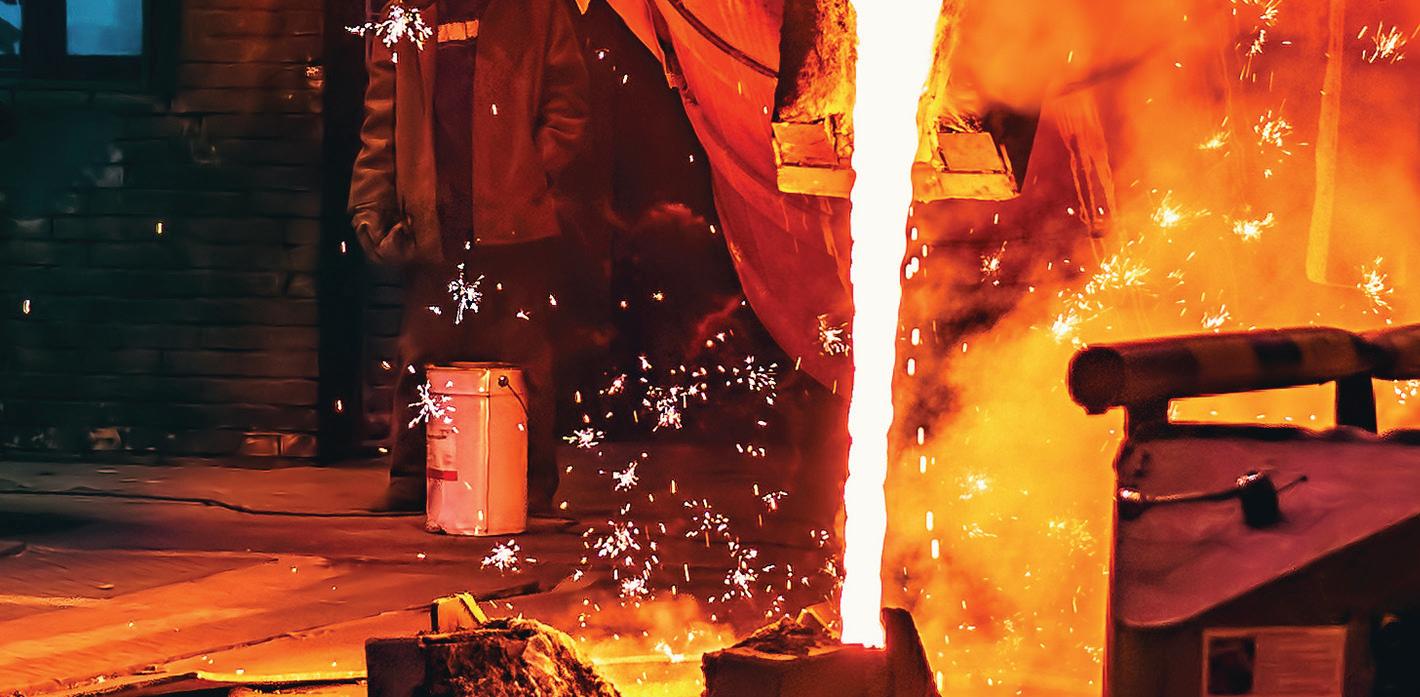


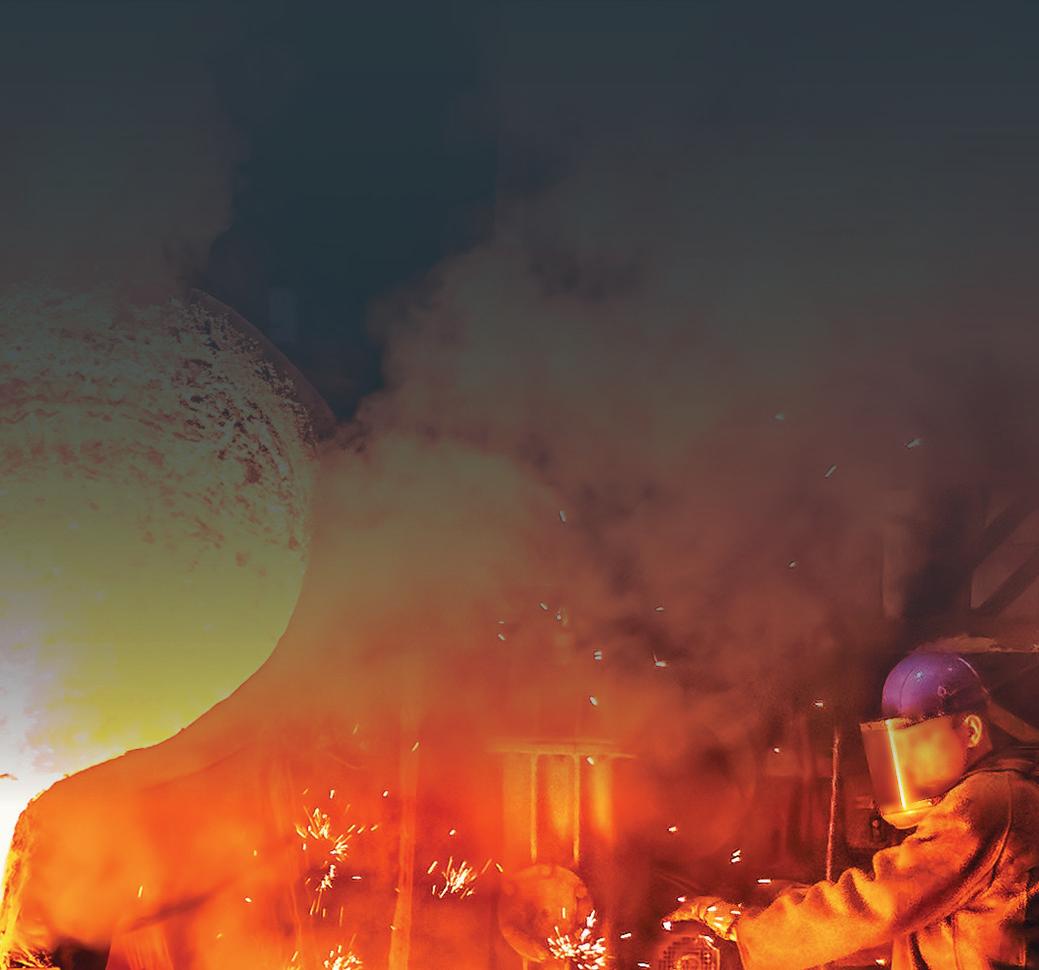

Furnaces International brings readers a selection of technical features focusing on all aspects of the international furnaces market, as well as industry news, investments, and the latest products and projects Published quarterly in a digital format, Furnaces International and the new monthly newsletter, are sent to the inbox of over 25,000 industry professionals. As publishers of Aluminium International Today, Steel Times International and Glass International, we are able to compile this knowledge and bring you the latest developments on: • Energy Efficiency • Hot Repairs • Maintenance • Heat Treatment • Thermal Processes • Testing and Measurement CONTACT US NOW: Esme Horn Sales Manager +44 (0) 1737 855136 esmehorn@quartzltd.com Nadine Bloxsome Editor, Furnaces International +44 (0) 1737 855115 nadinebloxsome@quartzltd.com Zahra Awan Editorial Assistant +44 (0) 1737 855038 zahraawan@quartzltd.com WWW.FURNACES-INTERNATIONAL.COM SIGN UP TODAY TO RECEIVE YOUR FREE COPY Look out for the December issue which contains The Furnaces International Buyers’ Guide. It is the essential guide to furnace manufacturers and suppliers of furnace equipment and services to the industrial heating/ process industry.
Pedal to the metal





DECARBONIZATION 51 www.steeltimesint.com Digital Edition - February 2023 *Head
material
**Principal
and raw material
***Principal
and raw material
of steel and raw
markets
analyst, steel
markets
analyst, steel
markets
Iron and steel’s US$1.4 trillion shot at decarbonization. By Malan Wu*, Mihir Vora**, Isha Chaudhary***
Iron and steel’s $1.4 trillion shot at decarbonization
The industrialised world cannot function without steel. It is essential to everything from the buildings we live in to the ways we get around. Wood Mackenzie estimates that meeting global steel demand will require 2.2 billion tonnes of production by 2050 – a 15% increase from 2021.
From iron ore mining to steel manufacturing, the industry is highly carbon intensive. And while steel itself is recyclable, iron and steel production emit a combined 3.4 billion tonnes of carbon annually, equal to 7% of global emissions.
The steel industry, therefore, faces a huge challenge in achieving net zero emissions by 2050. Under our 1.5 °C Accelerated Energy Transition Scenario (AET-1.5), which is broadly aligned with the most ambitious goal of the Paris Climate Agreement, the decarbonization of the iron and steel sectors will require around $1.4 trillion of investment.

The iron and steel industry will also require support from global carbon policy. To date, most national carbon markets are nascent and concentrated in mature economies. As more than 60% of steel production carbon comes from China, Beijing must implement aggressive carbon pricing and taxation if steel’s high carbon footprint is to be addressed.
The European Union’s (EU) carbon border adjustment mechanism and the potential for similar moves by other major economies could support faster change in producing countries such as China and India. But even with the successful global roll-out of wider carbon border taxes, the upside impact may be limited – only 20% of global steel consumption is traded.
The willingness of consumers to pay a premium for green steel will be another challenge. While investor pressures on large multinational consumers (such as automakers and heavy machinery manufacturers) is having some impact, the construction industry is still largely unreceptive to green price hikes.
But the scale of the challenge offers enormous opportunities, too. Decarbonizing steel production will require a revolution at every stage of the industrial value chain, from mining to consumption. To achieve net zero by 2050, three-quarters of steel production will have to use lowcarbon technologies. Sectors including renewable power, low-carbon hydrogen

DECARBONIZATION 52 Digital Edition - February 2023
“The largest factor in achieving net zero for steel to electric arc furnaces (EAFs).
“Competitively priced green hydrogen at scale
“Of the top 25 steelmakers, only 13 have set a date for achieving net zero.”
will be switching

and carbon capture utilisation and storage (CCUS) will be major beneficiaries of the industry’s move towards net zero emissions.
The scale of the challenge
Wood Mackenzie’s base-case energy transition outlook foresees an average global warming outcome of between 2.2 °C and 2.4 °C by mid-century. Under our AET1.5 scenario, we assume that the iron and steel industry successfully decarbonizes to achieve global net zero emissions by 2050. This 1.5 °C pathway requires 2050 steel emissions to fall by more than 90% from current levels.
This is a staggeringly big ask, given that our base-case steel emissions scenario assumes a decline of just one-third from current levels by 2050. There is an urgent need to act now to decarbonise the iron and steel industry, and business as usual is no longer sustainable. In this article, we analyse the what, when and how of getting to a 2050 net zero pathway.

The largest factor in achieving net zero for steel will be switching to electric arc furnaces (EAFs) from the blast furnaces (BF-BOFs) that dominate current production and emit up to four times more carbon. To reduce emissions to the degree required, EAFs will need to be powered by renewable energy, demonstrate greater energy efficiency and elevate the quality of metallics.
Ultimately, the industry must pursue a complete switchover from predominantly hydrocarbon-based energy to renewable power along the value chain, from mining to steelmaking. In parallel, the industry needs to increase its use of less carbonemissive feedstock, such as green hydrogen and scrap, in steelmaking. The availability of competitively priced green hydrogen at scale is a must in delivering decarbonization goals. Commercialising new technologies, such as hydrogen-based direct reduced iron (DRI) and molten oxide electrolysis running on renewable energy, could reduce emissions to zero.
Carbon management through the development and deployment of CCUS will also need to play a key role in offsetting unabated emissions, though this will tail off in the long term as newer technologies that eliminate carbon emissions achieve commercialisation.
Quantifying the scale of this challenge is sobering:
• The industry will require around
50Mt/yr of competitively priced green hydrogen. Commercial viability versus conventional steelmaking routes require green hydrogen supply at $2/kg.
• Switching to clean energy will require around 2,000 GW of dedicated renewable generation capacity, equivalent to two-thirds of current global renewable generation capacity.
• High-grade iron ore consumption will have to increase fivefold to 750Mt.
• Transitioning to greener feedstock will require a doubling of the global scrap pool from current levels to 1.3 billion tonnes (entailing recovery rates of more than 80%).
• The industry will need to capture and store 470Mt of carbon to reach its emission target.
Regional differences remain
A quick glance at iron and steel producers’ climate change reports reveals that only the largest have publicly set out a green pathway. Of the top 25 steelmakers, only 13 have set a date for achieving net zero and only a handful have committed any capital to the cause.
The top five iron ore miners have also set net zero targets, with three committing to intermittent capital outlay until 2030. These three miners aim to spend $16-17 billion through 2030 to shave 30-35% off their operational emissions, translating into a little over 10% of their annual capital budgets.
However, mid-sized and smaller players have yet to make any noise on the green front, never mind any capital allocation. An increased focus on carbon emissions by these companies will be ensuring their longer-term survival, particularly until a green premium on steel rewards investment in decarbonizing their production.
Footing the bill for a green steel value chain
Achieving net zero by 2050 presents a $1.4 trillion investment opportunity for players across the iron and steel value chain. This will entail upgrading existing steelmaking routes, adopting new technologies and offset measures and exploring new highgrade iron ore mines.
Of the $1.4 trillion investment:
• $800-900 billion will be essential to greening existing steelmaking infrastructure, setting up new DRI and EAFs and developing a hydrogen ecosystem for steel.
DECARBONIZATION 53 Digital Edition - February 2023 steel
(EAFs).”
scale is a must.”
“Chinese steel emissions must fall by more than 95% from current levels by 2050.”
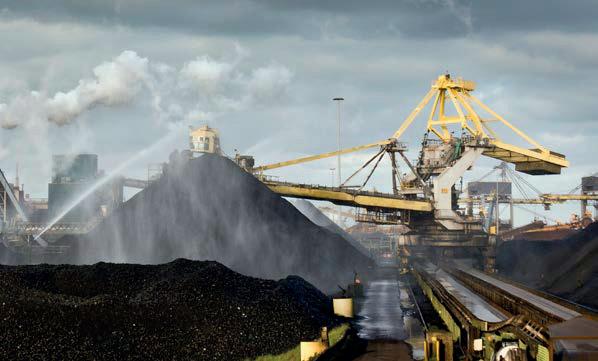
DECARBONIZATION 54 www.steeltimesint.com Digital Edition - February 2023 * Current supply - limited million tonnes 52 Green hydrogen Scrap pool 2x current supply million tonnes 1,300 2/3 of current renewable capacity giga watt 2,000 Renewable capacity High grade ore DR pellet feed 5.5x current demand million tonnes 750 Current supply - limited million tonnes 400-500 Carbon capture
Wood Mackenzie *Renewable capacity includes hydro, solar, wind, geo-thermal, and bio-energy -
Source:
Fig 1. Multiple ecosystem enablers to be activated
• Miners will need to play an active role in cutting operational emissions and investing in new high-grade mines and DR pellet capacities, all of which translate into a $250-300 billion investment.
• These measures will still fall short of emissions targets, necessitating an incremental $200-250 billion investment in carbon offset measures, such as CCUS.
Regional disparities to emerge en route to net zero
China accounts for around 62% of global steel emissions, so any chance of steel decarbonization success will depend on its commitment.
Chinese steel emissions must fall by more than 95% from current levels by 2050 to reach the net zero target. This would appear to be an insurmountable task, given that 90% of the nation’s steel production is through the highly polluting blast furnace route. Chinese steelmakers will have to balance managing a relatively young fleet of blast furnaces and investing in new, greener steelmaking technologies.
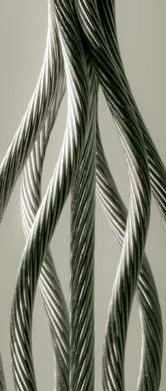
Beijing’s steel output curtailment policy has helped to improve the nation’s emissions profile. Such indirect control measures will continue to support decarbonization in the long run. China’s decarbonization efforts will also be helped by falling demand as its economic growth slows. Along with China, mature economies, such as the EU, the US, Japan and South Korea, will have to front-load steel investments in the first half of the forecast period. In contrast, India, South America and Southeast Asia are unlikely to make significant investment in green steel until around 2035.
Two-thirds of the investment by iron ore miners will be dedicated to the exploration of new high-grade ore mines and abating emissions from existing operations. Forward integration into pellet manufacturing for DRI manufacturing capacity will consume the rest.
Capital investment is only one piece of the puzzle, however. Steelmakers will also have to shoulder additional operating expenditure for newer, low-emission
DECARBONIZATION 55 www.steeltimesint.com Digital Edition - February 2023
High-grade Existing BOF EAF MOE DRI Green hydrogen 63% 37% 100% 100% 56% 44% 54% 34% 12% Iron ore mining DR pellet Iron making Steel making Carbon offset 150-200 75-125 350-400 450-500 200-250 woodmac.com | Pedal to the metal: Iron and steel’s US$1.4 trillion shot at decarbonisation Fig 2. Iron and steel investments to reach net zero by 2050 (in US$ billion) Source: Wood Mackenzie Note: Iron ore mining investments include capital investments on decarbonizing existing mine sites and developing new high-grade ore mines. DR pelletisation includes capital investments to set up new DR-grade pellet capacities. Iron making includes setting up DRI furnaces and hydrogen ecosystem (electrolyser, hydrogen storage, etc.). Steelmaking refers to BOF, EAF, and MOE furnaces.
“Carbon taxes will make up a significant chunk of green premiums up to 2035.”
technologies and carbon taxes on unabated emissions. We believe that, down the line, steelmakers will recover these costs in the form of green premiums.
Green premiums are inevitable
With the cost and pace of decarbonization varying by region, mature economies will decarbonise quicker than their emerging counterparts, though they will incur higher carbon abatement costs. We estimate that steelmakers will have to cough up $100 per tonne, or about 15-20% of their total production cost, to align themselves with a 1.5 °C goal by 2050.
Mature steel-consuming economies will end up spending 1.5 times more than emerging economies. India and Southeast Asia, being highly cost-sensitive markets, will adopt a more cautious approach to decarbonization. These regions are less inclined to invest capital in
upcoming green technologies. We believe emerging economies are more likely to follow the evolving green trends once commercialisation has been achieved, translating into lower abatement costs.

The carbon abatement cost comprises green premiums from capital expenditure on green projects, higher operational costs due to the switchover to new technologies and a carbon tax on unabated emissions.
Carbon taxes will make up a significant chunk of green premiums up to 2035. The proportion will decline in the longer term with the deployment of new, cleaner steelmaking technologies. As the technological curve matures, capital and operational expenditure will rise. Adopting new steelmaking technologies will boost the share of capital expenditure in the 10 years to 2050 to 5%. Operational spending will contribute heavily to carbon abatement costs as new technology adoption sees

steelmakers incur higher production costs than conventional routes.


The least emission-intensive technologies (such as scrap-EAF and hydrogen-DRI-EAF) will move up the cost curve in tandem with the rise in raw-material and clean power costs. They will also be subject to less carbon tax, however, as their emission footprints will be far lower. The green premiums may lessen, but they cannot be done away with entirely.
Ultimately, it is the consumer who must pay. The tail end of the value chain will bear the brunt of green premiums. Steelmakers will have to swallow the green hikes in raw material costs (for example, iron ore) and, in all likelihood, pass on their carbon abatement costs to steel end-users.
No silver bullet for miners
Miners will have to play their part by decarbonizing mining sites and investing in new high-grade ore mines to support green steel. Demand for high-grade, low-impurity iron ore will grow fivefold over the next three decades under an AET-1.5 scenario, necessitating logistically challenging and expensive mining projects, especially in Guinea and Brazil. Failure to successfully unlock these resources will heighten the risk of raw material shortages.
Commissioning any new mining project involves myriad unknowns; the addition of environmental, social and governance (ESG) risks is merely the latest. Portfolio diversification towards high-grade ore mines, the divestment of polluting and low-grade mines, and investments in beneficiation and floatation will be at the heart of miners’ strategy to stay relevant in the green game.
56 www.steeltimesint.com Digital Edition - February 2023
0 20 40 60 80 100 120 2022202520302035204020452050 US$/tonne
Carbon taxes Capex Opex Carbon abatement cost
Source:
Wood Mackenzie
Fig 3. Steel – carbon abatement costs under a 1.5°C pathway
Fig 4. Iron ore requirements under our AET-1.5 scenario. High-grade ore/DR pellet feed demand and supply – AET 1.5
Of the current supply hubs, Brazil has the greatest potential for green iron ore products, thanks to the prime quality of its ore. Elsewhere, FMG’s soon-to-be commissioned Iron Bridge project and the recently announced Hawsons Iron project will be critical if Australia is to compete in a 1.5 °C world. Any expansion by other high-grade ore producers, such as Sweden and Canada, will increasingly feed rising captive demand for hydrogen-based DRI projects in their regions. The contentious Simandou project in Guinea will help the country unlock its potential, especially given the large scale of the operation and the potential to produce high-grade direct shipping ore.
Forward integration
The search for high-grade mines, along with miners’ plans to integrate forward into DR pellet and hydrogen-DRI manufacturing, will open up new supply opportunities and
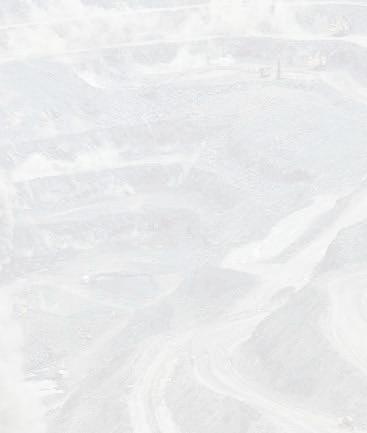
alter trade flows. Brazil and Africa look set to emerge as key net exporters for DRI and DR pellet/pellet feed, while Australia and the Middle East will try to keep pace. The EU, China, Japan and South Korea would be the usual suspects for higher incremental demand for DRI and DR-grade pellets. India and the CIS will also add capacity but will be domestically centred markets.
Solving the net zero equation
Governments and large companies are increasingly committing to net zero targets but can’t refrain for long from pursuing short-term efficiency measures and longterm technological investments.
What should iron ore miners do?
The mining community will have to work closely with steelmakers to support the latter’s decarbonization drive. Miners have already signed multiple technical collaborations with steelmakers across the EU, Japan, South Korea, China and India to develop greener products.
They could consider a three-point strategy:
• Invest in new technologies and highgrade mine sites
• Divest from carbon-intensive operational mechanisms and portfolio diversification (product and energy mix)
• Integrate further into the steel value chain (pelletisation, green-DRI and green pig-iron).
There are ways and means – some of which are works in progress – to develop a zero-carbon mine. Switching over to green electricity, blending biofuels and implementing other operational efficiency measures at mine sites will guide the decarbonization strategy in the near term. Investments will also have to be made to electrify the mining fleet (battery) and develop hydrogen fuel-run haulage trucks. Some of these capital investments are just beyond cost and will be bottom-line accretive in the long term.
What should steelmakers do?
Near-term efforts will have to involve a mix of the following elements:
• Resource efficiency: blend more scrap, ferro-coke, high-grade raw materials and biomass into existing steelmaking
• Energy efficiency: top-gas recycling, heat recovery, invest in renewable energy
• Optimisation of current and new
DECARBONIZATION 57 www.steeltimesint.com Digital Edition - February 2023 Source: Wood Mackenzie 800 700 600 500 400 300 200 100 0 2021 2030 2040 2050 Demand Supply 152 301 503 758 Where will the incremental supply of high-grade ore originate from? SwedenNorth America Brazil Iran China Australia Russia and Ukraine Africa Key seaborne exporters Unsuitable grade Swing grade depends on mineralogy Moderately rich grade needs basic processing Prime grade ore Grades of ore:
“Brazil and Africa look set to emerge as key net exporters for DRI and DR pellet/pellet feed.”

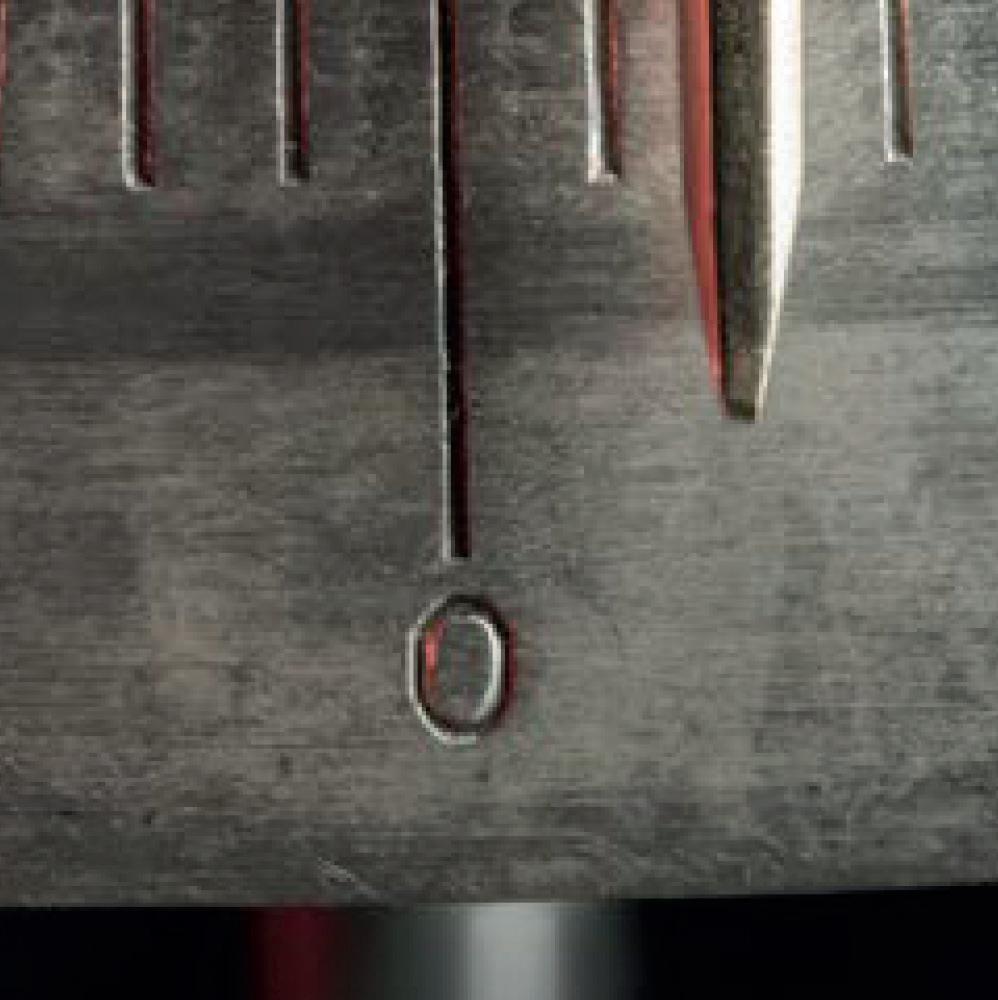







58 www.steeltimesint.com Digital Edition - February 2023 Switch to green energy and Scrap-EAF Switch to green energy Mine electrification (battery run) Molten Oxide Electrolysis Trucking / transport innovation (H2 fuel cell) Resource and energy efficiency Operational efficiency Biomassinjections in blast furnace CCUS (carbon offset)
(carbon
Hydrogeninjections in blast furnace
CCUS
offset)
5: How can steelmakers and miners decarbonise? Steelmakers Miners Emission reduction potential Commercial readiness Emission reduction potential Commercial readiness woodmac.com | Pedal to the metal: Iron and steel’s US$1.4 trillion shot at decarbonisation 13Fig 5. How can steelmakers and miners decarbonize?
Source:
Wood Mackenzie Figure
iron making until it reaches commercial scale.
These measures will only trim carbon emissions by 15-25%, so the development and commercial deployment of newer technologies, such as hydrogen and CCUS, will have to happen in tandem to make large-scale cross-over feasible in the long term.
Net zero is not risk-free
Achieving net zero will entail a fundamental transformation of steel and its value chain and is, therefore, fraught with risks. These include:
• Fragmented geographical implementation, which could disrupt trade patterns and lead to the underutilisation of younger furnace fleets in emerging
the last few months (this could become more frequent under faster energy transition scenarios and impact the costs of steelmaking)
• Green premiums and the ensuing cost inflation could hurt steel demand from price-sensitive consumers

• Greenwashing by iron and steelmakers under the guise of ESG compliance

Collaborative action globally
Thus, the transition calls for collaborative action globally and a unified approach across the value chain to turn risks into opportunities. Iron and steel’s low-carbon diet will create rich opportunities and inclusive growth for parallel industries, including:
under AET-1.5 over the next three decades)

• Players across the hydrogen ecosystem, which will need to produce a dedicated 52 Mt for the steel industry (electrolysers, hydrogen storage, transport)
• Green energy producers and solar/ wind equipment manufacturers (2,000 GW of dedicated renewable capacity by 2050 for the steel sector under AET-1.5)
• Electric vehicles and hydrogen-run haulage trucks at plant and mine sites for transportation
• Other technical support services
There is no precast solution to the net zero puzzle, but individual and collective approaches by companies, governments, policy institutions and citizens will help determine green action. �

Let’s inspire together Act now
DECARBONIZATION 59 www.steeltimesint.com Digital Edition - February 2023
Industry renaissance
An uncertain global outlook isn’t all doom and gloom, says Mary Lucarino*, as necessity is the ‘mother of invention’ – meaning that at HarbisonWalker International, challenges inspire innovation, accelerating growth despite complex market conditions.

1. How are things going at HWI? Is the steel industry keeping you busy? Things are going well. We had a really great 2022. 2023 is looking to be just as busy with all the expansion and greenfield capacity projects underway in our domestic market. We are also very excited to be commissioning our newest plant in Alabama to produce magnesia carbon refractory bricks. The new plant will also be a services hub to further support our Southern US customers.
We are thrilled about HWI’s plans to be acquired by Platinum Equity, a global investment firm. The transaction is expected to be completed in the first half of 2023. This is very positive news for our customers because our new owners share our leadership teams’ vision to aggressively accelerate investments in our business. Our employees, customers, and communities will all benefit from our growth.
2. What is your view on the current state of the global steel industry?
I’d like to feel optimistic, considering steel plays a vital role in our daily lives. In the US market, we are in the middle of a 10-year, >$20 billion expansion in steelmaking capacity incorporating stateof-the-art technologies with a real focus on sustainability. However, the global outlook is a little more uncertain, given the geopolitical issues (war in Ukraine, pandemic, high inflation), resulting in an overall decrease in the near-term steel demand.
3. In which sector of the steel industry does HWI mostly conduct its business?
As a full-service refractory supplier, we participate in all sectors and refractory applications within steel production. Outside of refractory production, HWI has a proud history of providing service support
to our customers. We are a full solutions supplier to our domestic market and are looking forward to expanding the breadth and reach of our service solutions across all the markets we serve.
4. Where in the world are you busiest at present? North America, United States.
in their prospective categories and applications.
7. What are your views on Industry 4.0 and steelmaking and how, if at all, is HWI using it?
As a refractory manufacturer, we are embracing 4.0. We’re gathering data that is pertinent to refractory performance in our customers’ processes. We employ advanced sensor technology, such as in-process laser scanning and infrared mapping. We’ve also developed IP for a measurement system to predict refractory wear. This will create opportunities to improve refractory performance and process efficiencies within safe parameters, reducing the risk of a loss of containment.
8. What are the greatest challenges in decarbonizing steel production?
I think, depending on geography, one of the challenges will be having a renewable energy supply that is abundant and affordable and the infrastructure to support it. Other challenges include the ore feedstock, skilled labour force, and cost/ funding.
5. Can you discuss any major steel contracts you are currently working on?
It wouldn’t be appropriate to discuss open projects at this time, but we are working with several major producers to provide advanced sensor technologies and application equipment through our Value Added Services (VAS) team.
6. Where does HWI stand on the aluminium versus steel argument? We supply both markets/manufacturers… so it’s hard to have an argument with a customer!
Both have their attributes and benefits
Another challenge will be improving or finding more efficient and cost-effective processes. Collaboration and commitment with upstream and downstream operations will be important too.
US steel producers are the most efficient producers from the number of manhours it takes to produce a ton of steel to the CO2 emissions generated per ton of steel produced (+70% of steel produced is from recycling steel scrap via EAF).
Historically, HWI has always focused on engineering optimal linings designs to reduce refractories consumed per ton of steel produced. When considering Scope 3 emissions, one of the biggest impacts we have in the US is that our production footprint puts us in close proximity to
PERSPECTIVES Q&A: HWI 60 www.steeltimesint.com Digital Edition - February 2023
*Applications specialist, integrated mills, HarbisonWalker International
Mary Lucarino
our end users. This reduces the emissions associated with the logistics of product supply to our customers. Our R&D team is also developing refractory products that will be more easily recycled. This is very exciting when considering closed-loop supply opportunities.
9. How quickly has the steel industry responded to ‘green politics’ in terms of making the production process more environmentally friendly, and are they succeeding or fighting a losing battle?
At least here in North America, the industry has been making changes for some time now. Some of the more recent examples are the construction of facilities for HBI, DRI plants for supply, conversions of integrated mills to electric furnace facilities, and facility improvements that reduce emissions.
As a company, in 2021, HWI launched its employee-led Sustainability Journey to focus on ESG challenges, including actions to reduce our carbon footprint by utilizing sound processes that minimize environmental impact.
10. Where does HWI lead the field in terms of steel production technology?
HWI refractory products are the benchmark for quality and performance in our industries. We are at the forefront of refractory technology R&D, continually working on advancements in new product development, engineered refractory and equipment solutions, innovative designs, and services that will support our customer’s steel production needs.
11. How do you view HWI’s development over the short-tomedium term in relation to the global steel industry?
I believe we are in lockstep with our industries’ ESG initiatives with our employee-led sustainability programme. We’re driving ever-improving process efficiencies with our advancement in data analytics, allowing our customers to make more informed decisions as they pertain to their in-process refractory programmes.
12. China dominates global crude steel production and is accountable for almost half of world steel production. How should the industry react to this situation?
Aside from supporting various trade
protections, where appropriate, the US steel industry will likely continue to implement sustainability into its manufacturing processes and demonstrate its global competitiveness.
13. Where do you see most innovation in terms of production technologies – primary, secondary, or more downstream?
There is a substantial effort being made to electrify steelmaking, whether you are talking about development of both iron and hydrogen production via electrolysis or the more traditional move to secondary or EAF steel production. It’s a renaissance period in our industry!

14. How optimistic are you for the global steel industry going forward and what challenges face global producers in the short-to-medium term?
I’m optimistic. There will always be a need for steel, and forecasts continue to show demand growth. Some of the challenges are going to be finding ways to implement sustainable decarbonisation policies, and responding to changing demand, aligned with iron ore and scrap supply.
15. What exhibitions and conferences will HWI be attending in over the next six months?
HWI will be participating in the AISTech in Detroit this May for the steel segment, along with many other events in early 2023.
16. HWI is headquartered in the US – what’s happening steel-wise in the country?
Globally we are all dealing with the same issues in some form or fashion, high inflation, the war in Ukraine, and so on, and the impacts they have on steel demand and supply chains. However, there is always something exciting happening, from upgrades and expansions to new construction and new process developments. They say, ‘necessity is the mother of all invention,’ and the challenges we face in our markets drive investment in their solutions. It’s inspiring to see the investment in new ironmaking technologies and green energy options to power our industry now and in the future.
17. Apart from strong coffee, what keeps you awake at night?
Usually, I try not to let much worry me. There are some nights when I do spend more time thinking about my family, their situations, health, and success for now, and their future. And at times, I’m contemplating my work, my customer’s installations, projects, designs, performance…
18. If you possessed a superpower, how would you use it to improve the global steel industry?
Advertising…. making more people aware of where and how much steel impacts our daily lives…How fascinating the processes can be and how much of an advanced technology and a green industry it truly is. �
www.steeltimesint.com Digital Edition - February 2023 PERSPECTIVES Q&A: HWI 61
Women in Steel, Women of Steel
Tim Smith* reviews Karin Lund’s recent publication, Women in Steel, Women of Steel, Yesterday, Today and Tomorrow Volume I.
PUBLISHED in 2022, the full title of this book is ‘Woman in Steel Woman of Steel, Yesterday, Today and Tomorrow Volume I’.

The book follows the careers of 12 woman selected from 60 names mainly put forward by the US based, Association for Iron and Steel Technology (AIST). As a consequence, there is a strong bias toward US citizens and US companies with only three examples of non-US citizens, and two of these spent time in US based companies and their foreign enterprises. To be fair on the author, she had attempted to broaden the geographic base but two of the non-
US examples decided to withdraw their permissions to be included.
There is also a strong bias towards woman trained in non-technical roles; lawyers, marketing, sales, traders and PR. Only one example has a metallurgical degree while another is a self-taught refractories engineer. Nevertheless, we can learn much about what has driven these individuals to successful careers in a male dominated industry.
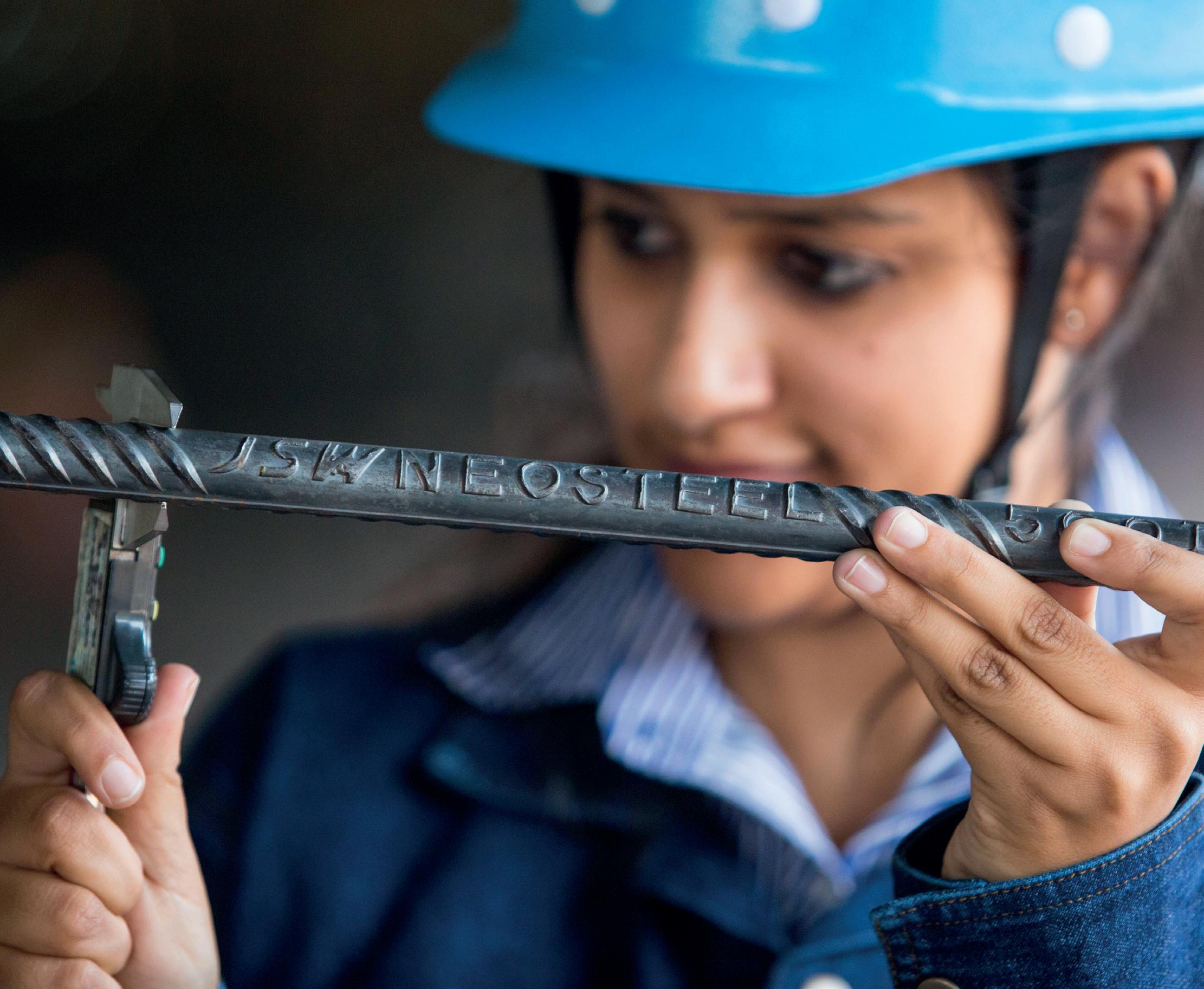
‘Yesterday’ in the title refers to the 1980s and beyond, ‘Today’ includes reaction to the COVID-19 pandemic, while ‘Tomorrow’
does not get much of a look-in with just one example at the start of her career while 11 are at mature stages in their roles.
The author, Karin Lund, spent 30 years in sales in the steel industry before setting up her own publishing company. She had written three books before the present and has Vol II of ‘Women in Steel’ in preparation, to be published in early 2024. The idea to write a book on the careers of woman in the steel industry arose from being a delegate at the AISTech Annual Convention in May 2019 where she attended a session entitled ‘Women in Steel Roundtable’. Listening to the presentations, it struck her that many of the roles these women were occupying would not have been available to her when she first started work in the steel industry in 1976.
Each example has a dedicated chapter which takes the format of a brief history of their careers from high school to present day followed by a series of questions, many common to all, posed by the author when interviewing each candidate. Annoyingly, unexplained acronyms arrive in several instances, for example, BtoB could be
*Consulting editor, Steel Times International and a member of the Historical Metallurgy Society


BOOK REVIEW 62 www.steeltimesint.com Digital Edition - February 2023
business-to-business or buyer-to-buyer; P&L is evidently profit and loss but what about RFP or a CYA e-mail?
With the exception of a recent recruit, six of the women are chairman, president or CEO (or hold all three posts) of a company, three are managers of business units, and two own their own companies.
It is notable how many were influenced by their father’s job, some in the steel industry, while others were often in engineering-related occupations. Also, how most balanced family life with the responsibilities of bringing up children with a demanding position at work. One exception preferred her dog to having children, but considered the employees she was responsible for ‘as her children’. This latter feeling of responsibility for the welfare of employees was common throughout many of the women interviewed. Most also put job satisfaction in advance of renumeration provided they were receiving equal pay to a man in an equivalent role. One exception is a trader who states ‘making money’ was her prime driver, and such was the cut-throat nature of the trading business in the 80s and 90s, it was this attitude that gained her respect in a male-dominated industry.

Even when in office-based jobs, each of the women are happy to spend time in the plant areas they are responsible for and have gained the respect of the shop-floor workers – one helped by bringing in some home baking, this sparking competition among male workers who brought in their own culinary creations to compete.
At times, it can be challenging for the reader to work out the timeline of a person’s career as key dates are either absent or provided much later in the chapter. In some cases, it is ambiguous as to whether they remain in a particular post or with a particular company. However, in the latter case, useful current information is provided on the change of ownership of companies. In addition, at the end of each chapter, there is a brief resume of the present activities of the company the person is representing, often with a web link for further information.
The series of questions Karin poses include ‘did you ever have any issues with anyone you worked with?’ In several examples, inappropriate advances were reported at various stages of a career which were inevitably fended off. Surprisingly the phrase ‘me too’, five years old when the
book was published, occurs just once.
The tendency by male colleagues of leaving a woman out when arranging some social event, is mentioned as hurtful. While this has become increasingly common following the ‘me too’ movement, it is attributed to a fear of an invite being misinterpreted.
How did you cope with COVID-19? A question common to all, was largely answered by allowing people to work from home wherever possible, but, with some, included job training via on-line talks. Generally eight questions are posed which often elucidated a number of ‘pearls of wisdom’ such as ‘‘If you want something said, ask a man, if you want something done ask a woman’’, attributed to the late UK premier, Margaret Thatcher – a cruel irony in view of the recent resignation of the UK’s prime minister, Liz Truss, who is said to have modelled herself on Thatcher, after a little more than 50 days in office in October 2022. ‘‘Don’t let a problem fester. Address it right away before it gets worst’’, coupled with ‘own up to your mistakes’, was a binary pearl. In the case of a secondgeneration immigrant from Jamaica, VP at large for the United Steel Workers Union, fearing her reception when representing the union at an important meeting, she was advised: ‘‘it’s not about you it’s about what you having that position means for the union and for women like you’’. Questioning concluded with ‘how can the industry attract more women?’ The offer of studentships or interns in companies is a common reply, but the roles mostly suggested are desk-based jobs such as marketing, sales, buyers and
legal, with engineering added almost, it seems, as a concession. Attracting the interests of children at a young age through organisations such as ‘Science Quests’ and ‘Junior Achievement’ are ways the US can develop an interest in what has, in the past, been considered a ‘rust belt’ industry. Such organisations are needed to persuade children, and their parents, that today steel is a dynamic industry striving for sustainability and vital to produce the infrastructure of a greener world.
The role of a ‘champion’ or mentor – generally a man – to help progress is frequently stressed as is the need to retire off ‘male dinosaurs’ who see no role for a woman at work other than the ‘typing pool’. The need for self confidence comes through strongly to take on a difficult task, and to learn should failure be the consequence. Also, to challenge a manager who takes a task away when nearing successful completion to give to ‘a more experienced’ man.
Karin’s book helps male workers appreciate the pitfalls that males frequently fall into when working with female colleagues and to appreciate the dedication of some of the women who altruistically keep their sections running. A minority of the examples chosen sadly show some egotism, although promoting yourself is recognised as an important means of progression.
I look forward to Volume II in the anticipation of a greater geographic spread and, hopefully, rather more examples of women in technical roles. Possibly a list of dos and don’ts for men would provide a useful appendix in the next volume. �
Volume I’ by Karin J Lund
G-Power Global Publishing 2022
ISBN 978-1-949955-06-4
(paperback) price US$28.95, ISBN 978-1-949955-07-1
Kindle eBook US$7.99 from Amazon.
63 www.steeltimesint.com Digital Edition - February 2023 BOOK REVIEW
‘Woman in Steel Woman of Steel Yesterday, Today and Tomorrow
CONNECTING THE INTERNATIONAL STEEL INDUSTRY




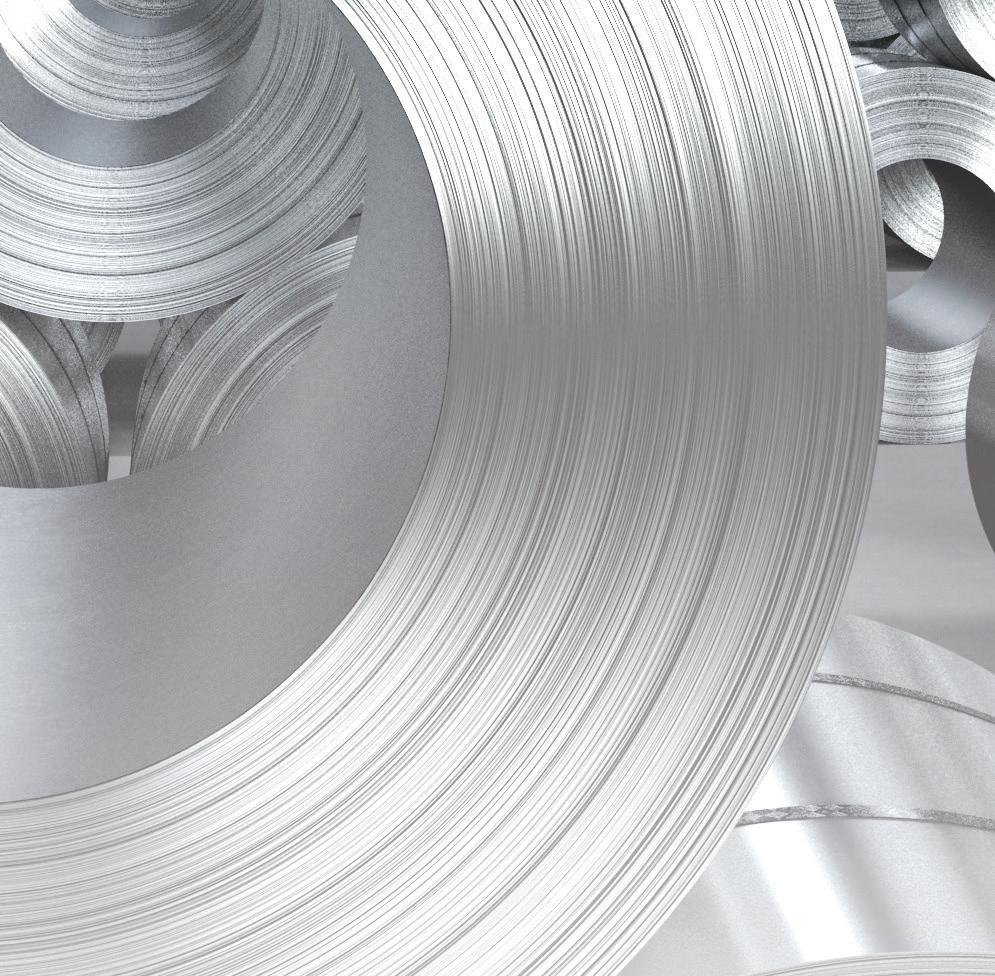

MAGAZINE DIRECTORY


The Steel Times International Directory is the essential guide to steel manufacturers, producers, suppliers of plant equipment and services to the steel industry. Order your copy priced from £100 or FREE for paid subscribers
Packed with information on the steel industry and continually updated with news for steel professionals, steeltimesint.com also features special articles and interviews with leading industry figures.










A round-up of the top news stories is also sent to more than 8,500 industry professionals each week. You can register online to receive the weekly newsletter and keep up-to-date with the latest news from across the steel manufacturing industry. www.steeltimesint.com/e-newsletter


1866 WWW.STEELTIMESINT.COM
Since www.steeltimesint.com March Vol.42 No2 FUTURE STEEL FORUM 2018 CONFERENCE REPORT PERSPECTIVES TUBE, WIRE ROD AND PIPE Industry 4.0 and the steel industry go to 50 now! Digitalisation under the microscope at Danieli’s Innovaction conference Edgar Rayner of LTI-Metaltech answers our questions The latest developments in the tube, rod and steel pipe markets STEEL TIMES INTERNATIONAL Vol.42 BUSINESS ETHICS 4.0 @STEEL INDUSTRY march.indd TECHNOLOGIES, INC. A GLOBAL STRATEGIC ALLIANCE o ering: TECHNOLOGIES, INC. A GLOBAL STRATEGIC ALLIANCE o ering: www.steeltimesint.com STEEL TIMES INTERNATIONAL DIRECTORY 2022 DIRECTORY 2022 Sinc 1866
Steel
Times International is the key publication for the steel market, reporting on iron and steel making issues from all corners of the globe.
@SteelTimesInt
WEB WEEKLY E-NEWSLETTER






































































































































































































































































































































